Australian
and international
exploratory
performance and
media arts
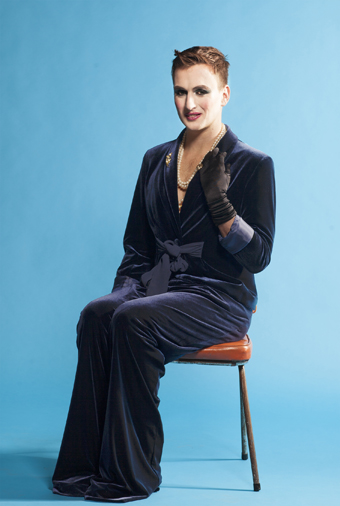
Ash Flanders, Little Mercy
photo Mark Rogers
Ash Flanders, Little Mercy
IN HER ESSENTIAL STUDY OF THE SEXUAL POLITICS OF HOLLYWOOD HORROR, MEN, WOMEN AND CHAINSAWS (1992), THEORIST CAROL J CLOVER ARGUES THAT THE ‘EVIL CHILD’ SUBGENRE—THINK THE EXORCIST, THE OMEN, ROSEMARY’S BABY—IS DRIVEN BY A KIND OF DIALECTIC OF GENDER.
On one side we have the monstrous feminine, hysterical and uncontainable, and on the other a masculinity whose coldness and rigidity is just as problematic. Resolution can only occur when some synthesis of the two is achieved—the patriarch who learns to ‘open up’ and find in himself two sexes symbolically merged into one.
It’s a complex thesis that clearly lends itself to Little Mercy by Melbourne’s Sisters Grimm, soon to open at Sydney Theatre Company’s Wharf 2. The horror-comedy queers the evil child narrative in all directions—here the diabolical eight-year-old is played by a woman in her 70s, her terrified mother by a man, and the genre’s own tropes are stretched to breaking point.
But Clover overlooks an important pleasure that distinguishes the figure of the evil child in horror cinema: “it’s one of those rare occasions where the audience actually wants the bad thing to win,” says Ash Flanders, one half of the Sisters. “Isn’t it just like the id? Wouldn’t we all be killing people for their shoes if there wasn’t a law against it? In a perfect world where you could do what you wanted, I don’t know how happy that world would be. Maybe it would be really sick.”
“Children are pure id,” says his collaborator Declan Greene. “They really do represent this pre-socialised hunger. Watching evil child films is just watching a version of that which is untameable. There’s something perverse and wonderful about that.”
Little Mercy takes those sublimated desires and amplifies them—both horror and comedy are modes of excess, which allows the production to stay true to its generic referents while also seeing how far they can be pushed.
“One of the biggest tropes of the genre is that only the mother sees what’s going wrong and no one believes her,” says Flanders. “So this idea that this child is clearly an older woman but no one believes that there could ever be anything wrong with her, it’s that classic thing where you put a grenade in like this and it changes everything. At the same time you’ve got two men playing women. It’s clear that this is a world that’s not trying to make logical sense. It’s playing with form, exploiting these stories.”
The pair talk about the ‘cracks’ that such devices reveal in their own narrative, and how the company’s goal has long been one of finding such points of rupture within generic moulds. But the source of such a method is itself now a problem.
“A very important thing that has defined our practice has been poverty,” says Greene. “What we do is try to write narratives that we subject to pressure, and that pressure comes from the inadequate resources that we’ve managed to marshall to execute a much grander vision. The problem with trying to do a theatre show with a company like STC is that all of a sudden your resources are a lot better. You can’t just pretend you don’t have money when you’re at the STC.”
Sisters Grimm have long been Melbourne theatre’s own evil children. “We had our early shows where we’d make ourselves vomit on stage or perform sex acts, and you have to do it when you’re a bit younger,” says Greene, “when you have to ‘find your voice’ by spewing on each other.” But, says Flanders, “Doing a show in a car park with a bunch of cool theatre friends also feels safe in a way, too. It has a touch of preaching to the choir.”
In addition to Little Mercy at STC, a new Sisters work will premiere at the Melbourne Theatre Company this year. But the pair aren’t interested in playing the outrageous kids trying to shock the big theatre crowds with their edgy material. “It’s important that we’re breaking our own rules, not theirs, says Greene, “that we’re creating a world with very clear and distinct rules and then upending those.”
“It is about breaking your own rules, rather than trying to get some rise out of the audience,” says Flanders. “That almost feels falser to me. That feels too controlled. I’d rather set up a world and have that crumble in front of you.”
Sydney Theatre Company, Little Mercy by Sisters Grimm, creators Ash Flanders, Declan Greene, Wharf 2, March 7-24, www.sydneytheatre.com.au
RealTime issue #113 Feb-March 2013 pg. 32
© John Bailey; for permission to reproduce apply to realtime@realtimearts.net
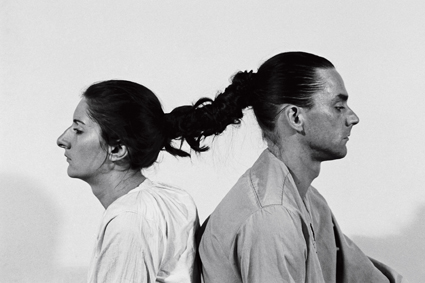
Relation in Time, Ulay/Abramovic, 1977; Marina Abramovic: The Artist is Present, images courtesy of Madman, © 2012 Show of Force LLC and Mudpuppy Films Inc. All Rights Reserved
I FIRST ENCOUNTERED THE WORK OF MARINA ABRAMOVIC IN THE EARLY 1980S WHEN I BOUGHT A COPY OF RELATION WORK AND DETOUR, AN ACCOUNT OF ABRAMOVIC’S WORK WITH HER PERFORMANCE AND THEN LIFE PARTNER ULAY. AT THE TIME, KEITH GALLASCH AND I WERE BEGINNING TO CREATE A SERIES OF PERFORMANCES FOR OPEN CITY BASED ON OUR OWN RELATIONSHIP THOUGH WE HAD NO AMBITIONS TO MATCH THE INTENSITY OF APPROACH OF THESE TWO.
relation in time (1977)
We are sitting back to back, tied together by our hair without any movement. (16 hours) Then the audience come in. (17 hours)
In the documentary The Artist is Present by Matthew Akers and Jeff Dupré we accompany Abramovic in the preparations for her retrospective at MoMA in the winter of 2010. She separated from Ulay in 1988 and it appears they haven’t met for some time. The film moves between arrangements for the exhibition and Abramovic’s live performance, which will be part of it. Each day of the show’s three-month duration, Abramovic, seated on a wooden chair, will face individual members of the public. “The hardest thing to do is something close to nothing. It demands all of you,” she says.
Documentation of performance art works is necessarily problematic—how to represent the ephemeral, recast the uniquely personal, preserve the live moment?
imponderabilia (1977)
We are standing naked in the main entrance of the Museum, facing each other. The public entering the Museum have to pass sideways through the small space. Each person passing has to choose which one of us to face. (90 minutes).
We see Marina nervously awaiting the arrival of the 30 young artists who have been chosen to ‘re-perform’ some of the seminal Abramovic/Ulay works. They will be at Marina’s home in Hudson Valley for three days—fasting, living in silence, no phones—all to help them empty themselves, to slow down. They have three months to perform and will have to create their own ‘charismatic space’—to be ‘present.’
Later, watching these young bodies in the gallery standing in for the weathered frames of the artists who had conceived these actions, lived the difficult lives that they reflected, it’s hard to see them as anything other than representations in another time. Naked bodies in the museum, however, have a way of attracting attention—though not necessarily the sort you might seek. Fox News’ “America Live” alerts its audience to the audacious Abramovic as “some Yugoslavian-born provocateur.”
For an artist who creates such intense works, Abramovic projects a cool bemusement in her everyday dealings with people. She cheekily admonishes the catalogue essayist with: “But you haven’t asked me ‘Why is this art?’” She’s justifiably annoyed at her status, “still alternative” after 40 years of work. “It takes such a long time to be taken seriously!” Then again, a retrospective at MoMA is not to be sneezed at and in Givenchy’s Spring campaign last year was that Marina’s visage up there next to Kate Moss?
art and life with ulay
Intercut with preparations for the retrospective and for her performance are filmed sequences and still photographs of Abramovic’s solo works and those she performed with Ulay.
These, together with the reunion with Ulay for the show, provide some of the film’s most powerful and poignant moments. When he’s told what she’s planning for her live performance, Ulay says “Wow! I have nothing more to say. Respect.” He recalls Marina’s stamina. In one incarnation of their work Nightsea Crossing (1981) they sat inactive, fasting and silent. He exited after 16 days when he’d lost 24lbs in weight and was near collapse. Marina remained at the table.
We gain some insight into the source of this strength in Abramovic’s recall of a childhood in which her parents, national heroes from Tito’s time, trained her to be a little soldier. The only love in her life came from her grandmother who also provided spiritual guidance. She declares, “The artist must be a warrior, a shaman, must conquer the self and its weaknesses.”
Ulay, having swapped the rigours of performance for academe says, “I look like a worker but I do much less work than Marina.” Their famous walk (The Lovers, 1988) from opposite ends of the Great Wall of China marked the end of the relationship. “We were burning up,” says Ulay. “The better the performances the worse the relationship became.”
After the split, Marina headed in a new direction, which Ulay defines as more “theatrical and formalist.” After all those years of deprivation, she developed a taste for high fashion and fame, creating a work in which she said goodbye to extremes, ending with “Bye Bye, Ulay.”
the performance
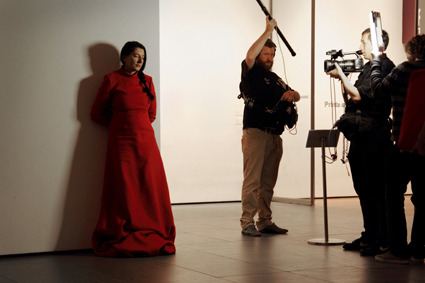
Marina Abramovic at MoMA, 2010, Marina Abramovic: The Artist is Present, images courtesy of Madman, © 2012 Show of Force LLC and Mudpuppy Films Inc. All Rights Reserved
Back in the present, preparations for the performance urgently proceed. There’s a brief flirtation with the idea of collaborating with an illusionist who munches a wine glass as part of his pitch (rejected), and scenes of an ailing Marina tucked up in a bed of red sheets calling on the healing properties of blood oranges.
And finally we witness the performance itself as one at a time, thousands of people queue, then enter the charmed space to sit before The Artist. Some return Abramovic’s unaffected gaze while others appear desperate to convey something deeper. Many smile, some weep. “So many people have so much pain,” says Marina. Those who get short shrift are the ones who try to turn the moment into their own artwork—one tries to demonstrate her ‘vulnerability’ by removing her clothes. Another reveals a hidden mirror behind an elaborate mask. “I’m the mirror of their own self,” says Marina.
The camera is fascinated with faces including Abramovic’s, which occasionally admits a smile and some tears (for Ulay). The waiting throng watches silently from the perimeter. The guards are on red alert for unheralded interventions. Museum announcements occasionally pierce the silence. The encounter appears meaningful to the participants—more mysterious for the film viewer. Sometimes it takes on the appearance of religious ritual. Abramovic appears nun-like in one of three heavy woollen dresses (one red, one white, one blue). At other times, it feels just a bit indulgent, as if the provocateur, tired of waiting, has designed her own form of devotion. I guess, as they say, you had to be there.
At the end of each session, however, the ‘work’ of this art is powerfully manifest in the toll it takes on the body of the performer. The pain of an immobilised body must be massaged, bathed and exercised away each day to prepare for the next. Abramovic is 63 when the film is made and finally admits, “There’s a limit, even for me.” But when it’s suggested that she cut short the performance, she will not hear of it. She may be marking the 736 hours off on the wall but the show must go on.
As the film and the retrospective draw to a close there’s a lot of summing up, a lot of it about time and how we are caught in it and how Marina Abramovic aims to slow everything down, to bring the performer and the audience into the same state of consciousness of the here and now.
In 106 minutes Akers and Dupré expose for the viewer something of the emotional, physical and intellectual demands inherent in mounting an exhibition and performance that deal in the power of the present. In the process they also offer insight into the life’s work of a remarkable artist.
Marina Abramovic: The Artist is Present (2012), co-directors Matthew Akers, Jeff Dupré, cinematography Matthew Akers, editors Jim Hession, E. Donna Shepherd, original music Nathan Halpern. Distributed in Australia by Madman Entertainment.
RealTime issue #113 Feb-March 2013 pg. 18
© Virginia Baxter; for permission to reproduce apply to realtime@realtimearts.net
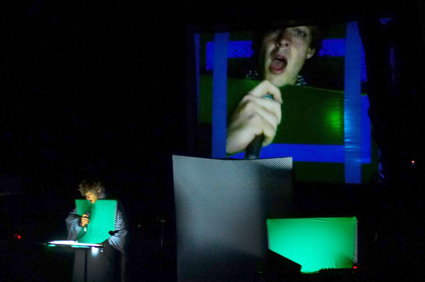
Peter Burr, Special Effect, courtesy the artist
NEW YORK-BASED ARTIST PETER BURR IS FAMED FOR HIS WILDLY CARNIVAL-ESQUE PERFORMANCES AS HALF OF POPULAR ‘TRICK-OR-TREAT-TRANCE’ DIGITAL MUSIC/ANIMATION DUO HOOLIGANSHIP AND FOR CO-FOUNDING THE UNDERGROUND ANIMATION COLLECTIVE CARTUNE XPREZ.
Burr’s new work, Special Effect sees him branch out into solo audiovisual performance in the form of a live experimental television program, in which Burr presides over a succession of increasingly bizarre digital images, replete with the interruptive agenda of commercial breaks. Drawing on a surprising wellspring for its inspiration, Special Effect features Burr’s typically highly physical performance bent to more experimental ends, collaged into the action via green screen, as the master of a strange ceremony.
Tell me about the genesis for Special Effect—where did it come from?
I have a habit of incessantly drawing, somewhat aimlessly, in between large-scale projects. It calms me down. I’ve been in this rhythm for years. Last spring, after finishing my project Green | Red, I had just rewatched Stalker (Andrei Tarkovsky’s legendary 1979 sci-fi film) and found myself making drawings based on paused frames of the film. The specifics of the movie weren’t in those images, but some of the mood contours were—the figures, choreography and architecture. Something about this really gelled…and so I decided to explore them in four dimensions. Also, around this time, I was talking with a bunch of other video artists and animators and noticed there was a thread here that these artists were also inspired by—there’s been a serious Stalker wavelength growing fresh over the last few years. I found lots of personal resonances with this film…and so did others. So that’s really where the project comes from, how it was birthed.
The next stage was shooting in some abandoned sites?
Yes, I met up with a group of friends who were keen on exploring ruined/abandoned sites around New York. I started tagging along with them, borrowing friends’ cameras and shooting landscape footage—this eventually was integrated into the animated segments of Special Effect, in various forms. It turned into this self-propelling journey into the armpits of America, delving into our zones of exclusion to find my own story somewhere in the Stalker script.
Do you remember the first time you saw Stalker?
I first heard about the film as a resident artist at the Macdowell colony, the oldest artist colony in the States, in New Hampshire. I used to take pathless walks through the winter woods there and once a friend accompanied me and he was like, “This is just like being in Stalker.” At the time I hadn’t seen it but he meant the stillness and the thin trees and how you could hear your footsteps in the thick carpet of leaves left on the ground. His description of the film mesmerised me, but I never got around to watching it until about a year later when I was touring around Europe. I had a copy of it on my laptop and during an overnight trip from London to Antwerp I thought, “Let’s fire it up!” I remember getting into the station and having time to kill before I could find my host there and feeling grateful there were so many hours left in the film. It felt like this dreamy, endless drift through parallel worlds, perfect for my transient, half-awake state. Only my world was a bit drier—compared to the endless puddles and rain and splashing that is like a running joke through Stalker.
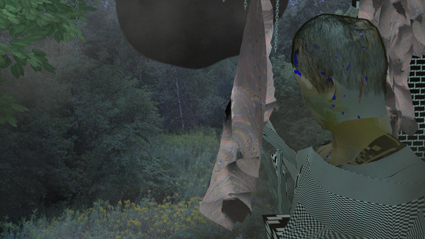
Peter Burr, Special Effect, courtesy the artist
The audience for Special Effect can see how you’ve responded to those bleak Tarkovskyan pans—but yours are really heavily effected. What are you trying to do with the motion graphics in this work?
I think a lot about transforming the thumbprint of images. How can this be done to icons of pop culture that, untransformed, propel us into nostalgic mental loops? How can I strip off the marks of specific software that read as emblems of their design? The signature ‘look’ of software is something I think about a lot. Each program wants to announce itself. But there are a million different paths in there to smear or shift the markings, to carve out something unique with the same tools that everyone’s using. I’m not into speaking with the voice of a generation or being the voice of a particular piece of software. I think I really work adversely to that.
With this whole project, there was an element of dealing with iconography, of Stalker. Dealing with tradition. But at the end of the day it’s not replicating. I’m trying to invent something new from it. Something that actually feels like its own thing. I wanted to work with some of the elements I admired from the film, like the Tarkovskyan pans, but let them be transformed. I was aiming to create a new feeling that’s rooted in my own feeling of the world just as much as it is rooted in this source. I guess…in creating a project that’s about ripping off the greatest film ever, I feel like it’s also important for me to push away from it.
Like you push away from demo-ing ‘high’ technology with the software thumbprint?
Yeah, I’m not interested in a display of the newest technology. Special Effect shares the load around—it’s a pretty tangled knot of high-end and low-end software. To me it’s important to obscure those distinctions in the work. It’s not about the newest, coolest thing. I like using crappy free technology too. Or if I’m using familiar software then it’s about misusing it and using it in weird combinations and configurations, ways that aren’t emblematic when you think about the software.
Is that why you’re interested in incorporating the live performance element?
It adds an angle of chaos. With this kind of motion graphics work it is so easy to get stuck in the structure of the computer process. I write a script, draw a storyboard, then execute the blueprints. But straightforward in this way, it lacks something. Adding layers of liveness to it all makes it feel more honest. There’s the effect of real bodies, this risk of everything falling apart, the lasers threatening to blind you…! It makes you watch it all very differently than you’d watch The Hobbit (3D or no-3D).
I know you watched a lot of cartoons as a child and that drew you into the world of animation; that sensibility permeates Cartune Xprez but is pared back, thinned out in Special Effect. What’s the relationship with TV in this work? Why structure it as a TV program?
With television, my references are all very different today than they were a decade ago. I don’t think I’m alone with this. I haven’t watched ‘television’ in years—the internet and my own art practice replaced that for me. This definitely creates space for me to play with the idea of television. It’s almost an imaginary object for me now. We’ve had this shift away from the fascist architecture of media—TV programming—into user-controlled, user-generated media. There’s no tolerance of boredom now and that really interests me. There’s certainly a confrontation with boredom in the show—it deals with Stalker, after all! I guess I’m trying to reconcile the slow, quiet, maybe confusing drifts with really short-attention-sapan-overload segments.
Of course, I grew up watching over eight hours of TV a day until I went off to college, so there’s also a very real imprint of its effects on my imagination. I don’t know exactly why, but it just feels intuitive to make fractured, commercial-interrupted, channel-surfed work. My attention span is all out of whack.
I guess that’s informed my way of approaching things now. Special Effect isn’t ‘about TV’—I don’t even know what TV is any more. Like I said, it’s an imaginary system for me. Because I don’t watch TV but remember it—and especially commercial breaks—I’m like, “I haven’t seen one in a while, so let’s have one, and let’s make it fun!.” So it’s kind of like a late 70s vision of a dystopian future, looked back on through the lens of 80s and 90s TV, from the position of early 2013. If that makes sense.
Peter Burr, Special Effect, Brisbane, Melbourne, Meredith Music Festival, Adelaide, Dec 5-10, 2012; http://otherfilm.org/peter-burr-cartune-xprez/; Museum of Moving Image, NY, 18 Jan 18, 2013; www.peterburr.org
RealTime issue #113 Feb-March 2013 pg. 20
© Danni Zuvela; for permission to reproduce apply to realtime@realtimearts.net
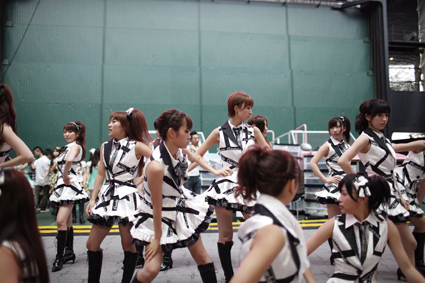
Documentary Of AKB48 Show Must Go On
© 2012 Aks Inc. / Toho Co., Ltd. / Akimoto Yasushi, Inc. / North River Inc. / Nhk Enterprises, Inc.
Documentary Of AKB48 Show Must Go On
BEFORE DISCUSSING DOCUMENTARY OF AKB48: SHOW MUST GO ON (2011) WHICH SCREENED IN THE 16TH JAPANESE FILM FESTIVAL ACROSS AUSTRALIA, HERE ARE SOME INTRODUCTORY POINTERS ABOUT THE JAPANESE POP GROUP, AKB48. THEY ARE A COLLECTION OF GIRL SINGERS COMPRISING THREE PRIMARY TEAMS OF 16, BASED AT A LIVE THEATRE FOR FANS IN AKIHABARA, FORMED IN 2006 BY EX-AIDORU (IDOL MUSIC C1980s) LYRICIST AND MANAGER YASUSHI AKIMOTO.
Their music is mostly a softened yet pneumatic Euro-disco à la Stock-Aitken-Waterman, designed to be uncontrollably memorable. The vocals come from a team’s 16 voices singing in unison, usually without harmony lines, generating a sports-like karaoke of kiddie chants. Between 2011-2012, AKB48 released 10 singles in Japan (population 127.5 million), each selling on average 1.2 million. (Between 2011-2012, Katy Perry released eight singles in Australia, population 22 million, each selling on average 0.14 million.)
But Pop Music in Japan is a different being. The Idol syndrome that first peaked in the 80s was based on idolatry, figurine worship and the rupturing imperfection of human amateurism, which was perceived to define the ‘idol’ as a shimmering deity in human form. (Only 40 years earlier, Japan collectively subscribed to the Emperor’s divinity.) Japanese Idol music employs crass electronic synthesism as an environmental context for highlighting human expression—hence the off-tune, over-emoted, unadorned voices of groups from Pink Lady and Onyanko Club to SMAP and Arashi.
The AKB48 documentary Show Must Go On is an exhausting ride into the maelstrom of Idol culture. On the surface it appears as yet another exposé of the ‘real world’ behind those ensnared by the machinations of show business. But Show Must Go On presents with uncompromising clarity what is within the surface of Japanese Idol culture.
A number of narrative incidents shape the documentary’s trajectory across the year 2011. The major one is the Great Tohoku Earthquake and resulting tsunami (referred to in Japan as 3/11). We see six members from the A-Team travelling by bus into Otsuchi, Iwate in June. They stare in silence into the de-spatialised devastation we can also see through the bus windows. The members on the bus silently try to read what was once a recognisable landscape.
As they descend, the six young women move differently: they now resemble figurines, exuding the subtle power of Japanese women engaged in formal ritual. The stilted slowness of their bodies and their almost indiscernible head-bowing are signs not of obsequiousness, but regality and divinity, here performed through the minutiae of bodily control as if they are no mere mortals.
They straddle the makeshift stage and formally introduce themselves and their “stricken area support tour.” Suddenly they transform, leaping into synchronised callisthenic moves, singing atop the blaring backing track of Heavy Rotation (2010). Dressed not in their usual glitzy uniforms, which seem borrowed from the mystical princess sub-genre of anime like My-HiME (2005-8), they wear white tour T-shirts, gym pants and trainers. The location sound is similarly raw: it accentuates AKB48’s aural presence as frail human vocals enmeshed in a dizzying multiphonic synthesis.
At one point, the camera hand-tracks behind a gaggle of Japan Self Defence Force members corralled as relief workers, dressed in military garb and patiently listening. It’s the first of many moments in the documentary’s audio-vision where AKB48’s music—performed live or played in a public space—seems dislocated from its surroundings.
Yet at that very moment, it also evidences the means by which the music fuses with its surroundings. Because when such ‘inappropriate’ music occupies a social realm—here, tacky disco pop amidst the ruined townships post-3/11—a reality effect seeps back into the music to intone it with opposite sentiments. In this instance, Heavy Rotation begins to sound less sprightly and bouncy and more drained and hollow.
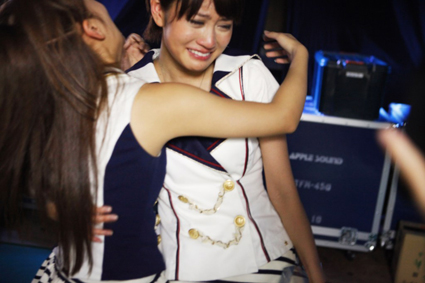
Documentary Of AKB48 Show Must Go On
© 2012 Aks Inc. / Toho Co., Ltd. / Akimoto Yasushi, Inc. / North River Inc. / Nhk Enterprises, Inc.
Documentary Of AKB48 Show Must Go On
Another major narrative incident is the AKB48 22nd Single Election held June 9 at the Budokan in Tokyo. Having spent three months in Tokyo shortly after 3/11, much of what is in Show Must Go On brings back memories for me of the transformation and reconstruction which frenetically hit Japan over that time. The AKB48 Election was accorded an amount of media attention proportionate to the drastic re-shuffling of the Democratic Party of Japan’s cabinet under Naoto Kan during the post-3/11 crisis. Images of besuited old men and uniformed young girls each engaged in popularity polling were everywhere.
The AKB48 Single Elections manifest how ‘popularity’ can govern with chaotic yet ultimate power in Pop Music, as team members who get to actually record each new single are selected by their huge Japanese fan base (they sold out the Budokan). How better to ensure attraction to AKB48 than by having one actively dislike certain members in order to like others. That’s how the Single Elections have unfolded since 2009, and Show Must Go On unflinchingly reveals the emotional exhaustion and terrorising debilitation its members wilfully suffer.
When Yui Yokoyama achieves 19th place in Team B, she appears onstage, hyperventilating from the trauma of succeeding. We quickly cut to a later interview where she’s mildly laughing at it herself, querying what she felt. It’s the first of the documentary’s onslaught of such para-bipolar incidents which are performed with an embedded schizophrenic calm typical of Japanese emoting and self-presentation.
When the dramatic long-winded announcement of the first place is blared over the Budokan PA, we see No.1 contender Atsuko Maeda bobbing in her seat like an epileptic. Here is a star, suffering in public, about to succeed, filmed by multiple cameras, surrounded by her colleagues—but everything and everyone around her treats her as a non-existent entity. Show Must Go On documents such instances of Japanese behavioural customs, proving AKB48 to be a simulacrum of Japanese endeavour: completely fabricated, excessively exploitative, undeniably fictitious, yet absolutely affecting.
Backstage after the announcement, we focus on Yoko Oshima, this time demoted to second place. The onstage male announcer’s barking drowns her, indifferent to her emotional collapse. Then an AKB48 ballad blares through the PA: it’s like sonic salt poured onto her gaping wounds. She stands with her back to us, moored in the bowels of the Budokan’s subterranean infrastructure, facing an air-conditioning duct. In the ugly miasma of lo-light video grain, cables and ducting swirl around her like a deadly forest. It’s a chilling anime icon—the mystical schoolgirl princess ensnared in a cruel environment. The camera zooms in slowly on her shadowy back: a sublime moment in Pop Music audio-vision: a portrait of the dark self away from Pop’s photosynthetic brightness.
–
RealTime issue #113 Feb-March 2013 pg. 21
© Philip Brophy; for permission to reproduce apply to realtime@realtimearts.net
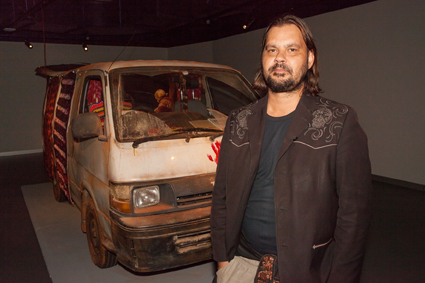
Thornton in front of Mother Courage
source ACMI & Mark Gambino, courtesy of the artist and Scarlett Pictures
Thornton in front of Mother Courage
“IN THE LAST 30 YEARS INDIGENOUS CINEMA, ART, EVERYTHING, HAS BEEN MIND-BOGGLINGLY EXPLODING IN ALL DIFFERENT DIRECTIONS AND DIFFERENT WAYS. IT’S A VERY EXCITING TIME—WE’RE CREATING A NEW WORLD.” WARWICK THORNTON’S ENTHUSIASM IS INFECTIOUS, AND DOESN’T SEEM DAMPENED BY HOURS SPENT SETTING UP HIS NEW INSTALLATION, MOTHER COURAGE, IN THE BOWELS OF THE AUSTRALIAN CENTRE FOR THE MOVING IMAGE.
Not content with having written and directed one of the greatest Australian features of recent decades—Samson and Delilah (2009)—the Alice Springs filmmaker is pushing into new artistic territory. “I wanted to create stuff where I could go off and do it myself, where I don’t need 100 crew and $3 million,” Thornton explains when asked about his push into the visual arts. “I shoot work for other people in between writing and getting my own films up, but it still wasn’t enough to vent creativity, to vent ideas. You have 10 ideas a day and five years down the track one of them might arise as a film. So it grew out of that—a frustration with having lots of wonderful ideas and not enough outlets.”
Mother Courage is Thornton’s second installation—his first foray into gallery-based 3D video work was Stranded (RT102) for the Adelaide Film Festival in 2011. That piece saw Thornton tied to a neon cross, suspended over the Western Desert. Mother Courage retains the setting, but focuses on an elderly Indigenous painter (played by real life artist Grace Rubuntja) reminiscent of Delilah’s exploited Nana in Thornton’s debut feature.
The first thing we see upon entering the darkened gallery space is a battered van, softly spotlit in the middle of the room. Red dust coats the bumper and tyres, bespeaking long drives across Australia’s centre, while paintings hang from the van’s sides. A newspaper wedged against the dirty windscreen features a headline about troubled Top End Aboriginal communities, while a red handprint on the van’s front speaks of Indigenous ownership. Then, suddenly, we perceive movement in the back of the van and realise there is an elderly woman inside, painting.
Closer inspection reveals the action is playing out on a life-sized video screen inside the van, but the clarity of the footage conveys a disconcerting impression of real presence. This is only reinforced when we walk around the back of the van to find the image’s reverse playing inside the open rear door. From here the elderly painter faces us, as she carefully applies brush strokes to her work, while a young boy (Elijah Button) sits beside her playing air guitar to the sounds of the Green Bush country music show blaring from a radio.
Thornton’s films have always spoken to each other through recurring characters and overlapping concerns, and Mother Courage continues this intertextual dialogue. “You can learn more about Mother Courage, and the reason she’s in Melbourne and not on her homelands painting, by watching Green Bush,” says Thornton, referring to his classic 2005 short about a late-night radio DJ in a remote desert community. “That film talks about the violence and the vicious cycles of community life. I can’t explain everything, but if you create those small connections with what you’ve done before or what you might be doing next, it becomes a more immersive journey.”
Thornton’s work also deliberately evokes wider connections with contemporary Indigenous politics and culture—an explosion of activism and creativity that has barely registered with many non-indigenous Australians. Green Bush, for example, prominently features Gary Foley’s speech on Indigenous rights from a Sydney stage during a Clash concert in 1982. Samson and Delilah tips a hat to Bart Willoughby and the soundtrack to Wrong Side of the Road (1981) when a homeless man sings the anthemic “We Have Survived” beneath a highway overpass. “They are key things for most Indigenous people and they’re unique. And a lot of non-indigenous people haven’t heard that song or that speech, and then it’s like, ‘Wow, Gary Foley spoke at a Clash concert?’ It’s great.”
Thornton himself was similarly led to Bertolt Brecht via the circuitous route of John Walter’s documentary Theatre of War (2008), about the staging of a production of the playwright’s classic Mother Courage and Her Children in New York. Inspired by the film, Thornton sought out the original play and was immediately struck by parallels between Mother Courage’s travails as an itinerant trader during Europe’s Thirty Years’ War and the plight of Indigenous communities in the Western Desert. “There are some amazing correlations between this lady and what’s happening in the desert at the moment with Indigenous people, having to move off their country to follow certain elements to be able to survive,” Thornton observes ruefully. “I’m using Brecht’s back story in a sense, so anybody with any knowledge of what happened to his Mother Courage can align it with this character.”
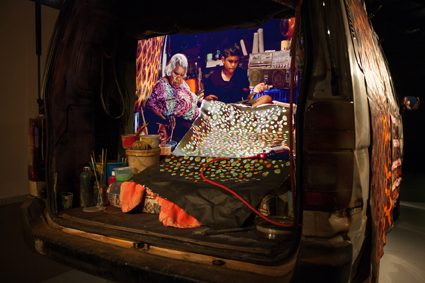
Warwick Thornton, Mother Courage (detail), 2012
source ACMI & Mark Gambino, courtesy of the artist and Scarlett Pictures
Warwick Thornton, Mother Courage (detail), 2012
Thornton’s Mother Courage occasionally pauses to hold up her painting to viewers, as if plying for passing trade. Other paintings are hung on the sides of her van, making the vehicle a portable one-woman commercial gallery. The installation was first unveiled at last year’s dOCUMENTA in Kassel, Germany, where the vehicle was often parked beside crowds queuing for various exhibitions, making the painter’s position vis-à-vis the international art market clear. “It’s like in Samson and Delilah—the artist gets 100 bucks, and the art is then sold on for $10,000,” says Thornton of the rampant exploitation of Indigenous painters.
As in Brecht’s Mother Courage, however, Thornton has left his character’s situation and actions open to multiple readings. “In a lot of the stuff I make, I try to not dictate a right or wrong, a yes or no. Some people will walk in there and feel really passionate and sad about this woman—she’s confined in this van, and doesn’t really do anything but paint. And the kid seems really bored. Another person will be really empowered by the idea that this woman has created a form of self determination and gotten out of this vicious cycle of some communities—this sister’s doing it for herself, you know, and she’s gone straight to the source of what she knows, which is art.”
However we respond to the character’s situation, there is a painful sadness and sense of dispossession underlying the scene evoked by Thornton. While traditional dot paintings hang on one side of the van, on the other is an almost childlike image showing giant black blocks labelled “grog” sitting atop the desert sands as numerous black stick figures fall about around them. “You’re a captive audience,” we hear DJ Kenny say over the radio to his prison listeners, and the bitterness in his voice is only slightly mollified by wry humour. Yet there is also hope in Mother Courage’s calm, persistent process of creation—a hope that resides in the ongoing resilience of a culture that has survived, despite everything.
For all his social concerns, it is Warwick Thornton’s ability to sympathetically capture the hopes, possibilities and foibles of his characters that makes his work so affecting. “You always draw upon key emotions, you know?” Thornton explains, stripping his approach down to its essence. “It all boils down to good storytelling—that’s what I’ve found.” When asked whether he intends to continue with installation work, he replies, “I love all forms, so I just flow with it. It’s about the idea. You hear an amazing, real story and you think should this be a doco, a feature, a video installation or a collection of photographs? The story will tell you how it should be made.” With another feature and television series on the way, Thornton’s flow of stories—in all different directions and different ways—shows no sign of abating.
Mother Courage, installation, writer-director Warwick Thornton, actors Grace Rubuntja, Elijah Button, commissioned by ACMI and dOCUMENTA (13); Australian Centre for the Moving Image, Melbourne, Feb 5-June 23
RealTime issue #113 Feb-March 2013 pg. 22
© Dan Edwards; for permission to reproduce apply to realtime@realtimearts.net
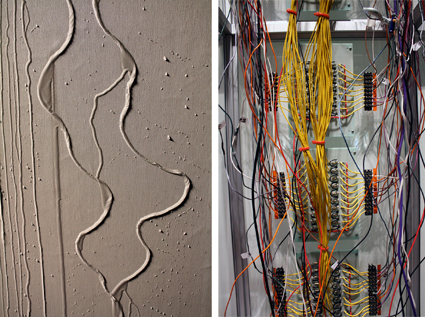
Colleen Ludwig, details of installation Cutaneous Habitat: Shiver, ISEA 2012
images courtesy of the artist
Colleen Ludwig, details of installation Cutaneous Habitat: Shiver, ISEA 2012
ISEA 2012 ARTISTIC DIRECTOR ANDREA POLLI’S CURATORIAL CONCEPT FOR MACHINE WILDERNESS: RE-ENVISIONING ART, TECHNOLOGY AND NATURE TOOK A STRONG ECO-POLITICAL APPROACH TO DIGITAL INTERACTIONS WITH THE ENVIRONMENT. ISEA 2012 IN ALBUQUERQUE, NEW MEXICO MEDIATED BETWEEN THESE INTERSECTING WORLDS FROM CREATIVE RESIDENCIES AT THE LOS ALAMOS NATIONAL LAB AND SETI (SEARCH FOR EXTRA TERRESTRIAL INTELLIGENCE) TO EVENTS AT THE INSTITUTE OF AMERICAN INDIAN ARTS IN SANTA FE AND THE NATIONAL HISPANIC CULTURAL CENTRE IN ALBUQUERQUE.
While the ISEA symposium began in 1988 in Utrecht and Groningen with a focus on computer-generated art, such as fractal graphics and emergent ‘net art,’ the artworks and presentations now extend into the diverse forms of ‘post-media’ practice; from fusions of performance and animation to sound walks. The focus of this review is neither the physical computing nor the augmented reality and QR codes [matrix barcodes. Eds] that may represent key typologies within ISEA artworks in 2012. Rather, in the sometimes bewildering density of artworks and parallel conference sessions, the presence and absence of water became a connecting thread for this writer.
te urutahi waikerepuru, new zealand
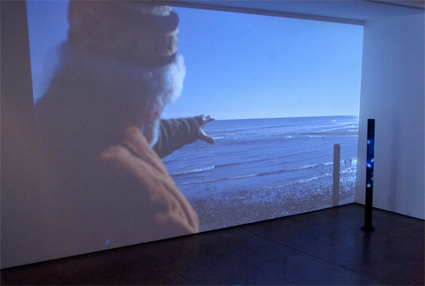
Te Uratahi Waikerepuru, Pou Hihiri
image courtesy the artists
Te Uratahi Waikerepuru, Pou Hihiri
A Maori art project conveying the importance of wai (water) from Aotearoa/New Zealand to ISEA in New Mexico catalysed this interest on my part. As part of ISEA at 516 Arts (a gallery known for its pursuit of radical environmental and social art projects), Maori artist Te Urutahi Waikerepuru installed the work Pou Hihiri, an electrified totem. The work was part of the collaborative exhibit Te Hunga Wai Tapu curated by Ian Clothier. In a well-attended conference workshop, Te Urutahi and her father, kaumatua (elder) Dr Te Huirangi Waikerepuru spoke on the importance of wai in Maori cosmology.
Water is a key element in the set of relations and flows that bind us to the environment. Te Urutahi’s Pou Hihiri represents the ‘becoming of the universe’ and the rise of the matriarchal principle. The work flickers with potentiality, represented by an array of lights within a wooden pole figure. Hihiri describes the power for change in hydro energy, kinetic energy, molecular energy and lightning. Te Urutahi positions Pou Hihiri as the first in a series of forms that will represent “the birth/physical manifestation of the universal elements of natural lore according to Matauranga Maori concepts.” Maori knowledge and science converge in the concept for the artwork.
While ISEA was taking place, a multi-tribal hui (meeting) in New Zealand overwhelmingly backed a resolution calling on the New Zealand government to halt the sale of Mighty River power company shares. At ISEA, the ‘wai’ water workshop, like the contentious hui in Aotearoa, aimed to produce a framework for recognising Maori proprietary rights and interests and spiritual ties with water. Dr Te Huirangi’s disarming question of how one can ever sell air or water to corporate interests, or interrupt the natural ‘flow’ of water as a complex system, resonated with the international audience.
william wilson, usa
Maori campaigns against continuing colonial attempts to undermine their ‘mana’ or sovereignty over water are echoed in the indigenous struggles in South-West America. Navajo artist William Wilson related how Arizona Senator John McCain advocated the construction of municipal water pipelines in exchange for waiving indigenous rights to water. Vehement opposition by Navajo/Hopi campaigners defeated the bill in February 2012, lending hope to the Maori struggle. Like Pou Hihiri, Wilson’s collaborative artwork eyeDazzler 1 (2012) for ISEA connects ancient cultures to contemporary mythologies about technology by weaving a QR code into a traditional textile pattern.
seoungho cho, korea
Water was represented as both a politically fraught site and a meditative force in several works at the Albuquerque museum. Korean artist Seoungho Cho’s multiple video seascape Horizontal Intuition 14 (2012) momentarily alleviated my island-dweller’s anxiety about the distance from the ocean. A rhythmic abstraction was created by the waves of distant seas, scored with the coloured stripes of computer-generated glitches.
colleen ludwig, usa
Deeper into the museum I found a group of women from Albuquerque delighting in actual trickles of water around a highly plumbed, cabled and programmed structure. Colleen Ludwig’s (USA) interactive piece Cutaneous Habitat: Shiver (2012) was comically mechanical as switches clicked and released water in response to human presence. One woman commented, “maybe if we stand here long enough it will start to rain in Albuquerque.” Decreased rainfall as the climate shifts, the smaller than anticipated size of Albuquerque’s subterranean aquifer and their rising population constantly remind the inhabitants of the value of water. (See video footage here.)
marc böhlen, canada
During the lively ISEA Downtown Block Party participants were offered various combinations of mineral waters, mixed by a computer algorithm, from a mobile water station. Canadian artist Marc Böhlen’s WaterBar (2012) filtered water through mineral rocks from politically charged locations. The filtering rocks included quartz-filled granite from Inada in the Fukushima province, site of the 2011 nuclear meltdown; marble from Thassos, Greece “at the beginning and end of democracy;” and limestone from Jerusalem/Hebron, Israel, “source of eternal conflict and shared hopes.” (See video of WaterBar here)
joana moll, spain & heliodoro santos, mexico
The Rio Grande that separates New Mexico from border states is siphoned for irrigation from Colorado to Texas. During a conference break, I found the shallow, murky river amongst the willows and undergrowth behind a conference building at the National Hispanic Cultural Centre. The live-streamed video work The Texas Border (2011) by Joana Moll and Heliodoro Santos reveals the Rio Grande as a politicised body of water in the context of border crossings by illegal migrants from Mexico. A grid of 15 web cameras streaming live CCTV video documents people wading or boating across the river. The video is sourced from BlueServo, a citizen vigilante website designed to police the border through home webcams run by the Texas Border Sheriff’s coalition. The grainy shapes of those valiantly attempting to cross the river become moving points of light in the low resolution images, reinforcing the precarious existence of the cameras’ targets.
crossing water, becoming someone else
The national borders that cut through cultural-linguistic bonds were the focus of a key panel at the National Hispanic Cultural Centre. Veteran Cuban-American performer Coco Fusco and panelist Vicki Gaubeca, from New Mexico’s Regional Centre for border rights, situated the migrant body as the “ultimate frontier of technological colonisation.” Gaubeca outlined how Operation Streamline has doubled the number of US Border Control agents since 2003. Smart technologies such as cameras, sensors, six unmanned drones and 700 miles of fencing are used to police the border. The privatisation of prisons has resulted in the construction of massive centres for the detention of migrants, described by Gaubeca as a moneymaking venture. Fusco suggested that the US laws affecting migrants create new categories of people who are criminalised. Migrant imprisonment tears families apart, often detaining those with no criminal record. Fusco’s new work is concerned with migration via sea crossings from Cuba. She mused, “the moment when you lose connection with the land, the moment when you migrate, is the moment when you become somebody else.”
teri rueb & larry phan, usa
ISEA events extended beyond Albuquerque to exhibition sites around Santa Fe and Taos. Teri Rueb and Larry Phan’s (USA) location-specific sound walk No Places with Name: A Critical Acoustic Archaeology (2012) at the Institute of American Indian Arts (IAIA) was a resonant, multi-sensory experience. Fitted with headphones, we meandered in the desert heat along a trail dotted with cacti and wild flowers, listening to moving interviews from indigenous artists, anthropologists and geographers. One speaker related how a lost boy was found, clothes dry, miraculously transported to the other side of a dividing river. Silences in the audio walk signalled information held sacred and kept from outsiders.
laurie anderson, dirt day!
Without sustaining and valuing water resources all living beings are endangered; a stark fact made apparent by many of the digital artists who brought their work to New Mexico. Near the end of the conference, media artist Laurie Anderson performed her new work Dirt Day! at the Kimo Theatre. The performance spanned eco-politics, inter-species communication and Anderson’s continued fascination with the ways we receive and interpret language. With mesmerising rhetorical charm she mused that technological art has now moved beyond the instant gratification of speed to the attuning of our potential as “meaning-making machines.”
Although many artworks at ISEA 2012 still beeped, chirped or shook in response to human presence, the fairground attraction mode of early electronic art was often supplanted by wonder that could transmute into political reflection. An ecological approach to technology emerges in Machine Wilderness as a means to reveal, as philosopher Félix Guattari (1989) once observed, our immersion socially, psychologically and inevitably in the ‘environment.’
18th International Symposium on Electronic Art, ISEA 2012, Machine Wilderness, Albuquerque, USA, Sept 20, 2012-Jan 6, 2013
RealTime issue #113 Feb-March 2013 pg. 23-24
© Janine Randerson & Te Urutahi Waikerepuru; for permission to reproduce apply to realtime@realtimearts.net
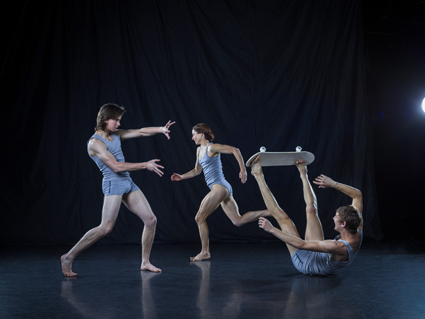
Tobiah Booth-Remmers, Lisa Griffiths, Lewis Rankin, Skeleton
photo Chris Herzfeld, Camlight Productions
Tobiah Booth-Remmers, Lisa Griffiths, Lewis Rankin, Skeleton
AFTER A STERLING CAREER WITH ADELAIDE’S AUSTRALIAN DANCE THEATRE AS AN ASTONISHINGLY FLEXIBLE AND DYNAMIC DANCER, AS WELL AS ASSISTANT CHOREOGRAPHER, LARISSA MCGOWAN HAS EMERGED IN RECENT YEARS AS A BRIGHT NEW CHOREOGRAPHIC TALENT.
McGowans’ first full-length work, Skeleton, will premiere at the 2013 Adelaide Festival and then play at Dance Massive in Melbourne. Meanwhile, the short work Fanatic, which premiered in Sydney’s Spring Dance festival last year will feature as one of three works in Sydney Dance Company’s De Novo, opening in March.
Born and dance-trained in Brisbane, McGowan subsequently graduated from the VCA, joined ADT in 2000, toured internationally with the company and became assistant choreographer to ADT Artistic Director Garry Stewart in 2008. She’s won Helpmann, Green Room and Australian dance awards; created Zero-sum for WOMADelaide in 2009; was a guest choreographer for two seasons of So You Think You Can Dance; greatly impressed with Slack, performed by ADT in the 2009 Spring Dance season (RT94, p38) and toured to France and Holland by Link Dance Company; created Transducer for a Tasdance double bill; and premiered Fanatic in Spring Dance 2012 for Sydney Dance Company’s Contemporary Women program.
fanatic
Fanatic is as physically precise and dextrously realised as you would expect from McGowan. Three dancers lipsynch the YouTube voices of besotted fans of the Alien and Predator films, but more than that they become the creatures, at once funny and frightening. McGowan tells me that her collaborator on Skeleton is theatre director Sam Haren: “We did a piece many years ago, a solo work made on myself, called Theatrical Trailer to Alien 5. Fanatic, for Spring Dance last year, was an extension of that. The process with Sam was just so interesting because I was working with somebody from a theatre background. So we thought, why don’t we use this process to make a full-length work?” That work is Skeleton.
I spoke by phone with McGowan about Skeleton, a work that conjures up aspects of the artist’s childhood memories centred around certain beloved objects and cultural artefacts. But more than that, it’s about the body’s dangerous engagement with those objects, be they bikes or bats (see our cover image). Fundamental to that, of course, is damage to the skeleton. This has led McGowan not only to reflect on growing up and physical trauma, but also the nature of the skeleton, including the ways that artists regard it and the prostheses like high-heeled shoes and instruments with which we extend it.
How would you describe the structure of Skeleton?
A puzzle. Pieces of life you see being formed and re-formed onstage, conjuring questions about who the person was, what they looked like, what kind of life they lived and how they died. It’s been a really great way to structure a work choreographically, exploring in a kind of archaeological way, putting things together. For me it’s really about the material reality of the skeleton, that final trace of a human being, and about traumas and their effect on our psyche in a collage of images.
When you say a collage, what sort do you have in mind?
The five dancers in this work are very different, unique-looking movers. They’re oddities in their own way, fused together. And the objects we’re looking at in Skeleton have pretty much come from 80s, 90s popular culture. They’re things that remind me of my youth, and movies at the time.
What kind of things?
Skateboards and BMXs and bats—all the things that can cause trauma just through playing. The people I researched in order to make this work were looking at the same era of objects. For instance, Ricky Swallow is a phenomenal Australian artist who makes objects—his skulls resonate with a dark kind of feeling. I like that playful, ironic look—the skull in a hoodie—that brings up things from my past that I think are dark, but humorous in some way.
We have five objects and five dancers. There’s a bike, a skateboard, a baseball bat. There’s a T-shirt because at the time people were wearing slogans. There’s also the heel of a shoe. Some of these objects came from looking at the work of UK artist Nick Veasey who does amazing X-ray image stuff where you actually see the ‘skeleton’ of an object. It’s really quite beautiful. There’s a bone-like stability [in the shoes in Veasey’s picture] that looks like an extension of the bone of a woman’s leg through the heel to the ground. I find it interesting that things that we use and wear really can become a part of our own body structure. [See http://twistedsifter.com/2010/05/x-ray-photography-nick-veasey/]
Is there a design element in Skeleton beyond bodies and objects?
There are screens that move across the space in order to suggest the feeling of things being removed and put back in place, but you don’t actually see a dancer or object actually enter. Design has become a huge part of this piece.
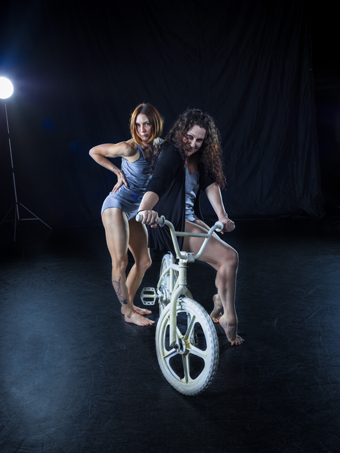
Lisa Griffiths, Larissa McGowan, Skeleton
photo Chris Herzfeld, Camlight Productions
Lisa Griffiths, Larissa McGowan, Skeleton
And who has designed it?
Jonathon Oxlade. He’s quite amazing. I wanted something very simple and very clear in its design in order to enhance what’s going on in the movement onstage. And it’s really done its job. It’s great.
And what about sonically? In what I’ve seen of your work there’s a very precise connection between sound and movement.
I think it drives the movement that I do. I love to hear layers. That’s one of the things that’s amazing about the human body when we’re trying to make movement—just the number of layers and systems within our bodies that can work so cohesively. The composer is Jethro Woodward whom I’ve worked with quite regularly. He can work with any type of instrument. It’s a recorded score but it’s going to be tricky because, as usual for me because I enjoy it, it will work very, very tightly with the movement, [but not all the time] because the work needs layers and it needs texture.
Would you like the audience to go away sensing the body as a bit more complex and strange?
Well, that would be lovely if it were possible. But I really wanted to make a piece—my first full-length work—that actually is about dance. It’s not about the technology that I’m seeing in dance everywhere. I really want to go back and remind myself, and hopefully others, that dance is an amazing artform due to the fact that it’s all coming from inside the human body.
I’m excited to create movement that is still virtuosic without it being the trademark stuff that I’ve done in the past. I’d like to tap into a younger audience that might not know exactly what contemporary movement can be—making it accessible for everyone.
You are performing in Skeleton?
Yes. I really appreciate choreographers who have come from a dance background and who continue to persevere as dancers while making work. I think that being in both worlds really assists in your own practice in both areas. That’s what I strive for.
Are you already fantasising the work that will come after this or is this enough for the moment?
Hopefully Skeleton will give me a platform to start producing new work. I’ve definitely got lots of people I’ve been talking to about future projects. But I feel like I just need to make sure that this one is heading in the right direction first before I jump into the deep end.
–
Adelaide Festival, Skeleton, directors Larissa McGowan, Sam Haren, AC Arts Main Theatre, March 2-9; Dance Massive, Beckett Theatre, Malthouse, Melbourne, March 15-23; Sydney Dance Company, De Novo, works by Rafael Bonachela, Alexander Ekman, Larissa McGowan, Sydney Theatre, March 1-23
See Philippa Rothfield’s preview of Dance Massive 2013
RealTime issue #113 Feb-March 2013 pg. 26
© Keith Gallasch; for permission to reproduce apply to realtime@realtimearts.net
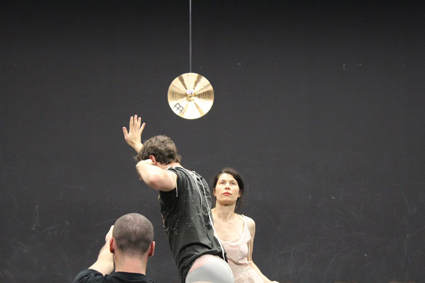
Matthew Day, Rennie McDougall, Deanne Butterworth, And All Things Return to Nature Tomorrow, Luxembourg residency, Trois C-L, 2012, choreographer Brooke Stamp
photo Phillip Adams
Matthew Day, Rennie McDougall, Deanne Butterworth, And All Things Return to Nature Tomorrow, Luxembourg residency, Trois C-L, 2012, choreographer Brooke Stamp
CONCRETE MIXERS DESCEND FROM THE CEILING. DECORATED WITH LIGHTS, THEIR BARRELS SPIN HYPNOTICALLY OVER THE NAKED PERFORMERS. THE SPACE IS INVADED. TOMORROW—THE SECOND PART OF BALLETLAB’S NEW DOUBLE BILL, AND ALL THINGS RETURN TO NATURE TOMORROW—ENDS WITH A UFO ENCOUNTER.
BalletLab’s Artistic Director and choreographer, Phillip Adams is unapologetic about his Spielbergian ‘Hollywood ending’ impulses. “It’s pseudo sci-fi meets kiddie pop,” he says, half-seriously. He is not afraid “to take the bullet” for being on the frontline of dance. “Failing is how you succeed. Somehow we land in our next stage of history,” he says. BalletLab, he explains is on the periphery of Australian dance while being squarely in the middle of it.
Responding to the end of postmodern irony and a return to the utopian impulse to build, BalletLab’s new work has been two years in the making and has covered some serious air miles. There were Adams’ experiences with rednecks and hippies in the Mars-like landscape of the Mojave Desert, and the company’s dance residency in Luxembourg. Underpinning the new work by long-term associates Adams and Brooke Stamp are concepts of utopia. Adams draws on utopian architecture including Frank Lloyd Wright and Paolo Soleri’s Acrosanti [an experimental town in the desert embodying the fusion of architecture and ecology]. Stamp takes a more temporal view. It has been 14 years since they came together, and while the pieces in the double bill are as thematically and tonally distinct as could be imagined, a “common energy and interest in the space” unites the experience, says Adams.
In Stamp’s first choreographic outing for the company, utopia is represented by creating spaces where dance is collectively improvised. Her ethereal work, And all things return to nature, draws on systems of improvisation that she has developed for “responding to sound or text, including philosophical texts.” For this piece, Indigenous Australian cosmology played a pivotal role. The Dreamtime is a description of cosmogenesis with Stamp elaborating on both mythology and science to investigate kinetically charged sound.
The work incorporates recordings by Garth Paine which act in a way to “sound the planets into being.” The Big Bang is said to have been a bass hum rather than an explosion. Physicist and author Frank Wilczek attempts to explain this “never-ending hum of the universal sounding board that permeates the universe” as the “relic of the primordial big bang” in his 1988 book Longing for Harmonies. Curiously, scientists who investigate physics and chemistry find a strong resonance with the ordered nature of music.
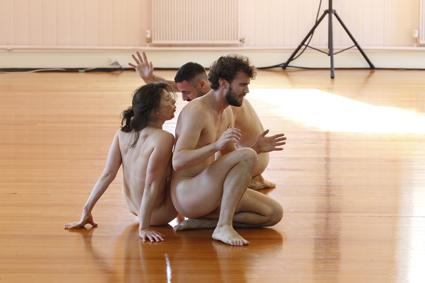
Deanne Butterworth, Rennie McDougall, Matthew Day (rear), Tomorrow, development at Abbotsford Convent, 2012, choreographer Phillip Adams
photo Jeff Busby
Deanne Butterworth, Rennie McDougall, Matthew Day (rear), Tomorrow, development at Abbotsford Convent, 2012, choreographer Phillip Adams
Eight channel speakers will bathe the audience in this energy, “activating” them. Stamp tunes into the vibrational hum of the universe to describe the nature of ‘being.’ Her fascination with these themes is most personally expressed when she says that when all else fails, the movement of the universe is one thing she has to fall back on. Asked about both choreographing and performing in her own piece, Stamp explains that it was a way she could embody herself in the same discourse, experiments, language and “field of connectivity through concepts of frequency and vibration.” It was also a way of removing the hierarchy between choreographer and performer. Adams proudly heralds the emerging choreographer’s work as “out on the regions of the galactical/experiential space,” which radically complements his own work.
A preoccupation with sound is also evident in Adams’ piece, manifest in terms of Paine’s experimental music and the choreographer’s inspirational visit to George Van Tassel’s “acoustically perfect tabernacle” and alien altar, the Integratron. Van Tassel was an aeronautical engineer and test pilot alongside Howard Hughes. He began building the structure in 1954 as a place for rejuvenation and meditation (after being spurred on by several encounters with aliens). Wires and strings underneath the building suspend and hold it together—“it’s an acoustic machine that traps energy,” Adams explains. A recording session at the space took advantage of the acoustics; blankets were moved around the room and these sounds feature in the piece.
Standing in the Mojave Desert the domed structure had an immediate effect on Adams as a work of art. Sound baths, healing crystals and “crunchy granola [hippy] types” also offered the right creative fodder for Adams who has previously looked at Australian suburban noir in Axeman Lullaby (2008) and radical 60s and 70s religious groups in Miracle (2011). Adams’ Tomorrow is a reconstruction of his experiences in the desert, including an installation created in situ by architect Matthew Bird and an encounter with gun-toting but friendly ‘white trash’ whose timely arrival coincided with Adams’ responding to the landscape by lying naked near the site of a UFO landing.
Adams has an eagerness to relay his findings, to bare himself and ask the audience to participate in an experience. Seating has been reconfigured around the performers in a circle. What Adams and Stamp both ask is for audience surrender—to sound or to rapturous abduction. Adams is also recognised as a creator of immersive performances, aided by collaboration. “My architect, sound designer and my lighting designer are choreographers”—while Adams takes on their roles. “It gets that deep and I think that has been BalletLab’s defining motif.”
Stamp is both a disciple of and an inspiration to Adams and has followed suit in embracing collaborative processes. Working with MATERIALBYPRODUCT designer Susan Dimasi on sublime hand-painted costumes earned the new show a spot on the Melbourne Fashion Festival calendar. In Dimasi Stamp found someone who worked on her level “where [we’d] have a dialogue about language and sound” or watch the dancers instead of prescribing what the costumes should look like. Dimasi is interested in the constant evolution of the garment through a dancer’s movement and the tears and sweat that alter them.
Adams’ Tomorrow lacks clothing, instead featuring a futuristic woven blanket—created by Dimasi after seeing Matthew Bird’s installation in the desert—which becomes a costume. The naked performers are “designed in the space” by the blanket. It looks painstakingly constructed, the strands of coloured fabric both tribal and un-earthly. Similarly, painstaking research and inquiry has gone into the details of this show. Stamp agrees “the depth of research is extreme. It’s where all the ephemeral properties of performance making exist and are never revealed.”
BalletLab, And all things return to nature tomorrow, choreographers Phillip Adams, Brooke Stamp, The Lawlet, Southbank Theatre, Melbourne, March 15-23
RealTime issue #113 Feb-March 2013 pg. 27
© Varia Karipoff; for permission to reproduce apply to realtime@realtimearts.net
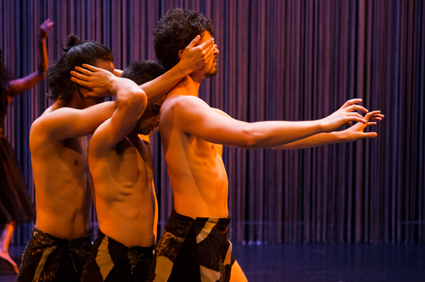
Diaphanous, Ochre Contemporary Dance Company
photo Simon Cowling
Diaphanous, Ochre Contemporary Dance Company
CONSIDERING THE FRAUGHT HISTORY OF CONTEMPORARY DANCE IN WA, THE EMERGENCE OF OCHRE SHOULD HAVE BEEN, AS SUGGESTED BY THE PRODUCTION’S TITLE, A CAUSE FOR ‘SEEING THROUGH AND BEYOND.’ WHILE AFTER-IMAGES GLIMMERED IN CREATION STORIES ABOUT THE FIRMAMENT’S CONSTELLATIONS, THE MILKY WAY AND ORION, AND CULTURAL DIALOGUES JUMPED WITH ÉLAN DOWN TO EARTH IN THE CONCLUDING YARNING. IN ITS FIRST OUTING THE FLEDGLING COMPANY AND ITS DIAPHANOUS DREAMS FAILED TO REVEAL ALTERNATIVE DANCE WORLDS.
The filigreed fall of the set’s twine across the performance cosmos resonated with mythological inclusiveness, sharing human life trials and weaving spiritual mysteries into the land. That woven loom, however, presents a daunting panorama where knots are bound to surface, particularly in drawing a Wongi Seven Sisters’ legend in counterpoint with a Greek myth—that of Orion whom Zeus transformed into the constellation of that name.
The performance began in hushed anticipation with Tammi Gisell’s Thoogoorba, as the first sister materialised, softly appearing in star trails with her coolum worn as a crown. As if seeking the materiality of her new identity, she stoked the ground, symbolically laying the coolum’s cradle of birth and sustenance there on the land. Her fluid swaying, the peculiar rhythmic lilt of her gestures bore the strength of Indigenous women who carry and see beyond. Tracking that metaphor further was difficult in the ensuing tension of guardianship of the coolums between the females (the Dreamtime sisters) and males (the fallible creatures of Earth) except that the seduction and final intimacy of man and first sister conveyed the ancient theme of sacrifice in order to issue mortal birth.
Projecting a more violent world, the entanglements in Jacob Lehrer’s Orion’s Belt were forewarned by storyteller Maitland Schneer’s incisive questioning of the audience’s willingness to inflict violence in order to achieve their desires. Have rape and domination replaced the subtle shifts of sexual attraction and/or do the altered power relations between humans and gods reflect a taste for greed and exploitation? The Greeks, young by Indigenous Australian standards, discovered the power of metals and, by extension in contemporary terms, mining’s mixed blessings. Mythologically, the personal rages into high politics: intimacy twists into estrangement as stratified communities commit societal oppression. In dance terms, discrepant power relations emerged in virtuosic displays and harsh duos, raising questions of what this embryonic company aims to achieve. Is the vision a coalition of different perspectives or a device to launch a new company with an awkward amalgamation of Indigenous and non-indigenous artists?
I glimpsed these pressures markedly in the final Yarnin section where a tangled mesh of humour and satire edged towards cultural revisioning of what is told and, more importantly, of what can be told. Choreographers Tammi Gissell and Jacob Lehrer introduced movement ‘joking’ but the gags lost momentum and the storyteller, who might have picked up the threads, was nowhere in sight. The ‘yarnin’ snagged between a racy fireside informality and expectations of a slick Western performance identity. I was left wondering how a company called Ochre might blend cultural distinctions to create a new presence on the Australian stage.
Ochre Contemporary Dance Company, Diaphanous—seeing through and beyond, artistic project director Simon Stewart, choreographers Tammi Gissell, Jacob Lehrer, sound design Josh Hogan, costume, set design Matthew McVeigh, lighting Joseph Mercurio, story consultants Josie Wowolla Boyle, Brownyn Goss, dancers Benjamin Chapman, Joshua Pether, Floeur Alder, Perun Bonser, Nicola Sabatino, Anne-Janette Phillips, Justina Truscott, Matthew Tupper, storyteller Maitland Schnaars, State Theatre Centre, Perth, Nov 22-24
RealTime issue #113 Feb-March 2013 pg. 30
© Maggi Phillips; for permission to reproduce apply to realtime@realtimearts.net
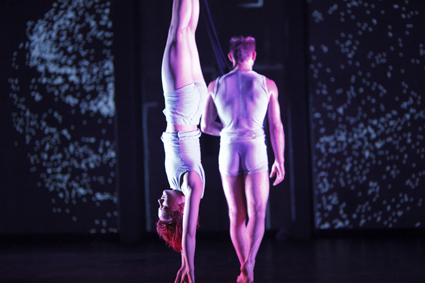
Lee-Anne Litton, Rick Everett, Encoded, Stalker
photo Matthew Syres
Lee-Anne Litton, Rick Everett, Encoded, Stalker
IN LATE 2012 SYDNEY’S STALKER THEATRE EMBRACED NEW TECHNOLOGY AND DANCE TO SPECULATE ON OUR DIGITISED PRESENT AND FUTURE IN ENCODED. IN BEAUTIFUL ONE DAY, SYDNEY’S VERSION 1.0, BELVOIR AND MELBOURNE’S ILBIJERRI THEATRE COMPANY COLLABORATED TO REFLECT ON AND RE-ENACT PALM ISLAND’S DARK HISTORY AND ITS CONSEQUENCES FOR THOSE WHO CONTINUE TO LIVE THERE.
Encoded delights in the thrills provided by immersive new technologies while angsting over their dehumanising potential. Beautiful One Day conveys the emotional struggle to accept what was once a prison as now home if still oppressive, with the white viewer inevitably feeling complicit in that oppression.
stalker, encoded
In near dark someone, possibly winged, slowly turns toward us, small red-light eyes, a skirt hooping out slightly from the body. Nearby stands another ‘alien,’ skirtless, presumably male. They appear to have aerials. Their bodies are illuminated with Rorschach patterns, perhaps evoking organs, but green. The couple shimmer, beautiful, insect-like, but hi-tech; cyborgs?
A universe opens behind them, stars flowing across a vast Carriageworks wall but, less than cosmic, they soon prove to be part of the grid of a huge abstracted building which will expand, contract and slide vertiginously up and down like a monstrous elevator. Again, something manufactured, eerie. The creatures exit.
Human figures, male and female swirl, leap at the massive projection, conjuring tumbling flight, but then fall into pretty conventional contemporary dance before magically melting into a mass of stars.
The early promise of Encoded soon drifts away into alternations between aerial and dance sequences, with the former providing some fascination moment by moment but without cumulative weight. Bodies hang upside down or mutate into Y-shapes, fly out from the wall towards us, pair off and execute exacting ‘wall dances,’ or form threesome totems, almost alien, but still certainly human. In the end, we are alone with one of the creatures that initially confronted us with its worrying sense of difference—save the oddly insistent gender distinction.
Encoded addresses contemporary anxieties about the prospect of losing “the human in the midst of the pixels” (program note). To do this it celebrates the human capacity to defy gravity by dancing and swinging on rope while exploiting digital technologies to suggest even greater capacities. The result is at times spectacularly cinematic, reinforced by over-emphatic music, but Encoded lacks the cohesion and escalating dynamism witnessed in Stalker’s previous work MirrorMirror (RT94,p36), part of director David Clarkson’s continuing exploration of identity across time and space. The initial tensions and sense of excitement are soon lost. It’s disappointing too that the beautifully enigmatic creatures from the future remain merely emblematic—there is no interaction with the humans, quite unlike that seen between robots and dancers in say, Garry Stewart’s Devolution (ADT, 2006, RT71, p2). In that work hybridised humans sprouted horrifying robotic prostheses. Encoded is, with its almost motionless aliens, a relatively contemplative work in which humans and new creatures neither interact nor morph. Its characters appear to be less than agents in their universe and more the tools of technology, director and choreographer. The digital art team working on the production, however, have made something visually special of Encoded.
beautiful one day
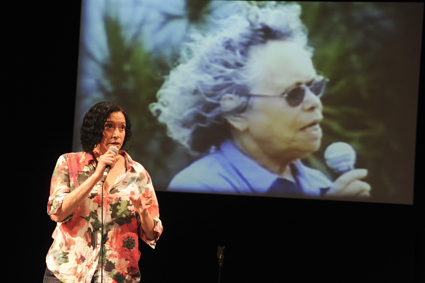
Rachael Maza, Erykah Kyle (screen), Beautiful One Day, Belvoir, version 1.0 & Ilbijerri Theatre Company
photo Heidrun Löhr
Rachael Maza, Erykah Kyle (screen), Beautiful One Day, Belvoir, version 1.0 & Ilbijerri Theatre Company
I’ve read the news and the book (Chloe Hooper, The Tall Man: Death and Life on Palm Island, 2009), seen the documentary (The Tall Man, director Tony Krawitz, 2011) and the four-channel video installation (Tall Man, Vernon Ah Kee, 2011) and now the stage play, Beautiful One Day. The tale of Palm Island exile, discrimination, murder, riot and justice denied is a scar on Queensland’s integrity, but sadly emblematic of national injustices. Each encounter with the story adds more disturbing details and discomfiting perspectives. This account by version 1.0 and Ilbijerri digs into the island’s history and adds a heightened Indigenous perspective side by side with verbatim recreations of pivotal moments in the unfolding tragedy.
The telling of the earlier history of Palm Island casually conjures key personalities, recites cruel, petty rules (courting only 4-5pm, “no laughing,” no bikes…) in what was essentially a slave colony. It recalls public punishments like head shaving, protests and a strike for wages, meat and freedom of speech, and its brutal consequences. 1960 documentary footage (projected in fragments on the semicircular screen that frames the stage) depicts then famous Australian musician Shirley Abicair declaring the island “the site of a bold experiment” to lift up its people while the sound score thumps ominously and whistling mocks this nonsense. The years roll on. In 1986 the inhabitants are given Deeds of Grant to the island, but infrastructure is removed. Then it’s 2004, and Cameron Doomadgee falls victim to Senior Constable Christopher Hurley. Rachael Maza delineates Hurley’s good cop, bad cop virtues and failings and six versions of Doomadgee’s ‘fall’ are mechanically, and chillingly, re-enacted across crime scene floor markings and architectural projections. This sequence and the ensuing court room encounters provide some of the strongest scenes in Beautiful One Day.
Subsequently the production loses focus and momentum, ambling to a conclusion that nonetheless brings home the painful contradictions the inhabitants of Palm Island must live out: the island is not their country, but it has been home for generations; they love it, but it is fundamentally oppressive. We see their faces, projected before us, hear their words, their frustration that a ‘vision plan’ for the island remains unrealised and that, worse, the Act that has governed their lives for so long is implicitly still there. The mix of despair and optimism, however, does not read like contradiction, rather as well-worn stoicism.
Version 1.0 and Ilbijerri have taken on a big subject (a consistent mark of both companies), as theatre must, engaged with it directly and inventively with strong performances on designer Ruby Langton-Batty’s mobile, grassy floating floor before a screen aptly evocative of museum dioramas. One surprising misstep came in the form of the reproduction of the exchange between the embattled police on the ground in Palm Island during the riot and those off-shore coming in with reinforcements. Two performers sit before music stands and deliver the lines deadpan from the verbatim script. The effect is unfortunately comic, but if you’ve seen the news, the book, the film, the installation you’ll know that the police, however you may regard their role in events, were profoundly afraid. The production sidesteps this and the intensity of the riot with ironic cool. Beautiful One Day has been fulsomely praised by reviewers, and some of that praise is warranted, but it is a work that is neither as focused, integrated nor as taut as anticipated.
Carriageworks & Stalker Theatre, Encoded, conception, direction David Clarkson, performers Lee-Anne Litton, Miranda Ween, Rick Everett, Timothy Ohl, digital artist interactive systems, Andrew Johnston, virtual costumes Alejandro Rolandi, architectural mapping design Sam Clarkson, choreographer Paul Selwyn Norton, composer Peter Kennard, multimedia dramaturg and consultant Kate Richard, lighting Mike Smith, costumes Annemaree Dalziel, Carriageworks, Sydney, Nov 28-Dec 1; Belvoir, version 1.0 & Ilbijerri Theatre Company, Beautiful One Day, devisors: AV designer Sean Bacon, performer, cultural, consultant Magdalena Blackley, performers Kylie Doomadgee, Paul Dwyer, Rachael Maza, Jane Phegan, Harry Reuben; other devisors Eamon Flack, David Williams; set & costume designer Ruby Langton-Batty, lighting Frank Mainoo, composer, sound design Paul Prestipino; Belvoir Upstairs, Nov 21-Dec 23, 2012
RealTime issue #113 Feb-March 2013 pg. 29
© Keith Gallasch; for permission to reproduce apply to realtime@realtimearts.net
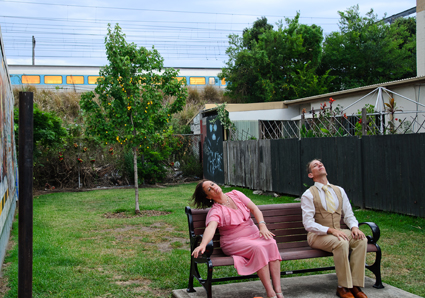
Julie-Anne Long and Martin del Amo, Benched, Micro Parks 2013, presented by Performance Space in Association with Sydney Festival 2013
photo Lucy Parakhina
Julie-Anne Long and Martin del Amo, Benched, Micro Parks 2013, presented by Performance Space in Association with Sydney Festival 2013
BEGINNING AT CARRIAGEWORKS, WE PICKED UP A MAP AND STARTED THE SELF-GUIDED TREK THROUGH NEWTOWN AND ERSKINEVILLE TO MINIATURE PARKS IN BLANK LOTS AND TRIANGULAR CORNER BLOCKS FOR MICRO PARKS, A COLLECTION OF FOUR FREE PERFORMANCE WORKS PRESENTED BY PERFORMANCE SPACE AND SYDNEY FESTIVAL.
Benched, Julie-Anne Long and Martin Del Amo’s dance piece, was performed in a wee plot wedged between two houses. The space was charmingly long and skinny with one graffitied wall, one lone central tree, one sunny park bench beyond the reach of the tree’s shade, a partially vine-covered chicken wire back fence and a whole lot of grass. A backdrop of trains pulling into Erskineville Station complemented the dancers’ slow motion entrance and framed the entire performance as serene and other-worldly. Serenity, à la The Castle, played into the performers’ Italian-holiday themed exploration of sitting postures lifted from courtroom drama, sporting matches and talk shows. ‘Marty’ and ‘Julie’ each assumed a sequence of seated stances as solos—individuals cohabiting the bench. Then the two swapped performances, lending new perspectives on the ways certain shapes are gendered and enculturated, changing the stories of these two solitary characters amid an imaginary, crowded grandstand. Props, including a fluoro orange esky filled with colourful drinks melded the performance with the park setting.
Perched on little stools, the audience grew. Kids scrambled in front of us to laze on the grass. Dogs too. Most of us were sitting in full sun on a 35 degree day, so we had great sympathy for the dancers who were glaring back at the sun in a “you won’t break us” stand-off. Long and Del Amo won and the sky opened up late afternoon Sunday, closing the third day of performances two hours early.
Those attendees who would complain about the elements complained about the elements. “First it was too hot, and then it rained.” Unless audiences adopt a Zen-like mindset and accept that impending rain and possible cancellation are part of the art—the fragility that makes an event like this special—disappointment is inevitable. The organisers had tried to provide shade and refreshments, knowing that walking between mini parks would tire some visitors. At Benched an array of fruit, Italian soft drinks and amaretto cookies were silver-plattered around after the half-hour performance.
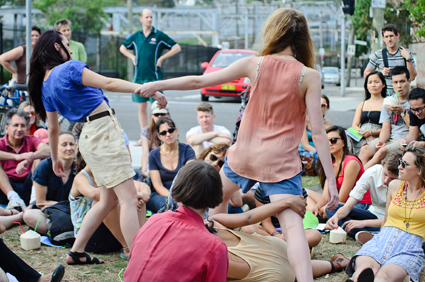
I am an Island, Jess Olivieri with the Parachutes for Ladies, Micro Parks 2013, presented by Performance Space in Association with Sydney Festival 2013
photo Lucy Parakhina
I am an Island, Jess Olivieri with the Parachutes for Ladies, Micro Parks 2013, presented by Performance Space in Association with Sydney Festival 2013
At I am an Island, a short opera by Jess Olivieri and her performance group Parachutes for Ladies, whole coconuts were drilled and cleaved for those willing to sit through 20 minutes of high F# soprano musings on loneliness in an urban environment. I’m not sure this opera was about the music, as no composer was mentioned in the literature. The singers, unemotionally intoning about sexy Swedish tourists and the contents of travel brochures, made me want to leave these characters to their static suffering. But baffled, along with a small crowd, I stayed to delight in the responses of unsuspecting passers-by. Train commuters’ and drivers’ heads turned, often in panic that someone was being hurt, and then their faces softened to general befuddlement at the sight of people congregating in an underused public park.
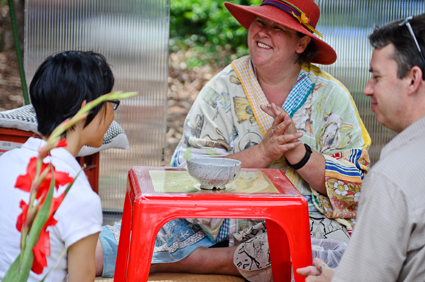
Wabi-Sabi Afternoon Tea, Sarah Goffman, Micro Parks 2013, presented by Performance Space in Association with Sydney Festival 2013
photo Lucy Parakhina
Wabi-Sabi Afternoon Tea, Sarah Goffman, Micro Parks 2013, presented by Performance Space in Association with Sydney Festival 2013
Black billy tea and Iced VoVos topped with whipped cream from a spray can were the special treat at Sarah Goffman’s Wabi-Sabi Afternoon Tea. The Japanese aesthetic concept of wabi-sabi celebrates beauty in impermanence and imperfection. It nurtures that which is authentic by acknowledging three simple realities: nothing lasts, nothing is finished and nothing is perfect. Plonked down on a makeshift milk-crate pouffe, a sort of Aussie farmer’s wife dressed in a kimono made of Australiana tea-towels, conversed with afternoon tea guests. After waiting for a good 35 minutes in the rain for my turn, I took off my shoes and ascended to the mini tatami podium for an intimate chat with the tea master. The jolly matron explained that her tea-house-pagoda was specially made for Micro Parks and that it would be torn down again after the three days of performance because we couldn’t have local kids hurting themselves by climbing something with corners.
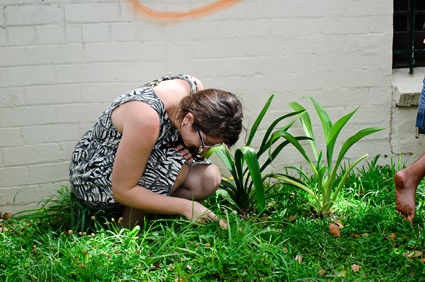
Some Extra Luck, Kate Mitchell, Micro Parks 2013, presented by Performance Space in Association with Sydney Festival 2013
photo Lucy Parakhina
Some Extra Luck, Kate Mitchell, Micro Parks 2013, presented by Performance Space in Association with Sydney Festival 2013
The fourth contribution to Micro Parks— relocated from its spot on the event map and missed by many—was a sort of treasure hunt conceived by artist Kate Mitchell. The lucky audience became performers as they leafed through grass to find a special breed of planted four-leaf clovers.
With any luck, we’ll see more of these sorts of events in Sydney’s Inner West where the public are reclaiming public space. Reclaim the Lanes carried the torch into February. Where to next?
Performance Space and Sydney Festival, Micro Parks: Kate Mitchell, Sarah Goffman, Jess Olivieri with the Parachutes for Ladies, Julie-Anne Long and Martin Del Amo, various locations in Newtown and Erskineville, Sydney, Jan 11-13
RealTime issue #113 Feb-March 2013 pg. 30
© Felicity Clark; for permission to reproduce apply to realtime@realtimearts.net
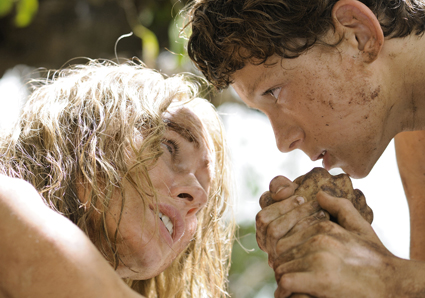
Naomi Watts, Tom Holland, The Impossible, photo Jose Haro, © 2011 Summit Entertainment, LLC.
AT A MAGNITUDE OF 9.1-9.3, THE 2004 INDIAN OCEAN EARTHQUAKE WAS SO POWERFUL IT CAUSED THE PLANET TO WOBBLE SLIGHTLY ON ITS AXIS, EFFECTING A TEMPORARY CHANGE IN EARTH’S ROTATION AND DECREASING THE LENGTH OF A DAY BY 2.68 MICROSECONDS.
An estimated 230,273 people died as a result of the tsunami that followed. In Thailand, where Juan Antonio Bayona’s film The Impossible is set, the death toll is estimated to have been 8,212, including at least 2,464 foreigners.
Returning to these recent, dreadful events, The Impossible focuses on the experiences, based in reality, of one family of foreign tourists. The real family, Spaniards María and Enrique Belón and their three sons Lucas, Simón and Tomás, transform, in a move to attract English-speaking audiences, into Britishers Maria (Naomi Watts) and Henry (Ewan McGregor) Bennett, and their sons—also Lucas, Simon and Thomas. This adjustment of the family’s nationality, in addition to the film’s focus on Westerners rather than the suffering of the indigenous population, has seen The Impossible criticised by some reviewers for ‘whitewashing’ a disaster that overwhelmingly affected the developing world.
This is somewhat harsh. Given the film’s specific nature, the large number of tourists affected by the tsunami in Thailand, and the close involvement (and claims of fidelity to her experience) of María Belón, it seems at least feasible that this family, located in a tourist area, would not have been privy to the magnitude of suffering among the Thai population. There is certainly a wider issue concerning the sort of luxury tourism in developing countries that sees wealthy Westerners effectively segregated from real life in the places they travel to. Perhaps the relative absence of Thais in the film merely holds a mirror up to this sort of experience.
In his first feature, The Orphanage (2007), Bayona demonstrated his skill in representing family bonds as a vital part of the narrative. Much of the tension in this uncanny yet ultimately moving ghost story was invested in the depth of maternal feeling. The relationship between mother and son is also at the crux of The Impossible, Bayona’s second feature film. Naomi Watts is the film’s focal point, appearing in more extended close-ups—most of them showing pain of some sort—than any other member of the family.
There are moments when, in order to convey the extent of the crisis, the camera moves away to create aerial views of endless rows of body bags. But the film doesn’t dwell on the spectacle of destruction. The aim is to give us a very personal angle on an horrific event that is difficult to comprehend in its entirety.
While the horror genre often uses the suffering female figure in a distanced, fetishistic way, The Impossible dwells on Maria’s bruised and swollen face so we feel her pain. There’s never a sense that the family’s survival was a walk in the park. When Maria and Lucas are thrown around by the surging waters of the retreating tsunami, The Impossible drives home the helplessness and fragility of human life when confronted with a force such as this.
A lyricism and sense of the unfathomable runs through the film. It’s there in the ominousness which builds on the day before the disaster, prefigured in small, inconsequential events (a page falling from a book, tourists swimming underwater). It’s also there in a nighttime scene where an older woman (Geraldine Chapman) talks to one of the younger boys about the impossibility of telling which stars are already dead (an obvious resonance with the film’s title). The Impossible’s most poetic sequence occurs in Maria’s uncanny, dreamlike memory of the moment the tsunami hit. We see the monstrous surge of water crash into the glass greenhouse she crouches against; her unconscious body submerged among debris and corpses. Then, from beneath, we observe her rise to the surface, spread-eagled and silhouetted against the light. This hint of the ineffable makes The Impossible poetic as well as dramatic, and with convincing performances from the actors, prevents the film from cloying.
Given the ‘miraculous’ survival of this family of five, when so many others died, it would be easy for smugness to intrude, yet though the family leave together in a plane bound for Singapore, there’s nothing pat about this film’s ending. Relief is there, of course, but also exhaustion and sadness, conveyed, unsurprisingly, through another close-up of Naomi Watts’ tear-stained face. There’s a sense of the open-ended nature of natural disaster: the feeling that none of us is completely safe. The film closes with a shot of the vast ocean.
The Impossible, director Juan Antonio Bayona, screenplay Sergio G. Sánchez, story María Belón, director of photography Óscar Faura, editors Elena Ruiz, Bernat Vilaplana, music Fernando Velázquez, production design Eugenio Caballero, art direction Dídac Bono, Marina Pozanco; Australian distributor Hoyts/Studiocanal
RealTime issue #113 Feb-March 2013 pg. 17
© Katerina Sakkas; for permission to reproduce apply to realtime@realtimearts.net
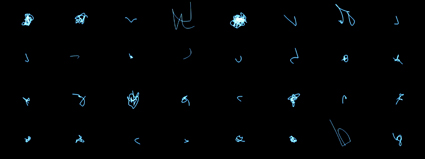
Kynan Tan, Multiplicity (still)
WHEN STRIPPED BACK TO RAW RELATIONSHIPS BETWEEN SIGHT AND SOUND, GOOD EXAMPLES OF AUDIO-VISUAL PERFORMANCES CAPTURE AN ALMOST PRIMAL BRUTALISM THAT DIRECTLY STIMULATES THE SENSES THROUGH CAUSAL RELATIONSHIPS.
For Robin Fox the synaesthetic connection between sight and sound is the primary focus of his musical practice, while Kynan Tan has been moving in a similar direction for some time now, with a more distinct, thematic focus that underpins the music/visual relationship. Utilising dual screen projections, Fractal Shale featured an impressive display from two contemporary Australian artists in top form, in the first concert of four celebrating Tura New Music’s 25 Years.
kynan tan
Tan spent much of 2012 expanding his audio-visual language, a process that started with the premiere of Consciousness, the first part in a proposed three-part work that explores ideas of perception, thought and networks. At Fractal Shale, Tan performed the newly created second part of this series. Shifting between familiar touchstones of glitch and noise, Multiplicity is largely constructed from a range of familiar components (the hum of sine waves, the pulses of raw data and a mixture of other sonic elements). The implementation, however, of these elements gives voice to unique compositional structures that alternate between the tightly regimented and expansively freewheeling. Tan manages to shape information and data streams into a thematically satisfying narrative of six works that revolve around human interaction, climaxing impressively with a map of interconnected data hubs from across the world. The high-pitched chatter of these exchanges is masterfully manipulated into a dense labyrinth of texture.
The relationship Tan draws between sight and sound always favours the obtuse, while never being entirely unpredictable. This results in a work that immediately and clearly communicates its ideas while playing with the audience and their perceptual expectations. Ultimately, it is Tan’s ability to play with tension and expectation that makes Multiplicity such an original and engaging work.
robin fox
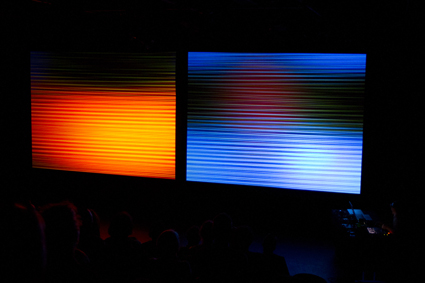
Robin Fox, New Work for Synchronator
photo Brad Serls
Robin Fox, New Work for Synchronator
In New Work for Synchronators, Robin Fox manipulates the red, green and blue layers of video projection through multiple devices known as synchronators, fuelling a work propelled by the pure relationship forged from the conversion of sound energy to light energy. A continuous, half-hour work, the music was primarily derived from simple, raw synthesis that often pushed the boundaries of frequency perception, resulting in pulses of sound and colour. The work evolved slowly through juxtaposition of colour, shape and sound, with ephemeral structures being born from repetition before dissolving into a new state of falling sheets of colour or visuals akin to a broken TV with sound to match. The work was uncompromising yet playful, the exploration of pure synaesthetic relationships between sight and sound, nothing more nothing less, and fiercely unapologetic. On the dual screen setup, Fox’s New Work for Synchronators was a brutalist spectacle at its best, pure unrelenting interaction that slowly wore the audience down through the multitude of differences born of stream of consciousness-like changes.
TURA’s second anniversary concert was a celebration of everything great art should be, powerful and confronting, yet thought-provokingly cerebral at the same time.
clocked out duo
Clocked Out Duo’s premiere of their new work Time Crystals was a fitting end to a concert series that celebrated 25 years of activity from TURA New Music. In a week of performances and concerts that reminisced about TURA-related glories (Club Zho 101) and TURA’s ongoing support for promising young artists (Anniversary Concert #2, Fractal Shale), Clocked Out Duo’s performance belonged to the now. Drawing inspiration from Nobel Prize-winning physicist Frank Wilczek’s 2012 article on the proposed existence of time crystals—perpetually moving structures that repeat periodically in the fourth dimension—Time Crystals consists of 13 charmingly minimalist explorations of recurring patterns and crystalline structures.
The musical ground covered by the work is impressive. From the contemporary classical motifs of the opener, “Time Crystals,’ to the jazz-like “Quantum Harmonics” and the rock-and-roll feel of “X-Ray Diffraction,” each work manages to balance its more distinctive sonic elements with cohesive structures that develop the work in exciting and unpredictable directions. This variation ultimately helps Clocked Out Duo retain their unique sense of play and adventure, an approach that helps infuse even their most serious works with a certain approachability that many of their contemporaries lack. Motifs are passed between performers as pitches and rhythms are mimicked, approximated and juxtaposed. While changes to these motifs often shift sharply they never feel out of place or awkward, rather complementing the economical pacing of each movement.
The timbral choices of Erik Griswold’s prepared piano were well made, the product of the composer’s work with the instrument for several years. While some performers of prepared piano simply attempt to create original sounds without thought to the role such sounds play, Griswold’s choices resulted in an extended sound palette of unique textures that shaped the central motifs of each work, while remaining distinct from Vanessa Tomlinson’s sharply articulated and rhythmically accurate percussion.
The more overt treatments of the piano sometimes overshadowed Tomlinson’s subtle handlings of percussion instruments in unconventional ways. These ranged from small microtonal changes elicited from slight manipulations of the drum skin in “Interstitial Defect” to subtle changes in resonance derived from varied bowing positions in “Quantum Harmonics.” Ultimately, however, it was the sixth movement, “Crystal Symmetry,” that allowed Tomlinson to truly exploit these timbral ideas through a constant stream of strikes in varied locations upon different triangles, eliciting memories for me of the subtlety at play in Alvin Lucier’s The Silver Streetcar Of The Orchestra (1988).
The TURA 25th Anniversary concert series celebrated a significant milestone for the organisation while maintaining the high standard of musical programs TURA realises every year. Clocked Out Duo’s Time Crystals was a timeless integration of minimalist ideas with contemporary classical performance style, serving to remind us all that, despite any elitist preconceptions, music of a more esoteric nature can be engaging and fun.
TURA 25th Anniversary Concert 2, Fractal Shale, Robin Fox, Kynan Tan, Dec 1; Concert 4, Time Crystals, Clocked Out Duo, Dec 5, PICA, Perth
RealTime issue #113 Feb-March 2013 pg. 33
© Sam Gillies; for permission to reproduce apply to realtime@realtimearts.net
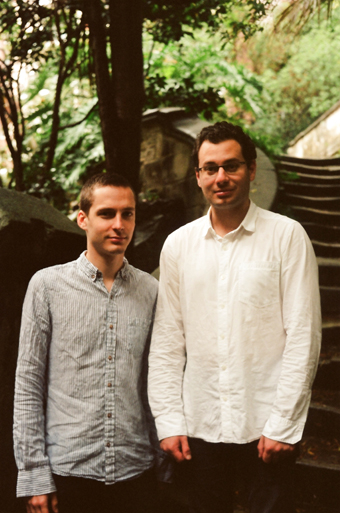
Louis Garrick, Jack Symonds, Sydney Chamber Opera
photo Samuel Hodge
Louis Garrick, Jack Symonds, Sydney Chamber Opera
SYDNEY’S OPERA AFICIONADOS ARE DEPENDENT FOR THEIR LIVE PERFORMANCE PLEASURES ON OPERA AUSTRALIA WITH ITS MOSTLY MAINSTREAM FARE AND OCCASIONALLY ADVENTUROUS DIRECTORS AND, ONCE A YEAR, PINCHGUT OPERA FOR A NOTABLE BAROQUE WORK. NIGEL KELLAWAY’S THE OPERA PROJECT HAS BEEN QUIET FOR A COUPLE OF YEARS, ALTHOUGH A NEW WORK SEEMS LIKELY LATER THIS YEAR. NOT NEARLY ENOUGH OPERA WHEN YOU CAN NEVER HAVE ENOUGH.
However, in just a few years Sydney Chamber Opera has risen to deserved prominence with strong programming, quality musicianship, brave directors and very strong design. And opera fans have responded with great enthusiasm.
I met with artistic director Louis Garrick and music director Jack Symonds, articulate, passionate young men with a shared vision, though not without the humility that acknowledges the surprise they have felt at their success.
Garrick says that the pair knew that there was “a whole wealth of chamber repertoire that Sydney audiences simply weren’t seeing and had no connection with because not a lot of it was being performed.” If politicians declare Sydney a cultural capital, says Garrick, “then a capital should have a chamber opera company. It’s a basic requirement.” As for who was going to undertake such a venture, Symonds reveals that “it was pretty clear to us that nobody else was going to do it and we were naïve enough to think that we could.”
from wagner to chamber opera
In terms of motivation, Garrick admits, “It’s funny. I never had any interest in opera until I was at university. I play the piano and about halfway through my musicology degree, I started listening to Wagner as part of harmony training. That’s standard. And I got hooked. I remember feverishly learning Tristan and wanting to listen to it again and again because I found it such a rich score. Then, one by one, I went through all the Wagner operas. I’m inspired by Wagnerian processes and approaches to operatic form.”
I wonder if it’s the heightened sense of theatricality implicit in Wagner that attracted Garrick. “And the big idea of a through-composed opera where the drama is really music-led.” “On whatever scale,” adds Symonds, “so it doesn’t have to be Wagnerian.” Garrick points out that he didn’t “come from an opera background of arias and duets from the bel canto universe. I really came to it from a musicology form or structure point of view. After Wagner it was Berg and you go from there—Britten and all the major composers of the 20th century, all the fascinating operas. If you get into Britten, you get into chamber opera.”
Garrick’s familiarity with opera grew “when I took a uni job, operating the surtitles for Opera Australia—the bottom job in the whole opera pecking order—and seeing the standard rep over and over again, including the Mozarts, which I love, I think, it made me feel like I was dipping my toe in the opera world as well as learning the really serious repertoire.”
Symonds came to opera as a composer, “from the opposite end that most people do, from more modern pieces and went backwards. The first opera composers I ever got into were ones that I felt connected to in a general compositional way— Berg, Janacek and Britten. Almost every 20th century stream of opera, chamber or otherwise, can be traced to one of those three. And then, go backwards one step and there’s Wagner and that was, for me, a most extraordinary discovery. Like Louis, I don’t have a large interest in early Italian repertoire (Mozart’s Italian operas excepted) and baroque opera is not really my taste. Other than Wagner, I think the later Verdi and Mussorgsky are my picks.”
opera optimism
“What gives me so much hope is that since the 80s we’ve seen an absolute explosion of opera activity…Today we have, almost every year, a new opera that could really be destined for quite an extraordinary and lasting place in the repertoire. Last year we premiered such a piece, Written on Skin by George Benjamin. Harrison Birtwhistle’s The Minotaur is having its revival this year to packed houses in Covent Garden. In 2004 we had The Tempest by Thomas Ades, which is being done all over the world. Just one year before that we had Dr Atomic by John Adams. These are all very large-scale operas but they are sort of flagships for these composers. Benjamin and Ades have composed wonderful chamber operas…not abiding by the old adage that audiences will only respond to a conventional story told conventionally. With the right combination of ingredients and finding especially the right director for contemporary opera you can stage almost anything. And Sydney Chamber Opera sometimes does that. (LAUGHS)
vision and programming
We talked about the company’s vision, which is realised in direction and design with a strong contemporary feel. The pair point out that they didn’t start out with a manifesto. As students at university, they staged Britten’s The Turn of the Screw, which went well. Garrick recalls, “Getting the next production out onstage was a real challenge, but we did it: Notes from Underground by Jack based on the Dostoevsky novella. Next we did a chamber version of Janacek’s The Cunning Little Vixen, then a double bill, I Have Had Enough, a new piece by Jack and a Bach cantata. That was in our first year going from project to project.” For 2012 they presented three works: In The Penal Colony by Philip Glass (RT109), Peter Maxwell Davies’ The Lighthouse (see review) and a performance for the Biennale of Sydney. “The vision for the company and what we want to do with programming, it really percolated in that year. Now we go into the third year with a pretty tight focus on what programming direction we want to take.”
In 2013 Sydney Chamber Opera will present three works: Symonds’ Climbing Towards Midnight, a new Australian work that re-imagines Act 2 of Parsifal (during the Wagner Bicentenary) and directed by Netta Yaschin, designer Charlotte Lane; the Australian stage premiere of Britten’s Owen Wingrave, directed by Imara Savage, designer Katrin Wood; and a staged version of Kancheli’s song cycle Exil, to be directed by Adena Jacobs who directed Persona in Melbourne in 2012 (it is in the 2013 Belvoir season; see RT112), designer Eugyeene Teh. On the selection of works, Garrick says, “It’s important to us to have a balance in programming between new, recent and established work. Just doing new work all the time, that’s not us.”
climbing towards midnight
I ask Symonds about his Climbing Towards Midnight, at once a standalone work and a response to Wagner’s Parsifal. He believes “the difficulty for a lot of people with Parsifal is not the music but the content, the implications that can be drawn from it, especially in its attitude to religion and race and women. That’s a shame because lots of the ideas in it are fascinating and barely talked about. The central part of Act 2 is never discussed, except for the famous aside, when Parsifal cries “Amfortus Die Wunde!” (Amfortus, the Wound!).
People have the impression of Parsifal as big, ritualistic Holy Communion ceremonies that occur in the outer acts. How could you tip the balance and find a new Parsifal as it were with just this fragment of the opera? The idea I had was to shear it of everything but that text, using Wagner’s own text in English translation and withdrawing any overt references to Christianity as well. This was really enticing compositionally because what it left was an abortive relationship between two people desperate to transform each other but not knowing how. From that basis I built an entirely new composition on those ashes as it were. So, in a sense, all of the music is Parsifal, but none of it is. At the top of all my sketches, for instance, the Parsifal music is there but you never actually get it. It becomes so transformed by something else that it’s almost unrecognisable sometimes. If you know the Parsifal music, you’ll hear it but it’s not at all a pre-requisite to know it or the story in order to enjoy the work. It’s not a parasite on Parsifal.”
The opera is scored for two singers—soprano and baritone—and four instruments—viola, cello, bass clarinet and piano which Symonds describes as “a very dark ensemble but it’s fascinating that when these dark instruments strain to play very high, it’s an extraordinary sounding thing…very beautiful and expressive.” He says his construction is not in the Wagnerian manner but “is mostly informed by the expressionist miniature form as practised by Schoenberg, Webern and my favourite living composer George Kurtag.”
owen wingrave
Later in the year the company will present Britten’s Owen Wingrave, a dark tale of ghosts and pacifism, originally made for television. Garrick and Symonds think it’s a good challenge to stage, and ripe for reassessment—“it’s quite tough and unlyrical and it’s complex.” Symonds adds, “but is extremely rewarding and has some of Britten’s most original thinking and, in my opinion, most beautiful writing, especially for the winds and brass and percussion.”
exil
I ask Symonds what drew him to Georgian composer Giya Kancheli’s Exil. “For me this is his greatest piece, the piece where all the concerns from the first few decades of his career come together in a single, very focused work. It has an enormous amount of latent narrative in it. A third of the piece is biblical psalm, The Lord is my Shepherd, and the rest of it is quite extraordinary post-Holocaust poetry, mostly by Paul Celan. That juxtaposition is so powerful and so dramatic in the way it’s set and in the way that he asks and answers questions, it seemed to me a natural thing to draw that out for an audience, to represent it in some way. Its fate is often be to be performed as the last piece in a concert of new music in a concert hall, very un-atmospherically. To me it cried out to be experienced [as opera] and I think, for its Australian premiere, it deserves no less.
The contemporary music scene in Sydney boasts strong creative partnerships: Ensemble Offspring’s Damien Rickerston and Claire Edwardes, Chronology Arts’ Alex Pozniak and Andrew Batt-Rawden, New Music Network’s James Nightingale and Philippa Horn, and Halcyon’s Alison Morgan and Jenny Duck-Chong. Another duo, Louis Garrick and Jack Symonds, is enriching Sydney’s contemporary music world, rewarding the city’s adventurous theatre and opera-goers with an expansive vision of music theatre.
Sydney Chamber Opera , 2013 program, http://sydneychamberopera.com
RealTime issue #113 Feb-March 2013 pg. 36-37
© Keith Gallasch; for permission to reproduce apply to realtime@realtimearts.net
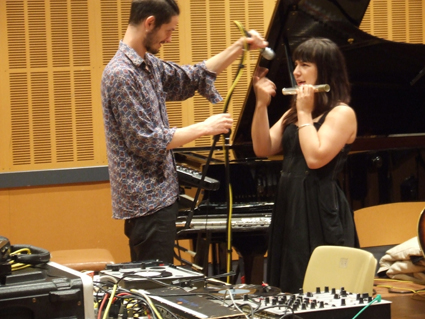
John Watts, Lina Andonovska, Everything Always: The Noise Works of Peter Ablinger rehearsal
photo Andrew Dixon
John Watts, Lina Andonovska, Everything Always: The Noise Works of Peter Ablinger rehearsal
RAUSCHEN IS THE AEROPLANE LANDING OVER MY ROOF AS I LEAVE HOME TO CATCH THE TRAIN TO THE CONCERT. RAUSCHEN IS THE TRAIN IN THE TUNNEL: SPEEDING METAL REARRANGING MATTER—STAGNANT AIR INTO A WAIL SQUEEZED BETWEEN WALL AND WINDOW.
Rauschen is the between space on your radio dial, the audio snow of complete information separating tinny broadcasts of opinion, news, entertainment, talkback music. Ironic then that this concert of the Noise Works of Peter Ablinger, Austin Buckett and Cat Hope took place in a studio of the ABC in Sydney before 50 or so audience members, though primarily for national broadcast.
Although proclaiming the rather ambitious title Everything Always, the program of 10 short compositions can be dissected into three different approaches to the use of Rauschen: simulation, submergence and composition.
simulating rauschen with acoustic instruments
There was a clutch of three Ablinger pieces and one by Buckett that had as their creative impetus the attempt at simulating Rauschen using acoustic instruments. Ablinger’s Weiss/Weisslich 20 (1992/95), performed twice on the night, consisted of a single cymbal roll for two minutes. John Wilton, using a different cymbal for each iteration of the piece, executed the work with a complete non-performativity that suited it perfectly. Once the roll began, there existed an air of inevitability around the piece. It was as if the music had always been sounding and would continue to sound always, partials ringing and colliding wildly with each other above the dull pulse of mallets on metal. The two necessary gestures, to begin and to end, then became amplified—the most exciting moments of this piece occurred when it suddenly came into existence, and when equally suddenly it ceased to be.
Lina Andonovska performed Ablinger’s Piccolo und Rauschen (1995/96) for piccolo and CD and Buckett’s Dead Machines (2012) for amplified flute head-joints and four speakers. The works are quite similar: Ablinger’s high-pitched piccolo tones are synchronised with loud pre-recorded noise, Buckett’s combines pre-recorded noise with breath blown across flute head-joints. In Piccolo und Rauschen, Andonovska’s strident performance was affecting despite some slightly off-putting swaying between tones as if some irresistible Romantic melody was playing in her head. In Dead Machines the Conservatoire reared its ugly head, sounding in the central solo section to this listener as if the score directed Andonovska to improvise her own contribution to the pre-recorded Rauschen. The result was virtuosic chromatic runs: the Conservatoire’s version of everything, always.
submerging genre in rauschen
In both Parker Notch (2010) for solo instrument (electric guitar) and noise (Ablinger) and Improvisors and Noise (2011) for piano, drumkit, no-input mixer and four speakers (Buckett), the composers attempted to submerge otherwise independent instrumental music in a field of Rauschen. In these pieces the instrumental parts behaved as gaudy neon signs—arrows and cartoon fingers pointing the listener outside the torrential downpour of noise and back towards the genre itself: jazz in the Ablinger and electro-acoustic improvisation in the Buckett.
This effect was, I imagine, the opposite to what the composers intended. For Parker Notch the problem was simply one of balance between the volume of the guitar and the noise. Improvisors and Noise sounded, however, derivative of Ablinger whose conceptual elegance in the submergence of genre in Rauschen was lost in the clamour of instrumental parts competing to be heard amongst themselves beneath Rauschen in Buckett’s composition.
composing with rauschen
In both Cat Hope compositions, the composer used Rauschen as compositional material. Black Eels (2012) for two LPs, two flutes, piano, electric guitar and percussion was a somewhat precious collage of New Music gestures, noise and e-bowed guitar which stripped Rauschen of all its overwhelming physicality, using it instead as decoration.
The more successful of Hope’s pieces was Kingdom Come (2009) for electronics duo, a loud amorphous soundfield, both parts being performed by Jon Watts. This was an example of Rauschen being pushed around in an attempt to compose interest. It sounded to me like Hope had provided Watts with a framework to improvise within, using only Noise as his material.
Being familiar with Watts’ usually calmly executed work, I was surprised at the hurried impatience with which he moved his material around the space. The performance left me unsatisfied, as if Watts had given me only a perfunctory tour through Hope’s soundfield.
ABC Classic FM, Everything Always: The Noise Works of Peter Ablinger, Austin Buckett & Cat Hope, curator Austin Buckett, performers Lina Andonovska, Cat Hope, flutes Elia Bosshard, electronics Jon Watts, percussion John Wilton; guitar Carl Morgan, piano Austin Buckett; ABC Sydney, Dec 15
You can listen to excerpts of the concert via ABC Classic FM podcast
RealTime issue #113 Feb-March 2013 pg. 40
© Rishin Singh; for permission to reproduce apply to realtime@realtimearts.net
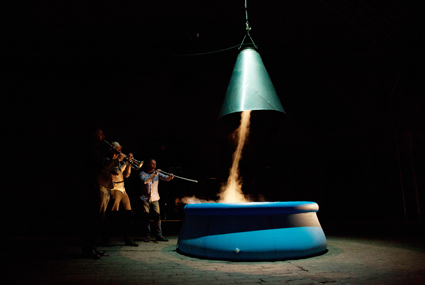
Cameron Robbins, Cloudscape, opening night performance by Graeme Leak, Tim Humphrey, Cameron Robbins Gauge
photo Pia Johnson
Cameron Robbins, Cloudscape, opening night performance by Graeme Leak, Tim Humphrey, Cameron Robbins Gauge
AN EXHIBITION SPACE WITH LESS LIGHT I CAN’T RECALL. IT PRODUCED A STRIKING, ‘DECELERATING’ BEGINNING TO THE EXPERIENCE OF GAUGE AT THE ARTS HOUSE MEAT MARKET VENUE.
I spent several minutes standing still as my eyes adjusted to the dark, relishing the blackness and letting the burnished glow of the works, distant across the far side of the long hall, slowly come into focus. I noticed a quiet ticking—drips, I’d discover, from The Dripolator. Such was my entry to this show, standing in the dark, thinking about time.
Gauge, presented in the Wunderkammer tradition, was an extensive program of works, events and performances, a few of which I can mention here.
Graeme Leak’s sound/light sculpture The Dripolator was a striking feature of the show. The self-performing instrument is topped by a light that melts a chunk of ice which drips into a miked-up resonant reservoir. The sound is diffused through the space via surround sound, with the voices of audience members musing about the work subtly captured and mixed into the underlying soundscape, sometimes to the amusement of attentive listeners.
Rosemary Joy created the most thematically didactic work, also the most effective in provoking thought about water economics. Two boxes stand side-by-side, one the size of a matchbox, the other a microwave oven. Understated labelling reveals that these are scaled representations of the water reserves for London and Melbourne. The text includes information about relative population size and the projected period that reserves might need to serve in case of drought: six weeks and up to five years respectively. In front of the boxes is a music stand with a score. On the opening night a lively performance in the contemporary classical idiom was given, using the boxes as percussion instruments.
The exhibition’s creators, Madeleine Flynn and Tim Humphrey, created the show’s centrepiece, an installation titled Waterpiano, featuring a decrepit and lidless miniature grand piano. Drips from the ceiling high above catch the light as they fall onto the piano’s exposed strings. The catalogue explains that a weather station installed on the roof and connected to a rainwater tank, pump and computer, causes the piano to ‘perform the weather.’ The work was inspired by Dr Michael Roderick’s work on global water cycles and discussions with Computer Scientist Dr Adrian Pearce about systems and reasoning in artificial intelligence.
In a departure from the predominantly antique aesthetic, Cameron Robbins created Cloudscape: a 2,700L vinyl pool, a fan and an ultrasonic humidifier (appearing as a tall exhaust hood suspended above the pool). Wisps of smoke play around the space between the pool and hood creating a beguiling fog and making this work a clear favourite with younger audience members. A performance around the pool by Leak, Humphrey and Robbins (with Flynn playing shadowy puppet master on ‘vortex control’) culminates in a misty tornado as the rapidly circling musicians create a spinning column of air. The slow start, with the players seeming to call to the spirit in the water before building a whirling crescendo, evoked the sense of a mystical spell, quite in keeping with the Meat Market’s 19th century aesthetic.
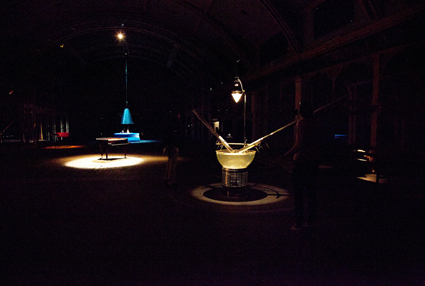
Gauge, installation
photo Pia Johnson
Gauge, installation
Stepping away from the works and out into the blackness of the cavernous hall, a particularly interesting dimension of the exhibition gained presence. Flynn and Humphrey, with deft input from sound designer Michael Hewes, had created a subtle soundscape, more an underlying ambience than a soundtrack. Ghostly echoes of sounds from the works and from the audience remained enigmatic. Those who recognised the sound-on-sound tape loop system sitting to one side might have appreciated it as the modest star of Gauge—allowing successive layers of sound to accrue and old sounds to slowly subside into a bottomless chasm of time. Standing on the periphery, one could watch the audience circulate and interact, plucking the strings of the piano, sloshing around in Joy’s mud-bath hand basin or discussing the operation of The Dripolator. The ambiguity and openness of the works to interaction was encouraging. As many of the exhibitors are also musicians, they understand better than many that interactive art finds an excellent model in the performativity of musical instruments.
The project has several premises, including the artist-scientist interaction and the exploration of the water cycle. The interaction with the scientists remained somewhat opaque, and perhaps there was room for further illumination about this intriguing topic. The theme of the water cycle was handled with a gentle touch, with the artists incorporating empirical material into poetic expressions. The delightfully realised theatre of wonder, the Wunderkammer, inspired audience curiosity, play and wonder about water and its systems, creating a space where materials, aesthetics and experiment were in close proximity.
A possible criticism is that the Wunderkammer aesthetic signifies the world of the pre-digital museum. The works are lovely—indeed, hand-labelled timber display cabinets are a welcome respite from touch-screens and voice-overs. But it is difficult to place them in the present, when the politics of this type of display have been so heavily worked over and reframed. Gauge feels naïve in its staging. Melbourne art-science outfit Scale Free Network also presented a Wunderkammer at Counihan Gallery in 2012 offering more hands-on experience for the audience, perhaps giving them greater agency.
However, standing in the dark, hearing ‘the drip of time,’ seeing the water slowly, ‘destroy’ the Waterpiano and the ice melt in The Dripolator, thoughts turn to the sublime in the face of the ephemerality of humans in contrast with water, which as the Gauge catalogue reminds us, is a constant quantity and which will doubtless outlast us.
Arts House: Gauge, creators, directors Madeleine Flynn, Tim Humphrey, with Graeme Leak, Rosemary Joy, Cameron Robbins, Dr Michael Roderick, Dr Adrian Pearce, lighting design Jen Hector, sound design Michael Hewes, Arts House, Meat Market, Nov 15-21, 2012
RealTime issue #113 Feb-March 2013 pg. 41
© Bruce Mowson; for permission to reproduce apply to realtime@realtimearts.net
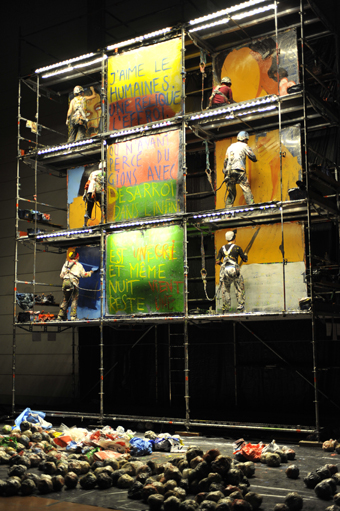
Blank Page, Compagnie Luc Amoros
photo Philippe Gisselbrecht
Blank Page, Compagnie Luc Amoros
THE BLANK PAGE HAS LOOMED LARGE IN THE WESTERN IMAGINATION SINCE THE ARRIVAL OF THE GUTENBERG PRESS, A SYMBOL BOTH OF LIMITLESS POTENTIAL AND THE VAGARIES OF THE CREATIVE MIND: A NOVEL OR ESSAY ABOUT TO BE BEGUN, THE CRUSHING EMPTINESS ENGENDERED BY A BAD CASE OF WRITER’S BLOCK. THE BLANK PAGE MAY ALSO CONTAIN A SECRET HISTORY, LIKE THE PALIMPSESTS OF THE ANCIENT GREEKS AND ROMANS, WORDS AND IDEAS OF OTHER TIMES AND OTHER MINDS HAVING BEEN SCRATCHED OR SCRUBBED OFF TO MAKE WAY FOR THE NEW.
The 2013 WOMADelaide festival will feature French company Compagnie Luc Amoros’ multidisciplinary performance Blank Page (Page Blanche). Nine revolving Perspex screens housed within a 10×10 metre scaffold provide the performance’s tabula rasa upon which six actors create an ever-changing series of words and pictures. Up to 300 kilograms of paint are used in one hour as the kaleidoscopic procession of images and disembodied phrases evokes the work of Gauguin, Van Gogh and Warhol, the Altamira cave paintings, graffiti and propaganda art. No sooner has one image emerged than another has been wiped away with kerosene, the panel then painted black in preparation for a new pictogram or a statement, perhaps one like this: “The world only exists if it is painted and sung.”
The performers not only paint, but interact through song, chant and dance with a part live and part pre-recorded soundtrack which features electric and double bass played onstage. There are traces, in Richard Harmelle’s soundscape, of Arabic chants, African rhythms and the music of the Polynesian islands.
Company founder Luc Amoros says that the music in Blank Page is “more about a musical translation than a simple accompaniment.” It is all part, he explains, of an attempt to create what he calls “a living stage,” a street space—never a theatre—in which a sort of alchemical meeting of the written, visual and performed arts can take place before an audience who never quite know what to expect: “A street is less cramped than a room. There are other dimensions there. The gaze of the spectator is not necessarily the same. In the theatre, the spectator expects something; in the street, anything can happen.”
Amoros, unable to abandon the metaphor of the book despite Blank Page’s sinuousness of form, says that the show moves through five distinct though disparate “chapters”: “the aesthetic universes of the ancient Mayan and Aztec civilisations; the birth of the painting and, with it, the self-portrait; the everyday poetry that has developed among the people, such as Brazil’s Cordel street literature [inexpensive publications often in verse. Eds]; Hiroshima and the Holocaust; the painting of Paul Gauguin.” It seems just as likely—and Amoros does not reject this—that audiences will see gestures towards other stories in the work. It is difficult, for instance, not to be reminded of the transient words and images which once adorned the Berlin Wall, or that now appear as rejoinders to the injustices of partition and dispossession upon the bricks of the West Bank barrier.
I put it to Amoros that Blank Page is a performance that seems as much about loss as creation, about the Orwellian destruction of history and language. “It’s about people and languages,” he tells me, “languages that nobody speaks, that are lost forever. Those which are still alive can find refuge in writing, sheltered from oblivion.” Amoros recounts the (probably apocryphal) story of Humboldt’s parrots, the last living creatures capable of reproducing the language of the massacred Maypure tribe. “This performance speaks of nothing directly, not even Hiroshima,” Amoros says, “but we invite the spectators to reflect on the disappearance of languages.”
Luc Amoros is the author of all of the text which appears in Blank Page in a variety of languages throughout the performance. Audiences might be asked, “Sixty years after Hiroshima, how can we watch fireworks on Bastille Day?” One might just as easily enquire, “How can we go into German souvenir shops and buy pieces of the Wall?” I rephrase this for Amoros who seems reluctant to brand—if that is the word I want—Blank Page as anti-free market, a swingeing reproof of the capitalist logic which ‘ended history’ in 1989 and requires that everything, as long as it is at the right price, is for sale. Amoros says, “We make images on the stage to provoke and to preserve. We do not sell them, as is the case with most images we are faced with today. Compared to cinema, or the visual arts, our speciality is a direct, physical relationship with the public.”
WOMADelaide: Compagnie Luc Amoros, Blank Page, design, text, staging and images Luc Amoros, music Richard Harmelle, Botanic Park, Adelaide, Mar 8-11; www.womadelaide.com.au
RealTime issue #113 Feb-March 2013 pg. 42
© Ben Brooker; for permission to reproduce apply to realtime@realtimearts.net
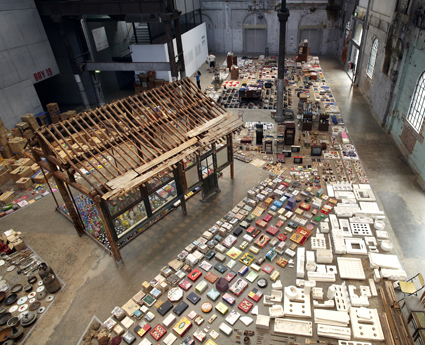
Song Dong, Waste Not, installation Carriageworks
photo courtesy Carriageworks
Song Dong, Waste Not, installation Carriageworks
ALTHOUGH THE WORLD CAN BE FRIGHTENING AND FRUSTRATING, DIFFICULT AND DANGEROUS, SOMEHOW PEOPLE QUIETLY FIND PERSONAL WAYS TO ENGAGE IT, ACTUALLY COOPERATE WITH AND MAKE THE BEST OF IT.
One achingly human example of someone trying to make the best of a difficult world has been made visible—as a vast, walk-through installation on the floor of Carriageworks in Sydney.
Chinese artist Song Dong’s Waste Not is big. But it’s not just the physical extent of the collection that conveys something vaguely melancholic as you walk around it. It’s really (much more than its profuseness) the staggering modesty of those 10,000 objects within it; worn out everyday domestic bits and pieces of a type that most Australians would send, not to St Vincent de Paul, not wholly to the yellow-topped recycle bin, but straight to landfill. Cheap, chipped, patched, scuffed, busted, battered, rusted; folded, sorted, stacked, boxed, bundled, bagged, tied, sacked…but above all, saved. It’s what decades of soul crushing ‘make do’ looks like when you spread it out on a floor—and in this thought there is some sadness.
waste not
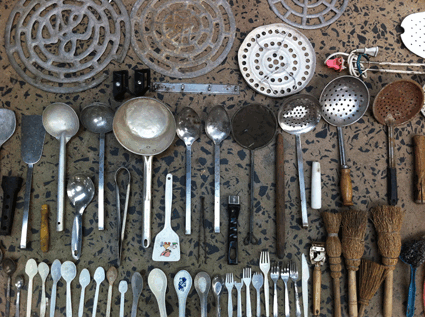
Song Dong, Waste Not, Carriageworks (detail)
photos Graeme Smith
Song Dong, Waste Not, Carriageworks (detail)
The exhibition title derives from ‘wu jin qi yong,’ a life-guiding phrase that underscores the traditional Chinese virtue of frugality. According to Song Dong, the dictionary explanation reads, “anything that can somehow be of use, should be used as much as possible. Every resource should be used fully, and nothing should be wasted.”
Song Dong’s Waste Not has, at its conceptual starting point, the hardships of his family, in particular those of his mother, Zhao Xiangyuan, who, in struggling with the shortages and political insecurities of China’s Cultural Revolution, turned to extreme frugality (along with a whole generation of Chinese) to cope and survive. One of the texts in the exhibition written by Zhao Xiangyuan in 2005 recounts in heart-breaking detail the tedious steps she needed to take just to save on soap. She concludes, “I was afraid when my children grew up, they would have to worry about soap rations every month, as I had. I wanted to save the soap until the children got married, then pass these on to them. I never thought they would become useless, because now of course, everyone uses a washing machine. But I couldn’t bear to throw them all out, so I have kept them for a few decades now. Some of that soap is older than Song Dong.”
Song Dong writes, “In that period of insufficiency, this way of thinking and living was a kind of a ‘fabao,’ literally translated as a ‘magic weapon,’ but in times when goods were plenty, the habit of ‘waste not’ became a burden.” “…[M]y mother not only refused to throw away her own things, but wouldn’t allow us to throw anything away either.”
When Zhao Xiangyuan’s husband died in 2002 she had an emotional breakdown, and as her hoarding habit became even more extreme, Song Dong decided to pull her “out of her isolated and grief-stricken world and give her a breath of fresh air…”
Fresh air came in the form of a mother and son collaboration in which the mother became artist and the son, assistant—allowing her to have a “space to put her memories and history in order” by arranging her collection at the beginning of every exhibition. Since Zhao Xiangyuan’s death in 2009, Song Dong’s sister, Song Hui, and wife, Yin Xiuzhen, work with him to reconfigure each new installation.
rituals of engagement
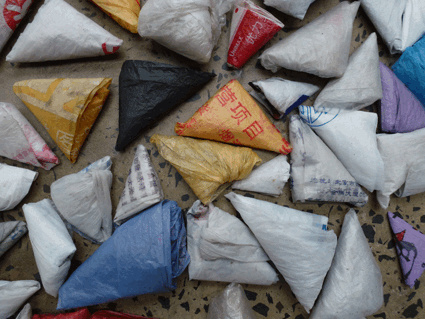
Song Dong, Waste Not, Carriageworks (detail)
photos Graeme Smith
Song Dong, Waste Not, Carriageworks (detail)
A human way of trying to cooperate with a difficult world is evident in a commonplace medical disorder.
My understanding (personal, non-medical) of obsessive-compulsive disorder is that it works in a surprisingly real sense as a type of interior magic act. Example: “If I count the steps on this staircase and the number is divisible by three—all will be well, I’ll be safe, ‘it’ won’t happen, I can put my mind at rest and the anxiety on hold.”
The problem is in the repetition. No matter how many times you repeat the ritual—staircase-mathematics, hand-washing, lock-checking, newspaper-hoarding, silently reciting a special incantation, scratching your left ankle five times…whatever your particular routine—the relief from anxiety is fleeting and you never reach that safe place you desperately need to inhabit.
It’s both fascinating and sad to think that, not just an isolated individual, but a whole generation can also be compelled out of desperation to turn to this type of interior ritual, magic weapon, hoarding routine, whatever you prefer to call it—to engage with an uncooperative world.
An introductory panel at the exhibition suggests that Waste Not is both a meditative space for contemplation and self reflection, and a gesture to the richness of family life and memory,” and it did have me doing so: meditating on that richness found in all that patched up, battered and bundled stuff; and also on how Zhao Xiangyuan’s obsessive collecting could be transformed into a more liberating form of ritual—all those reconfigurations of her 10,000 common household objects on gallery floors.
Carriageworks with 4A Centre for Contemporary Asian Art in association with Sydney Festival: Song Dong, Waste Not, Carriageworks, Jan 5-March 17
RealTime issue #113 Feb-March 2013 pg. 44-45
© Graeme Smith; for permission to reproduce apply to realtime@realtimearts.net
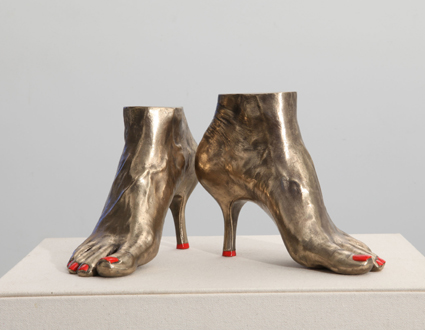
Julie Rrap, Stepping Out, 2012
photo courtesy the artist
Julie Rrap, Stepping Out, 2012
IF PLURALISM IS NOW A DEFINING FEATURE OF APPROACHES TO GENDER AND SEXUALITY IN THE WORLD OF ART, PERFORMANCE AND THEORY, CAN THE SAME BE SAID OF THE BROADER CULTURE GENERALLY? IN RECENT YEARS, WE’VE WITNESSED AS A STRONG RETURN TO TRADITIONAL VALUES, PLACING MARRIAGE, FAMILY AND THE DOMESTIC IN THE ASCENDANCY, THAT THE PROVOCATIONS OF ART CAN AT TIMES FEEL AT CROSS PURPOSES WITH LIFE. YET IN SUCH A CLIMATE THESE PROVOCATIONS CAN ASSUME EVEN GREATER IMPORTANCE AS THE DESTABILISING POWER OF THE ARTWORK REINSTATES THE FLUID NATURE OF IDENTITY THAT NORMATIVE VALUES CAN DENY.
It was this desire to highlight the range and breadth of contemporary approaches to gender and sexuality, and their capacity to move viewers into more uncertain, interstitial territory, that defined the SEXES exhibition at Carriageworks late last year. The combined interests of Performance Space curators Bec Dean and Jeff Khan along with an effervescent guest curator, artist Deborah Kelly, produced a smorgasbord of works. In an exhibition of visual art by 17 artists complemented by a Live Art program of talks and performances, the works reflected varying takes on contemporary feminism(s), masculinity studies, queer theory and the challenging of gender constructions through tropes of cross-dressing and drag.
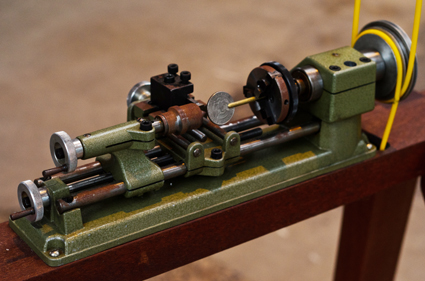
Drive Shaft (2012), Marley Dawson
photo Lucy Parakhina
Drive Shaft (2012), Marley Dawson
While a serious interdisciplinary survey of these themes has been long overdue in Sydney, there were some surprises in the shape and form SEXES took. Most striking for me was the decision to go beyond a photomedia approach, which allowed for a broader representation of mediums but also meant that the connection of some works to the theme wasn’t immediately obvious, challenging the viewer to think laterally. A number of installations, for example, explored themes of the body via the unconventional route of site-specific architectural interventions. Marley Dawson’s Drive Shaft (2012) re-activated the building’s defunct line shafts to power a small lathe that ground the sharp tip of a metal rod against a silver coin, obliquely incorporating allusions to capital and industry into a sexual metaphor. Perhaps most successful in this respect was Cigdem Aydemir’s Site Occupied 2 (2012), a Christo and Jeanne-Claude style wrapping of a corridor in black fabric that created an immense sculptural burqa. As visitors could literally walk through the burqa, the experience offered an uncanny and demystifying encounter with the bodily interior of the ‘other’ as movement through the corridor caused the fabric walls to sway gently, rendering the solid architecture fluid.
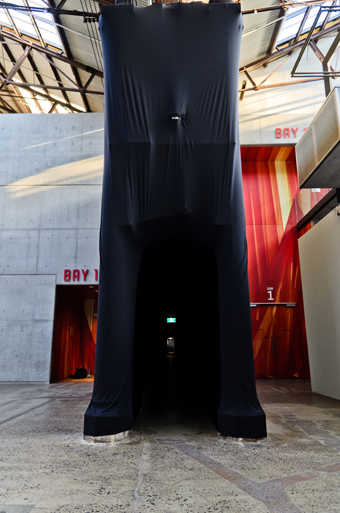
Site Occupied 2, Cignem Aydemir
photo Lucy Parakhina
Site Occupied 2, Cignem Aydemir
An arresting visual focal point in the foyer space was Trevor Fry’s subversive ceramics installation, Evil Flowers (2011-12), a scabrous array of fertility deities, ritual urns, vessels and phallic plant-like forms drizzled with paint and installed atop a crumbling temple platform. Informed by a queer aesthetic rather than commenting directly upon queer issues, this direct affront to the politeness of ceramics was seductive, visceral and transgressive in its profane elevation of dirt and filth. A low-fi video embedded beneath the platform’s rubble presented a parodic documentary of the artist’s studio process in which he took sensual delight in his work to a new level as he caressed and fornicated with his ceramic creations.
Other works emphasised the unstable nature of sexual identity as it plays out in performative art practices. This was a key theme in the festival’s keynote lectures, delivered by Professors Anne Marsh and Ed Scheer, and became a lively point of conversation when the audience debated an early Kingpins work in which the artists’ drag performance as male gangsta rappers at an academic conference alienated a group of American feminist theatre scholars (they walked out, apparently). Those present at the lectures were unable to agree whether the offence taken was about gender, race, class or culture. Similarly, this slippery and multidimensional approach to gender hacking was apparent in the Kingpins’ new video The World (2012). In an absurd, pastiched television advertisement for Dubai, the all-female collective cross-dressed as an array of composite ‘exotic’ characters satirising the stereotypes that permeate the tourism industry and the fantasies underpinning the creation of bloated consumer cities.
If the Kingpins video was provocative but not necessarily confronting, the latter was certainly true of Eric Bridgeman’s large-scale floor installation, All Stars (2012). In a cordoned-off section of the public foyer Bridgeman presented a team of free-standing illustrated portraits of naked gay male porn stars with erect penises spliced with the faces of Australian football stars, suggesting parallels between the two as examples of hyper-masculinity influenced by the fantasies of their audiences. Bridgeman sought to emphasise rather than downplay the sexuality of the figures as a rebuke to current efforts to “clean up” sex in sport and “to dispel the myth that sex has no place in sport.” In the final weeks of the exhibition, Bridgeman covered the heads of the players with red sacs which made clearer the anti-censorship message yet in making the men resemble torture victims, they also seemed to unleash an atmosphere of latent aggression in the space. Somewhat counter to Bridgeman’s intended critique of the curbing of sex in sport as a conservative development, it was also possible to detect in these figures the ease with which hyper-masculine expressions of sexuality can slip towards violence, which arguably bespeaks the need for standards that discourage a misogynistic culture.
Inside Bay 19, the more private exhibition space was sporadically activated by performances in the extensive Live Art program. It was during the last week of the festival that I caught a pair of performances that were particularly powerful in confronting taboos around the female body. In a reprisal of her humorously incendiary monologue My Cunt (1996), Maude Davey channeled a burlesque energy as she addressed the audience in towering stiletto heels and dazzling diamante jewels but otherwise nude. Her stirring tour-de-force delivery of cunt stories and anecdotes succeeded in reclaiming the term from its effaced position. In the dance work that followed, Monster Body (2012), emerging choreographer Atlanta Eke and fellow dancer Emma Kim Hagdahl stalked the space with movements that oscillated between graceful ballet steps and animalistic writhings, their voices filling the air with guttural groans. A daring juxtaposition of the cultural with the primordial, the work drew attention to both the disciplining of the body in dance and the mechanisms of self-control that underpin a woman’s identity.
It was fitting that these brave feminist interventions were performed amid works by artists that included two of the towering female presences in contemporary Australian art, Tracey Moffatt and Julie Rrap, who explored themes of the gaze and the body respectively. In Moffatt and Gary Hillberg’s Other (2009), charged moments of interracial encounter plucked from cinema history were edited together in a rapidly paced video montage highlighting the role that desire for the exotic plays in the construction of the western sexual imaginary. Nearby, in Julie Rrap’s Hair Rail (1992), attached to the wall were two slender plastic tubes encasing a dense weave of human hair that bore an uncanny resemblance to wooden ballet bars, embodying a delicate tension between repulsion and attraction. It was a tension similarly present in Rrap’s Stepping Out (2012), a pair of glamorous gold feet rendered achingly deformed thanks to the stiletto spikes jutting from the underside of each heel—a wry comment on the fine line between pleasure and pain in contemporary ideals of beauty.
While it’s not possible to cite here all the compelling and saucy works presented in SEXES, it is worth concluding with Paul Knight’s photographic slideshow Falling Sideways (2012), an unflinchingly explicit, diaristic record of the artist’s relationship with his partner, Peter. Set to a pulsating soundtrack, unaffected snapshots of their private sexual encounters are juxtaposed with images of the banal minutiae of their domestic life which mediate the pornographic aesthetic. The work was a powerful reminder that it is ultimately within daily life and encounters between people that sexual identities and gender relations are negotiated.
If I left SEXES feeling that any singular overarching statement had been diffused by the event’s pluralistic approach, it also seemed this diversity was its strength. The challenge is for these provocations to cross over. For it is within the realm of day-to-day life, where sexually conservative policies and attitudes are barely batting eyelids right now, that broader, more open and progressive approaches like these are most urgently needed.
SEXES by Performance Space, curators Bec Dean, Deborah Kelly, Jeff Khan,
Carriageworks, Oct 26–Dec1, 2012
RealTime issue #113 Feb-March 2013 pg. 46
© Ella Mudie; for permission to reproduce apply to realtime@realtimearts.net
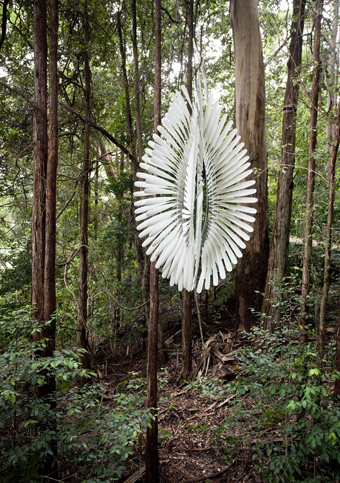
Steven Shorts, Sea Pods (2012), PVC pipes hanging from the ancient rainforest canopy
These days if you’re looking for adventure there’s no need to restrict yourself to the world we live in; there are so many others to choose from. One that might have skipped your attention lies in the otherworldly landscape of the Blue Mountains of NSW.
April-May is the time to explore our very own Jurassic Park along the diverting pathways of Scenic World in the Jamison Valley where the pleasures of nature mingle with a variety of artists’ responses to the environment.
A group of notable judges has made a selection from the many responses to the event’s annual call-out for Sculpture at Scenic World. This year, Exhibition Manager Lizzie Marshall says the exhibition includes, “36 artworks that respond to and reflect the rainforest through various media including digital, sound and light, together with collaborative works.” The exhibition features artists from around Australia and also from the US and Ireland.
Says Marshall, “The artworks will be installed along the longest boardwalk in the Southern Hemisphere at 2.4km, through the Jamison Valley floor and directly below the Three Sisters. The exhibition will also include the inaugural Sculpture Otherwise, a collection of indoor works by the 2013 artists.”
There are guided and independent tours,
lectures and a comprehensive public program including family and children’s activities.
At the official opening on April 24 the winner of the $20,000 Scenic World Acquisitive Award will be announced. The exhibiting artists will also select a $5,000 Artist Peer Award. RT
Sculpture at Scenic World, April 24-May 19, www.scenicworld.com.au
RealTime issue #113 Feb-March 2013 pg. 46
© Virginia Baxter; for permission to reproduce apply to realtime@realtimearts.net
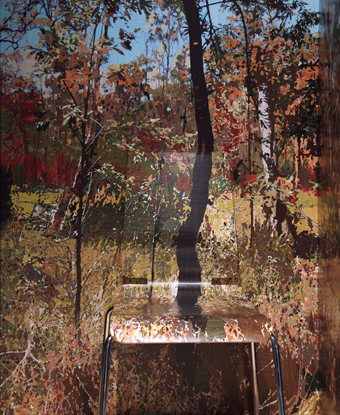
Gary Carsley, D.98b (UTS dub), (detail)
photo David Lawry
Gary Carsley, D.98b (UTS dub), (detail)
NOTWITHSTANDING ITS RATHER CRYPTIC TITLE, SWEDISH FOR ARGUMENT WAS AN INCISIVE AND ENTERTAINING GROUP EXHIBITION THAT CATALYSED THE MODEST SPACE OF THE UTS GALLERY TO TACKLE A GIANT, THAT UBIQUITOUS SWEDISH HOME RETAIL BRAND THAT EVERYONE LOVES TO HATE: IKEA.
Bringing together an eclectic mix of specially commissioned and pre-existing artworks from eight local and international artists, the exhibition presented a stimulating array of responses to the many facets of the brand from its ‘democratic design’ philosophy and complex global material supply chain to its tightly engineered retail spaces and the uses and abuses of its products by consumers. All this provided rich fodder for works across video, mixed media installations, sculpture, graphic design, conceptual interventions and even a hands-on re-purposing design workshop.
Given that artists can be ambivalent at best toward purveyors of mass production, I anticipated the show might prove fairly derisive in tone. Gladly, curator Holly Williams steered clear of reductive negativity in her selection of works with many revealing a surprising level of subtlety and nuance in their responses. Exemplary in this respect was Jess Olivieri’s video, Like A Salmon (2012). With a covert camera jerry-rigged to a shopping trolley, the artist and collaborators filmed a journey through an IKEA store, deliberately navigating its aisles against the directed flow of pedestrian traffic. The slightly nauseous sensation produced by this counter-intuitive movement drew attention to the highly controlled nature of the IKEA retail space. Yet the addition of some whimsical movements and a soothing classical music soundtrack reminiscent of those accompanying in nature documentaries combined to create a strangely mesmerising and dreamlike subliminal landscape.
The temptation to intervene into the IKEA retail space proved attractive to a number of artists. Israeli artist Guy Ben-Ner’s video Stealing Beauty (2007) presented an extreme example—a subversive, Marxist-inflected family drama compiled from unauthorised filming of the artist’s own family inhabiting various IKEA showrooms. More subtle was Michele Pred’s You Are What You Buy (2009), which saw the artist secretly replace 10 generic poster prints at a local IKEA with her own original artworks. Shoppers unwittingly bought Pred’s prints unaware of their provenance and the fact that when their QR code design was scanned it led directly to an anti-consumer website.
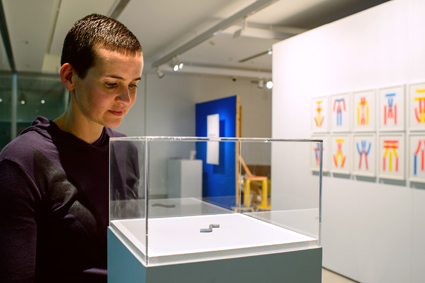
Emma White Nice Try, DIY 2012, polymer clay, object modelled to scale
photo David Lawry, courtesy the artist and BREENSPACE, Sydney
Emma White Nice Try, DIY 2012, polymer clay, object modelled to scale
Installation-based approaches took more material aspects of the IKEA experience as starting points for their investigations. Emma White’s fastidious silver polymer clay model of the Allen key ironically elevated this icon of self-assembly to the status of semi-precious object by presenting it on a tall white plinth encased in clear Perspex. Gary Carsley papered an exquisite photographic monoprint of an Australian bush landscape onto an IKEA stool, chair and a two-door wardrobe, seamlessly collaging the chair into the wardrobe to create a striking trompe l’oeil effect. This melding of a familiar Australian scene with iconic Swedish pinewood furniture provoked reflection on the displacement of the local in global supply chains and raised questions over the status of the ‘natural’ and the ‘real.’
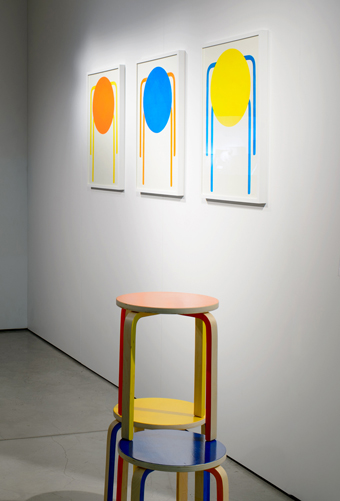
Lorenzo Bravi, IKEA PRESS Frosta 1
photo David Lawrey
Lorenzo Bravi, IKEA PRESS Frosta 1
The title of Carsley’s work, D.98b (UTS dub), also cited the gallery’s location which sits within the UTS Faculty of Design, Architecture and Building. This design lab setting also offered an ideal context for artist and graphic designer Lorenzo Bravi’s IKEA Press series (2011-12). Comprising letterpress prints stamped from dismantled IKEA product parts and rendered in bold primary colours, Bravi’s prints were a playful and experimental response to the generative possibilities of modular design.
The setting was also cleverly activated by the IKEA Recovery Workshop. Prior to the exhibition, curator Holly Williams trawled Sydney streets to retrieve a stockpile of dumped IKEA furniture—offering a disturbing insight into the disposable mindset their low prices have engendered. Expanding their life span just a little longer, RMIT lecturer Scott Mitchell led a “re-purposing” workshop with staff and students combining ideas to transform the dumped items into makeshift furnishings that ranged from surprisingly elegant to more zany and unconventional solutions.
It seemed the workshop participants had more success with their building project than artist Tony Schwensen did in TransScandinavia (2006). In a video documentation of a live performance in which Schwensen attempted assembly of an IKEA flatpack wardrobe without instructions, his futile efforts lampooned the masculine ideal of the handyman. At the other end of the spectrum, Dutch artist Helmut Smits successfully put his fire-making skills to practical use in an urban survival scenario in FLAMMA (A Basic Need) (2008). In this no-fuss instructive documentary, Smits lit a crackling fire using only IKEA products (and no matches), a subtle satire of the “back-to-basics” image of Swedish culture.
Overall, there were many charming details in Swedish for Argument. IKEA product tags stood in for wall plaques, IKEA couches and chairs were dispersed throughout the space and wall partitions recreated the store layout. Yet the incorporation into the gallery of the very products which the artists sought to grapple with in their works also encapsulated the contradictory mix of ambivalence and desire which the brand is so capable of arousing. This was a fittingly multivalent exhibition for a brand whose status as a textbook phenomenon of design globalisation belies the complexity of its organisation, impact and remarkably polarised reception.
Swedish for Argument, curated by Holly Williams, UTS Gallery, Sydney, 23 Oct – 34 Nov, 2012.
RealTime issue #113 Feb-March 2013 pg. 47
© Ella Mudie; for permission to reproduce apply to realtime@realtimearts.net
THIS GIVEAWAY OFFER IS NOW CLOSED.
Marina Abramovic, Madman DVD
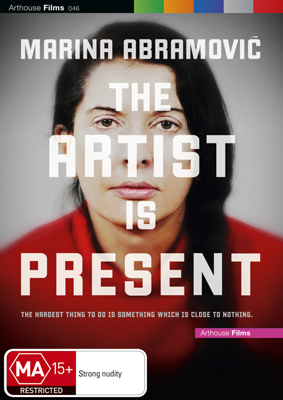 Applauded at film festivals and widely seen on television, this documentary on one of the most dedicated and enduring performance artists of the last 30 years, Marina Abramovic, The Artist is Present is an engrossing, sometimes perplexing and moving film. It documents the preparations for and the exhibiting of a retrospective and a new performance by Abramovic at New York’s MoMA in 2010. Virginia Baxter writes, “In 106 minutes Akers and Dupré expose for the viewer something of the emotional, physical and intellectual demands inherent in mounting an exhibition and performance that deal in the power of the present. In the process they also offer insight into the life’s work of a remarkable artist” (see article).
Applauded at film festivals and widely seen on television, this documentary on one of the most dedicated and enduring performance artists of the last 30 years, Marina Abramovic, The Artist is Present is an engrossing, sometimes perplexing and moving film. It documents the preparations for and the exhibiting of a retrospective and a new performance by Abramovic at New York’s MoMA in 2010. Virginia Baxter writes, “In 106 minutes Akers and Dupré expose for the viewer something of the emotional, physical and intellectual demands inherent in mounting an exhibition and performance that deal in the power of the present. In the process they also offer insight into the life’s work of a remarkable artist” (see article).
5 copies courtesy of Madman Entertainment
Creative Minds, Madman DVD, 2 discs
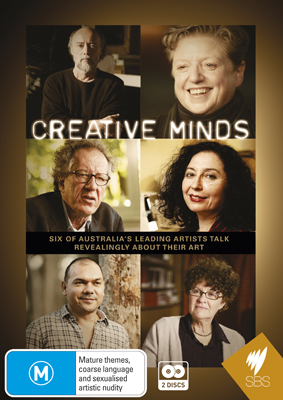 Creative Minds is a six-part Madman/SBS series of interviews with artists Bill Henson, Kate Grenville, Robyn Archer, Elena Kats-Chernin, Stephen Page and Geoffrey Rush. In-depth interviews with Australian artists are a rarity, and these have the benefit of excellent supporting footage, for example photographer Henson working on his moodily expressive night-time landscapes. Director Robin Hughes’ quietly phrased and sometimes probing questions yield insights into the creative mind. RT
Creative Minds is a six-part Madman/SBS series of interviews with artists Bill Henson, Kate Grenville, Robyn Archer, Elena Kats-Chernin, Stephen Page and Geoffrey Rush. In-depth interviews with Australian artists are a rarity, and these have the benefit of excellent supporting footage, for example photographer Henson working on his moodily expressive night-time landscapes. Director Robin Hughes’ quietly phrased and sometimes probing questions yield insights into the creative mind. RT
10 copies courtesy of Madman Entertainment
Email us at giveaways@realtimearts.net with your name, postal address and phone number.
Include ‘Giveaway’ and the name of the item in the subject line.
Please nominate only one giveaway.
RealTime issue #113 Feb-March 2013 pg. 48
© RealTime ; for permission to reproduce apply to realtime@realtimearts.net
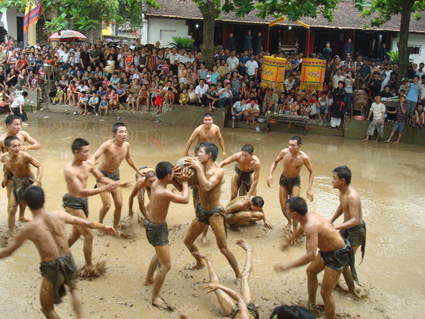
Muddy Wooden-Ball Competition (2009), Vu Tu Quye
THE INAUGURAL INTERNATIONAL ANTHROPOLOGICAL FILM FESTIVAL IN HO CHI MINH CITY WAS CURATED ON THE THEME OF MODERN SOCIETY AND SUB-CULTURES. HELD AT HCMC UNIVERSITY OF CULTURE, HCMC UNIVERSITY OF SOCIAL SCIENCES & HUMANITIES AND THE VIETNAM FILM RESEARCH & ARCHIVE CENTRE, IT ATTRACTED LARGE AUDIENCES OF STUDENTS, TEACHERS, FILMMAKERS AND JOURNALISTS.
Its global reach was wide, bringing together over 50 recent documentaries and classic ethnographic films produced across Vietnam, Australia, Cambodia, Canada, China, Germany, Japan, Nepal, Papua New Guinea, Philippines, Serbia, Thailand, Turkey, UK, West Papua and several African countries.
The energy of cultural exchange and shared consciousness is a significant quality that visual ethnography offers the documentary tradition. It is also a mode of filmmaking with a strong foundation in Vietnam and in its tertiary education. Vietnamese visual ethnographers are making films from perspectives within their own culture, not as observers representing ‘the other’
—perhaps as a consequence of having achieved liberation from French and American colonisation. Also, it is not surprising that many of the films are working through complex issues around tradition and modernity given the largely agrarian population and its multi-ethnicity—with over 50 distinct groups, each with its own language and cultural heritage.
A significant aspect of the festival was the in-depth discussion after each film. Often two hours long, these were insightful and philosophical, each film providing a doorway into culture, history, politics and society. I wondered whether this depth was connected to visual ethnography itself or Vietnamese culture and the education system. It is a rare film festival that allows such spacious time for dialogue; all too often the market place, the schedule and the sheer volume of documentary ‘product’ rule. Yet despite these open-minded discussions, censorship in Vietnam is a real issue, with some of the festival’s local and international films being banned or cut, sometimes at the very last moment. Nevertheless, the organisers stoically adapted the program in response to this state intervention.
navigating the old and new

The Old Man who Sells Bananas (2012), Tu Thi Thu Hang
It’s interesting that Love Man, Love Woman (2007), by Nguyen Trinh Thi, proved unproblematic for the censor, while some other films became forbidden fruit. The film reveals intricate layers around homosexuality and gender in Vietnamese culture by following Master Duc, a gay shaman who serves in a ‘Mother Goddess’ temple. Here the filmmaker brilliantly observes the raunchy, transgressive sexual humour of Duc and his followers. In the subsequent discussion it was suggested that gay sexuality, contained within the tradition of ‘Mother Goddess’ worship, is accepted in Vietnamese society.
Tu Thi Thu Hang structures her film, The Old Man Who Sells Bananas (2012), so that the audience starts out with ‘her’ mis-perception of the Old Man. We see him as a victim too—he seems poor, elderly and abandoned. Skillfully filming with him over one and a half years Hang draws us closer into this man’s life, step by step—from lone individual to family man, to respected wise elder of the village with his Confucian ethics and responsibilities. In discussion the filmmaker describes her process: “Now I have a completely different way of looking at him.” (And so do we). “He is the ‘last man’ who lived in a previous epoch. In his 84 years he has lived through the French and American occupation, and liberation. He has passed through the main eras of Vietnamese history. He has applied traditional wisdom to develop what is an ethical way to live.”
Similarly, Xich Lo in the Ancient Town (2010), by Truong Thi Thuy Ha, explores tradition and modernity by documenting ‘Old Hanoi’ and the invention of the Xich Lo (rickshaw) by French colonists. In an elegantly concise 30 minutes the filmmaker documents the history of French occupation of Hanoi, and through interviews with Xich Lo drivers working today she introduces the viewer into their world. We learn of their sustaining cultural values, their philosophy. Her subjects are well chosen. They become cultural commentators, as if they too are anthropologists of their own lives and work with insight into the cultural value of the Xich Lo beyond ferrying tourists. As the carrier for Vietnamese wedding ceremonies the driver becomes the pivot between ancient fertility traditions of the marriage ceremony and modernity. The film, too, is a text navigating between ‘old’ and ‘new’, encouraging the cultural survival of meaningful tradition.
Muddy Wooden-Ball Competition (2009), by Vu Tu Quyen, also navigates tradition and modernity, in Van village, Bac Giang province. Beautifully filmed, with a luminous observational and poetic camera, the filmmaker follows this traditional ball competition to open up complex structures in village society and the place of elders, women and youth in a transforming culture.
the anthropological imagination
The festival demonstrates that visual ethnography itself is going through transformations from an earlier phase when the question of ‘who speaks for whom’ was less articulated. A genuine participatory, ethical and de-colonising filmmaking is now very much part of current practice internationally. Several of the films suggest a ‘post-ethnographic’ sensitivity, where the filmmaker-anthropologist is not a detached observer, but has a subjective resonance with their film that is often palpable.
Gary Kildea and Andrea Simon’s Koriam’s Law (2005) presents a thoughtful approach to the question of ‘who observes’ by filming philosopher-informant Peter Avarea, from PNG, in dialogue with Australian anthropologist Andrew Lattas. In their open and fluid discussion we become part of an inter-cultural process as the subtleties of the so-called Melanesian ‘cargo-cult’ are deconstructed. Koriam’s Law is also a fine illustration of Kildea’s definition of the ‘Anthropological Imagination’ as “simply to stop and think self-consciously about culture.”
For Ana’s Family (2012), Chinese filmmaker Longxiao Li filmed with an ethnic Lisu family high in the mountains of Yunnan to create his deeply intimate portrait of their life. Living with the family for nearly two years, Longxiao Li films alongside Ana, the child. The visual intensity of this film is heightened by filmmaker and family not sharing a common language—facial expression, gesture is all. This is observational filmmaking at its best; we don’t feel like voyeurs, but are linked to the family through the filmmaker’s patient, close presence. This is especially so with the child, who gives Li her trust; and we, too, feel this trust as viewers. In discussion I sense the filmmaker’s keen social responsibility towards the family; his intention not to exploit them. He wants the film to benefit their lives in some way; it’s as if filmmaker, family and viewer all become involved in some kind of shared exchange.
ethnography of compassion
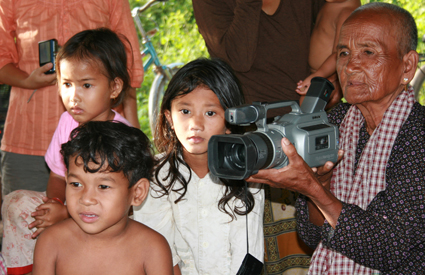
We Want (U) to Know (2011), Ella Pugliese
The screening of Ippo Ippo (2010), by Shotaro Wake from Japan, provoked an intense response from the audience. Ippo Ippo is about resilience and transformation, posing fundamental questions about how to live. Shotaro films inside a cancer support group. Climbing Mt Fuji is part of their therapy. The main character is Marsha, a middle-aged housewife. But the filmmaker also has cancer and is a participant in the support group. He does not film himself, but the way he films Marsha is deeply empathic; it’s as if he is residing within the film on several levels. The audience cheered Shotaro as he rose to answer their questions; a powerful emotion swept through the theatre, embracing the filmmaker’s survival in a spontaneous outburst of affection. Shotaro himself wondered if the audience was perhaps also sensing him to be a representative post-Fukishima survivor.
We Want (U) to Know (2011), by Ella Pugliese, is a participatory documentary created with survivors of the Khmer Rouge period. Produced around the time of the Tribunal, amidst the painful process of remembering, the film reveals its own methods of storytelling and re-enactment, along with the potency of the children filming their elders. These participatory methods become part of a restorative justice process. The film develops as a work of mourning—a catalyst to transformative emotional change.
This festival is expansive in scope and intention—its notion of anthropological film also encompassing classic traditional documentaries, such as John Marshall’s Bitter Melons (1971). It is an auspicious beginning, for a festival that promises to become a significant biennial event for the whole Asian region.
International Anthropological Film Festival, curators Johannes Rühl, Dr. Bùi Quang Thǻng, presented by Vietnam Institute of Culture & Art Studies (VICAS), HCMC University of Culture, Department of Culture, Sport & Tourism (HCMC), Vietnam Film Research & Archive Center; Ho Chi Minh City, Nov 10-14, 2012, www.anthrofilmfestival.com/
Jeni Thornley is a documentary filmmaker and part-time lecturer in Issues in Documentary at UTS, Sydney. She was a guest of the festival with her film Island Home Country (see RT112).
www.jenithornley.com/; http://jenithornleydoco.blogspot.com.au/
RealTime issue #113 Feb-March 2013 pg. 16
© Jeni Thornley; for permission to reproduce apply to realtime@realtimearts.net
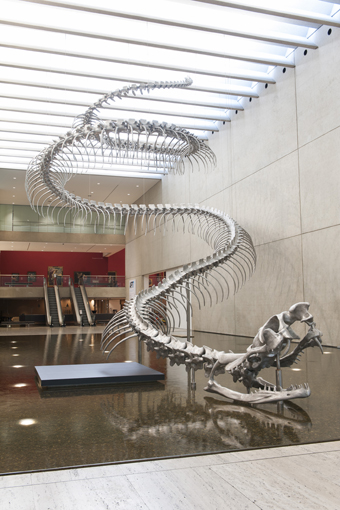
Huang Yong Ping, Ressort 2012, aluminium, stainless steel. Purchased 2012 with funds from Tim Fairfax, AM, through the Queensland Art Gallery Foundation, Queensland Art Gallery Collection
© the artist, photo Mark Sherwood
Huang Yong Ping, Ressort 2012, aluminium, stainless steel. Purchased 2012 with funds from Tim Fairfax, AM, through the Queensland Art Gallery Foundation, Queensland Art Gallery Collection
In the Chinese Year of the Snake, the 7th Asia Pacific Triennial, (showing until April 14), is thrilling gallery goers from around Australia and beyond with the plenitude, vividness and political acuity of its art drawn from the region [p8]. The exhibition aptly features an aluminium and stainless steel skeleton of a huge writhing snake, [Ressort (2012) by Huang Yong Ping] hovering above the Queensland Art Gallery’s Water Mall, perhaps poised to strike. The Chinese Zodiac Black Water Snake, however, is said to be enigmatic, intuitive, introspective, refined and collected. Perhaps a combination of the primordial strength intimated by Ressort and these more subdued virtues might make a perfect combination in an artistic temperament of a kind we’d all like to have in 2013. APT7 tells us that Huang Yong Ping’s snake “metaphorically links sky and water.”
Water makes some notable appearances in RT113: delight in the richness of its character and anxiety over its future is acknowledged creatively in Arts House’s Gauge and in ISEA 2012 in drought-oppressed Albuquerque. Ulay, former partner of Marina Abramovic, is so concerned about this element that, given we are mostly composed of it, he now introduces himself as Water. We also celebrate Tura New Music’s 25 years and the legacy of the recently departed Albie Thoms, whose career fluidly traversed directing in theatre and television, producing ABC TV’s GTK, making documentaries and, above all, creating and encouraging the making of experimental films and videos.
RealTime issue #113 Feb-March 2013 pg. 1
© RealTime ; for permission to reproduce apply to realtime@realtimearts.net
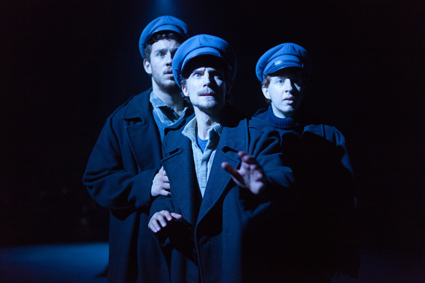
Daniel Macey, Mitchell Riley, Alexander Knight, The Lighthouse, Sydney Chamber Opera
photo Louis Dillon-Savage
Daniel Macey, Mitchell Riley, Alexander Knight, The Lighthouse, Sydney Chamber Opera
A HUGE, LOW, CIRCULAR PLATFORM DOMINATES THE PERFORMING SPACE. A THIN, LADDERED TOWER ON ITS EDGE RISES HIGH ABOVE. BEHIND, A SMALL ORCHESTRA FANS OUT. WITHIN THIS SPHERE THE TALE OF THE DISAPPEARANCE OF THREE LIGHTHOUSE KEEPERS BECOMES AURALLY AND VISUALLY VISCERAL, TESTING MORAL ABSOLUTES AND RAMPING UP FEARS OF THE SUPERNATURAL, ACTUAL OR PROJECTED.
This closed world is at first a court of inquiry where three nervous investigators are interrogated by a mute man atop the tower, ‘voiced’ by a French horn. Then it becomes the lighthouse interior where we witness the keepers’ fragile relationship rapidly splintering as they reveal beliefs, fears, obsessions and crimes. Composer Peter Maxwell Davies has the investigators, deeply disturbed by what they imagine has happened, double as the keepers. This mutability is substantially expanded by director Kip Williams’ and designer Michael Hankin’s production of The Lighthouse for Sydney Chamber Opera.
Enveloped in Nicholas Rayment’s evocative lighting, a 17-strong non-singing ‘chorus’ in long, sleek, black raincoats transmutes from a finely choreographed, swaying court of inquiry into rocks, scampering rats flooding the stage, selkies and worse, as fear morphs into hysteria with the raw brass cry of ‘the beast’ and red eyes looming through fog (a near over the top moment in this considered production). The overall direction and design is thoroughly consonant with Maxwell Davies’ richly dynamic score—brisk, agitated, suffused with moments of eerie beauty and the minglings of many musics—folkloric, sentimentally operatic and mockingly modernist, all of which grant the performers ample psychological and theatrical colour. But not ease—the vocal challenges are great, the singers having to command multiple styles, complex rhythmic and octave shifts while holding the line.
The performers, Daniel Macey, Mitchell Riley and Alexander Knight, make up a rather youthful trio of lighthouse keepers. It’s not uncommon in The Lighthouse to cast a range of ages, but here their collective youth, powerful singing and fine acting adds a certain fragility, heightening the sense of their fear of each other (they sing songs “lest we end up like beasts in a cage, eating each other”) and the unknown beyond their confines (“The only cure is to kill the beast!”).
Maxwell Davies’ music, conducted by Jack Symonds, proved wonderfully memorable, perhaps surprising some doubters in the audience, who came anyway to see this opera rarity. Melodies plain and distended, revealing parodies and rich orchestral textures—adorned with banjo, honky-tonky piano, fiddle, guitar and a wide spectrum of riveting percussion—made for a musically immersive experience enhanced by vigorous theatrical inventiveness.
Sydney Chamber Opera, The Lighthouse, composer Peter Maxwell Davies, conductor Jack Symonds, director Kip Williams, performers Daniel Macey, Mitchell Riley, Alexander Knight, designer Michael Hankin, lighting Nicholas Rayment; Carriageworks, Sydney, Nov 24, 26, 28
See interview with Sydney Chamber Opera directors Louis Garrick & Jack Symonds
RealTime issue #113 Feb-March 2013 pg. 40
© Keith Gallasch; for permission to reproduce apply to realtime@realtimearts.net
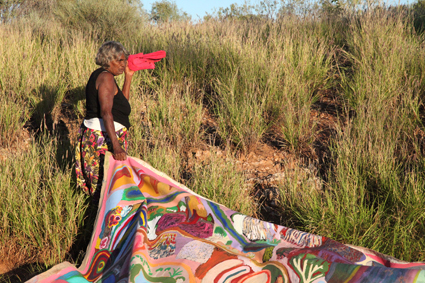
Amy French with her painting Karlamilyi, acrylic on canvas, 2010, at Karlamilyi 2011, We Don’t Need a Map
photo Gabrielle Sullivan
Amy French with her painting Karlamilyi, acrylic on canvas, 2010, at Karlamilyi 2011, We Don’t Need a Map
IN WESTERN EUROPEAN IMAGINATION, THE DESERT IS A PLACE INHOSPITABLE TO ‘CIVILISATION,’ CHARACTERISED BY A BARRENNESS THAT MAY AS WELL BE LUNAR.
The deserts of Western Australia, indeed of much of Australia, have long been tainted with this symbolic brush—our capital cities are coastal and the interior of Western Australia most commonly related to on a non-committal, fly-in fly-out basis. The gulf between this idea of desert and a contradictory one—based on long time, first-hand, lived experience—is what causes We Don’t Need a Map: A Martu Experience of Western Desert to resonate.
Where some might see an expanse of little feature or diversity, the Martu instead know their land as richly detailed and abundant. Like their landscape, the Martu are themselves a varied people, with numerous language groups. Withstanding colonial intervention, the Martu people have called the Western deserts of Western Australia home for countless generations, and are intimately connected with its landscape both pragmatically and culturally. The art made by the Martu is not only expressive of their experience of home, but also actively participates in it. In Martu culture, the process of making objects and images, of singing and walking the land, is a process of continual renewal. Tending the land and telling stories of it are not considered to be separate activities; culture, like fire or rain, keeps country alive.
In presenting a comprehensive expression of this experience, We Don’t Need a Map is an ambitious undertaking in both scope and resolution, requiring intricate and sensitive collaboration on almost every level of production. Arising from an interest by Ross Hamilton from mining giant BHP Billiton—which also sponsored the Canning Stock Route Project of 2006-2011— in “themes of land management,” the partnership between Martumilli Artists, the Kanyirninpa Rangers and Fremantle Arts Centre spent two years in development. Three co-curators—Erin Coates, Gabrielle Sullivan and Kathleen Sorensen—have realised the exhibition by over 30 artists, overseeing burgeoning creative relationships between Martu artists and visiting collaborators from around Australia and the application of new media technology to traditional stories and techniques.
The curatorial responsibility of doing justice to a rich culture with a well defined visual logic while also educating a viewing public perhaps unfamiliar with its intricacies, or informed by a conflicted understanding of desert living, could potentially be overwhelming at such a scale. The necessities of producing a coherent and cohesive exhibition of contemporary art are underpinned here by complexities—troubled relationships between Western and Indigenous ideas and people cannot be avoided nor overstated, and keen awareness of this history and a desire for productive mending simmer visibly in the collaborative works. While necessary, the more educational aspects of the exhibition risk carrying unwanted anthropological baggage and great pains have been taken to ensure that Martu voices speak loudest, so that what is presented is understood as living and vital. This effort often battles with a conflicting urge to avoid explanatory text, resulting in some areas of the exhibition that read more like classroom aids than artworks.
We Don’t Need a Map is most successful when this ‘educational’ agenda is less explicit; these successes are many, and of significant value. The inclusion of aerial photographs of the region, juxtaposed with Martu paintings, makes direct connection between the abstract swatches of painted colour and the real topography of the landscape. The knowledge of geographic form and structure learnt through walking country proves to be incredibly accurate—reverberations of form and of the shimmering, saturated colour in photographs and paintings create engaging shifts in perspective, between representation and abstraction.
The most memorable works allow for an experiential immersion in Martu life, in its colours and textures and sounds. Sound in particular is a welcome accompaniment. Karlamilyi, an enormous painting by Amy French and Lily Long—a five by three metre controlled explosion of colour—is accompanied by an audio track of the sisters singing their country, activating the painting’s internal rhythms and contributing a comparative sense of time to its impressive scale. Karlamilyi combines remembered geography and geology with ancestral stories and figures, a vibrant blend of figuration and abstraction that renders visible the sister’s complex understanding of the landscape and their place within it. A ‘key’ to this memory map also assists navigation without too literally assigning meaning to specific forms, allowing the mind and eye to wander at will.
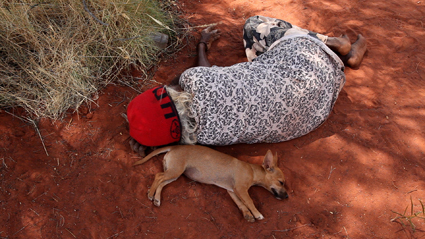
Mabel, Still Walking Country, Lynette Wallworth, still, 2012, We Don’t Need a Map
courtesy and © the artist
Mabel, Still Walking Country, Lynette Wallworth, still, 2012, We Don’t Need a Map
Lynette Wallworth’s Still Walking Country is a similarly immersive experience. The elegant three channel video, each frame projected larger than life across two walls of a darkened screen room, documents Martu women hunting, cooking and walking, a simple soundtrack provided again by their singing. The syrupy pace of the videos, which gradually fade in and out of various stages of the processes, complements the pace of the skilful hands and voices at work within them. Closely framed images of skinning and plucking, the red dirt and fire-lit darkness of the landscape, are at once visceral and hauntingly beautiful, presented with all the gravitas with which they are performed. Wallworth’s reverence for her subjects and her sense of wonder are evident—the lens of the camera reads the activities of the women like the watchful eye of a student soaking up new and surprising knowledge and the careful simplicity and precision of the piece avoids didacticism.
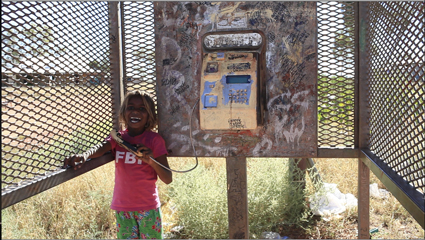
Masey Robinson at the Parnngurr phone booth, The Phone Booth Project, 2012, Lily Hibberd and Curtis Taylor, We Don’t Need a Map
courtesy Fremantle Arts Centre
Masey Robinson at the Parnngurr phone booth, The Phone Booth Project, 2012, Lily Hibberd and Curtis Taylor, We Don’t Need a Map
Martu filmmaker Curtis Taylor, discussing his Phonebooth project with collaborator Lily Hibberd, describes how the Martu way of life has incorporated Western technologies into its traditions, rather than being changed by them. Stone and Hibberd explore this idea indirectly in their documentary video, which retells stories about the use of phonebooths and long distance communication in desert life.
It’s Wallworth’s installation, however, that best illustrates the potential usefulness of new media technologies in contributing to Martu culture. Beyond its documentary purposes, the time-based nature of video and sound complements practices that are already intrinsically involved tied up in temporality, in the idea of renewal, repetition and transmission. Even Martu paintings, as well as being beautiful aesthetic objects, are records of activity, of gestures that make up and remake the landscape anew; the moving image is used most effectively here to illustrate the fluid, living relationship between people and land.
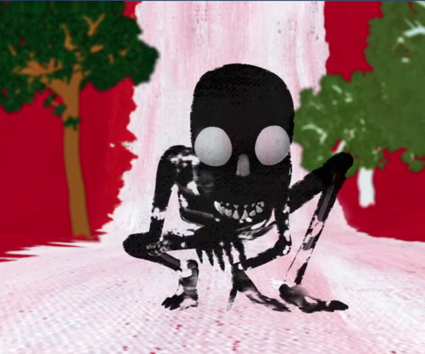
Yukurra Billy Atkins, Cannibal Story, 2012, animation by Sohan Ariel Hayes, We Don’t Need a Map
courtesy Fremantle Arts Centre
Yukurra Billy Atkins, Cannibal Story, 2012, animation by Sohan Ariel Hayes, We Don’t Need a Map
A collaboration between Martu elder Yunkurra Billy Atkins and Sohan Ariel Hayes attempts this literally, translating Atkins’ stories and paintings into an animation. Atkins’ vision is, aesthetically, somewhat different from those that hang close by in the dedicated painting room, his perspective more uncomfortably positioned between representative tropes, between beauty and darkness, and his narratives more explicitly present. Cannibal story depicts the particular darkness of Kumpupirntily (Lake Disappointment), an area of land coloured by bad energy and Martu blood. The repeated motifs from Atkins’ paintings—blood red skies full of spirits and bright hills of blotchy green and yellow—are worked by Hayes into a framework for characters that repeatedly enact the battle between Martu people and a cannibal troupe, portrayed with a stylised cleanliness that jars somewhat with Atkins’ expressive back-drops. Atkins’ paintings become illustrative, a landscape and history in motion.
We Don’t Need a Map is a great achievement both logistically and culturally, providing the necessary service of documenting and promoting cultures whose subtleties and beauty have long been misunderstood. However, it is a shocking experience, in the best possible way, to see your home painted in new and surprising colours, even more so to realise that those colours are true. There is still much to talk about, and to talk through: the practices of the Rangers, the Martu understanding of and domestication of fire, the longevity of the collaborative relationships formed. I wonder if is this is where the real successes of We Don’t Need a Map lie, not necessarily in the large scale presentation of culture alone, but in those two years of behind-the-scenes collaboration, of reciprocal learning and understanding, in the slow and careful development and management of productive relationships that can hopefully extend beyond this exhibition. We Don’t Need a Map seems to ask what lessons can be drawn from these works, from these collaborations. What happens next?
Fremantle Arts Centre: We Don’t Need a Map: Martu Experience of Western Desert, co-curators Erin Coates, FAC Exhibitions Coordinator, Kathleen Sorensen, Martu artist and Cultural Consultant, Gabrielle Sullivan, Martumilli Artists Manager; a partnership between FAC, Kanyirnipa Jujurrpa and Martumilli Artists with support from BHP Billiton Iron Ore; FAC, Fremantle, Nov 17, 2012-Jan 20, 2013
RealTime issue #113 Feb-March 2013 pg. 2-3
© Gemma Weston; for permission to reproduce apply to realtime@realtimearts.net
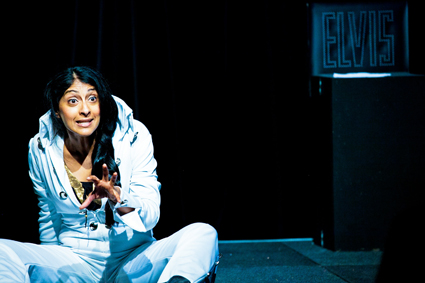
Ansuya Nathan, Long Live the King
photo Cynthia Sciberras
Ansuya Nathan, Long Live the King
SINCE 2010 PEOPLE OF THE PARRAMATTA REGION HAVE CELEBRATED THE VIBRANT CULTURE OF THE ASIAN SUBCONTINENT AND ITS FAR-FLUNG DIASPORA WITH TREMENDOUS CURIOSITY AND ENTHUSIASM. THE FREE CONCERTS IN A TOWN SQUARE GIRDED BY THE MASALA MARKETS (FOOD, FASHION, HANDICRAFTS) DRAW HUGE CROWDS IN THE EVENINGS AND A STEADY FLOW IN THE DAYTIME TAKING IN NON-STOP PERFORMANCES ONSTAGE AND OUT OF THE BLUE—INCLUDING A VERY FUNNY FAKE FAKIR.
Not having been to earlier Parramasalas and eager to experience a culturally focused festival in a country where, Adelaide’s OzAsia excepted, there is little of Asian performing arts on show, not least in our so-called international arts festivals, I booked into a Parramatta hotel for a couple of days of live-in Parramasala.
The Outdoor Stage program, curated by Virginia Hyam, provided some of the more fascinating performances in the festival. It featured traditional dance groups (a superb, young Sri Lankan group displayed traditional Kandyan dancing and fine costumery evoking animals, warriors and gods), individual artists, for example Bukhchuluun Ganburged, an excellent Mongolian throat singer capable of surprising bass runs, and groups, like Layam, building their jazz inflected performance on South Indian tradition. Although not a fan of musical fusion I was entranced by Nafas, a band combining the talents and instruments of musicians from Mongolia (throat singing, horse fiddle), Afghanistan (tabla and harmonium), Guadeloupe (African drums) and Australia (western drumming and keyboards). Nafas’ ”Into silence” was sublimely contemplative and calming, a nice prelude to my first indoor Parramasala concert, after a fine Punjabi butter chicken washed down with sugar cane juice with Tahitian lime and ginger.
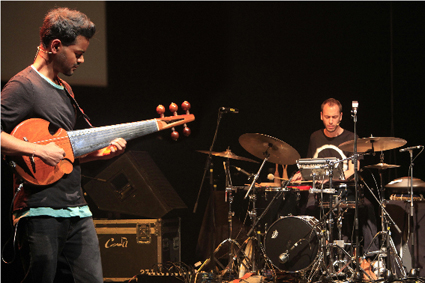
Soumik Datta, Bernhard Schimpelsberger, Circle of Sound
photo David Clare
Soumik Datta, Bernhard Schimpelsberger, Circle of Sound
Sarod virtuoso Soumik Datta (UK), his instrument slung electric guitar-style over his shoulder, was joined by Austrian percussionist Bernhard Schimpelsberger in a powerhouse concert at Riverside Theatre. The musical form was somewhat repetitive, each piece commencing with delicacy, surging into fast picking to an emphatic percussive beat and then overlaid with looping sound, courtesy of guitar pedals, and climaxing with rock band passion. The playing was intricate, although greater variation and a bit more evidence of classical skill would have been welcome; but Datta transforms the sarod into a fascinatingly multi-voiced instrument. Other elements varied the tone of the concert: the voiceover to an opening video projection of mountainous country suggested we were in for some high drama in its account of frostbite, delirium and mortality—a prelude to the first piece, “Quest.” Compositions were interspersed with the musicians joking about their show going out to fans ‘live’ online, and playing for an admiring President Obama. Later they accompanied a melancholy song “The return,” pre-recorded by a female singer to a video of gloomy roads and rain on a windscreen. There were moments of aching beauty in the complex final pieces, “Circles of Sound” and “Circles of Light,” phrases like “a new awakening” and “You will not beat me” suggesting a return to the show’s opening quest motif. Throughout, Schimpelsberger textured and propelled the compositions with inventiveness and some strange instruments.
The theatre program of three performances focused on issues of identity and displacement. The Trouble with Asian Men (created by Kristine Landon-Smith, Sudha Bhuchar and Louise Wallinger), from the UK’s Tamasha Theatre, was a rather under-produced affair utilising a similar methodology to the one Roslyn Oades has so expertly and dynamically exploited and advanced for Urban Theatre Projects (Fast Cars & Tractor Engines, 2005 and Stories of Love & Hate, 2008) and Belvoir (I’m Your Man, 2012).
Wearing headphones, the three performers (two from the UK where the performance originated, one a local) reproduce verbatim the recorded utterances of those interviewed about the trouble with Asian men and “what’s troubling Asian men.” It’s pretty much a litany of horrors with sporadic humour and no sense of overall cohesion: there’s fear of young British and Australian Indian women’s independence and their expectations of wealth; lack of young male ambition; oppressive male behaviour towards wives and girlfriends; a desire to seek refuge in India; and above all men appear trapped by the “invisible umbilical cord” between mother and son (mother’s food is best, mother knows best). Men face unfulfilling marriages, claim they ‘need their freedom,’ and are repelled by their pregnant wives’ bodies.
The UK actors overplayed their parts, amplifying the one-dimensionality of the work, which left me thinking what else might trouble Asian men about living in London or Parramatta, beyond girls, wives, mum and dad. What about class, politics, relationships with British or Australian men and women, in the workplace or socially? Or is The Trouble with Asian Men an account of a hopelessly ghettoised male subculture? The show has enjoyed considerable success in the UK over the last decade, but here it seems stereotypical and infuriatingly unanalytical.
Anusya Nathan’s Long Live the King (director Guy Masterson) was a more complex work. The LA-based Australian writer-performer and screen actor works to a tightly cued light and sound program, switching roles and changing appearance in an account of the time before and after her parents’ (Meena and Francis) arrival in Adelaide from India in 1977—on the same day that Elvis dies. Her mother is obsessed with Elvis Presley whose death the writer has described as the play’s metaphor for the sense of loss that comes with migration—and potential marital breakdown. A string of Elvis songs sets the tone for scenes—The Beatles’ “Something” for Francis’ attraction to Meena and “Are you lonesome tonight” for a growing sense of isolation and putrefaction (such is the intensity of some of the writing) felt by Meena. The vast spaces around suburban Elizabeth, north of Adelaide, the pair’s new home, proves too much for Francis. As well, he is made anxious by Meena’s pregnancy—“Give me back my wife!” The birth of the child is traumatic but proves to be Meena’s salvation. Nathan smiles and weeps at once at the play’s conclusion, embodying mother and daughter in the same way that her earlier Elvis impersonation is, in spirit, both her own and her mother’s. It’s not clear in the play whether or not the marriage of Meena and Francis survives, but apparently it did. The success of Long Live the King in the fringe festivals of Adelaide, Melbourne and Edinburgh is clearly warranted. Asunya Nathan demonstrates physical and vocal versatility and literary ability (if occasionally hyper-poetic), and does a very good Elvis.
Another quick change artist is New Zealand’s Jacob Ranga, a master of the mask. Krishna’s Dairy (director Justin Lewis; Indian Ink Theatre Company) is a solo performance (with a supporting musician) packed with visual gags, songs, dextrous alternation of masks to create various characters and parallel storytelling about relationships between husbands and wives. In New Zealand, Gobi and Zina run a corner store—the ‘dairy’ of the title; in Mogul India, the emperor Shah Jahan builds the Taj Mahal for his late wife, Mumtaz Mahal. Gobi’s ambition is to fight supermarket culture and provide for his wife and son, but in a surprising reversal it’s Gobi who dies, shot by a thief in the shop. Zina, who had always wanted to return to India (“What do you miss?, Gobi asks, “The dirt, the flies?” “Family,” she replies) not only keeps the store running, but business thrives. She continues to feel the presence of the man she only met when they married, asking him, “How can you really say you love someone…?” Zina’s tribute to Gobi is the success of the store, her modest Taj Mahal. It’s interesting that in the Taj Mahal tale Rajan uses the frequently told if historically unsupported story of Shah Jahan’s blinding and mutilation of his architects and craftsmen, an indication of the darker side of the testament of one partner’s love for another. Jacob Rajan’s performance is impressive and frequently funny, but the play’s 15 years are showing—it feels quaint, over-wrought and thematically light; some of the youngish audience I saw it with thought it was “like a play for kids.” Theatrically it had much to offer, but like The Trouble with Asian Men, there was a claustrophobic sense of a closed circuit, of people not engaging with much beyond their own lives—doubtless a condition suffered by many first generation migrants.
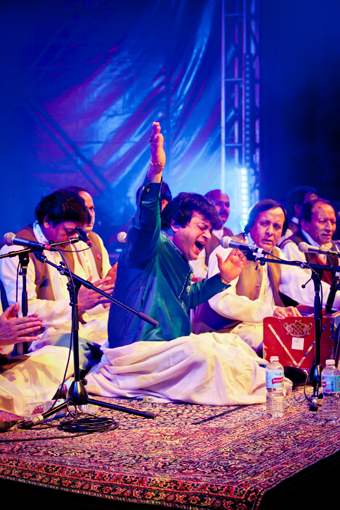
Asif Ali Khan & Group
photo Cynthia Sciberras
Asif Ali Khan & Group
Although I couldn’t attend the opening night Bollywood Block Party and a tight schedule meant that I had to miss out on Susheela Raman & Band and Pandit Hari Prasas Chaurasia, I caught a large part of the wonderful outdoor concert by Pakistan’s leading qwaali exponents, Asif Ali Khan & Group. A huge, rapt audience swayed to the rapidly paced, insistent percussion and the powerful collective singing of the musicians ranging into exquisite high tenor and delivering dynamic call and response. The audience was astonishingly diverse for a concert of such cultural specificity, drawing on Western Sydney’s multicultural breadth and depth. The festival’s decision to make this concert free was a wise and a generous one. Asif Ali Khan & Group were followed by Melbourne’s eccentric The Bombay Royale, an 11-piece band convincingly fusing disco, Bollywood, surf, rock and Ennio Morricone with excellent singers Parvyn Kaur Singh and Shourov Bhattacharya and fun costuming. They had the crowd dancing. I ate too well, took in some of the film program, relished unexpected performances from proud South Asian Sydneysiders and was captivated body and soul by music at once ancient and modern. It was odd but enlightening to feel like a cultural tourist in one’s own city. Long live Parramasala!
Parramasala, Sydney, Nov 8-11, 2012, www.parramasala.com
RealTime issue #113 Feb-March 2013 pg. 4
© Keith Gallasch; for permission to reproduce apply to realtime@realtimearts.net
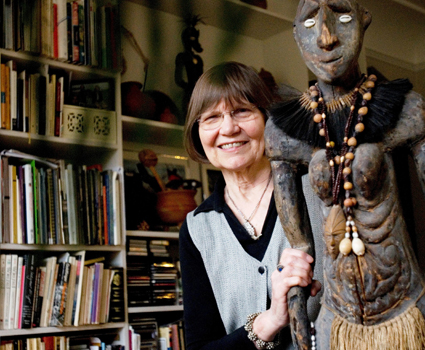
Ellen Dissanayake with Nokwe
photo Ingrid Barrentine
Ellen Dissanayake with Nokwe
ELLEN DISSANAYAKE IS AN AMERICAN WRITER AND ANTHROPOLOGICAL SCHOLAR WHO CLAIMS THAT ART MAKING IS NATURAL RATHER THAN SIMPLY CULTURAL, IN THE SAME WAY THAT LANGUAGE SKILLS ARE NOW REGARDED AS INNATE.
Her notion of art is broad, including games and rituals and is drawn from 15 years of field experience in Sri Lanka, Nigeria and Papua New Guinea. In particular she argues that art makes things special, with evolutionary and social purpose, and has done so for long before our two-century old specialisation and abstract theorising of art.
Christine Morrow, Director of the Australian Experimental Arts Foundation (AEAF) in Adelaide recently interviewed Dissanayake prior to the writer’s visit to Australia to speak about “The Deep Structure of the Arts.”
Can you talk a little bit about how the arts were experienced in hunter-gatherer societies and give an overview of the differences that are thrown up when we compare them to the arts today.
The behavior of our hunter-gatherer ancestors adapted them to their way of life. These were small groups of people who had to work together in confidence and unity. They didn’t just have some people performing art and other people watching. Everybody participated. In modern and post-modern societies in the West, specialist artists—it is a very long story—worked for princes and for the Church and then there were the bourgeois audiences and collectors after the French Revolution. By that stage, art came to be seen as the province of wealthy people or cultivated people or people with the time and the leisure and the means to enjoy this thing, called art, that was very much apart from life.
If we used the high-elite or fine arts view that was predominant in universities ‘til around the 60s, then it’s easy to say that pre-modern people didn’t even have art. After that, you have the cultural changes, the protest movements and the real politicisation of art. It was pure accident that I started to look at art in the 50s both biologically and evolutionarily. I mean, I never, ever dreamt that I would be on the same quest as people who weren’t biologists—people looking at colonialism, and the arts of women, and trying to think of art more broadly than elite connoisseurs.
I’m not going to ask you, “What is art?” because we will get caught in a semantic tangle that may never unravel. But when you identify and explore this concept of ‘art’ and locate it within prehistoric, hunter-gatherer and other pre-modern societies, are you talking about the same entity as I am, coming from a contemporary art institution whose understanding of the concept is mostly defined in modern and post-modern terms? When you and I use the word ‘art’, are we talking about the same beast?
That’s probably one of the most important questions. I think it’s good for people of today to learn that under the skin we have a Pleistocene psychology. So that if we were born to that way of life, we would be satisfied with it. But, nobody wants to go back to live that way. I certainly don’t want to!
Me neither. [Laughs] I’m personally a huge advocate of modern dentistry…
Anaesthesia, antibiotics and even just a warm bed, right? But, you know, in our arts, I would say we are all still concerned with the same things. What I have learned from the arts of the past is that an evolutionary view tells you that people don’t make art about unimportant things. When people write poetry, they’re writing on themes—love poems, poems about motherhood and poems about nature. They’re all somehow about the human condition. And I think if you dig far enough even into the most outrageous art today, many of the works are political, they have to do with questions of power, and examining or subverting that power. They also have to do with the person’s own status. Where you stand in relation to others has been evolutionarily important. Hunter-gatherer societies are more traditional and everybody has their place, but individuals still want to become that role of mother or warrior or whatever.
I want to ask you if you have any particular reflections on two different things. One is primitivism in the arts—the way that different art movements and individuals have sought to appropriate the ‘look’ of elements from different cultures. The second one is that recent theorists have identified what they’ve chosen to call an ‘ethnographic turn’ in art. In 1995 Hal Foster published an essay called The Artist as Ethnographer. He was looking at the way that theorising cultural difference has become so important in the practice and interpretation of contemporary art. Like anthropologists, artists are exploring how we represent cultural difference.
Now, we know so much about the rest of the world and people have travelled and we are now living in multicultural societies, it’s easier to see our differences rather than our similarities. But you know, a bio-behavioural or an evolutionary view helps us see our similarities more.
You mentioned behavior and that’s your main focus isn’t it? The word ‘art’ operates as a noun but you’re interested in it more as a behaviour, a verb.
There’s no verb for art. We have to say ‘make art’ but that’s also kind of ambivalent because even then art is always a thing or a product. That’s why I’ve come up with the expression ‘artify’ or ‘make special’—to emphasise it as a behaviour. I tried to figure out what was the common denominator among the arts of all people, of all times and places, who were artists, who were making crafts, who were professionals, or ‘Sunday painters’. I used the expression ‘making special’. Some of the biologists or some cultural critics would say that this is too broad. Now, I don’t define ‘making special’ as art because ‘making special’ is broader than just art. In play and in ritual, people also make their experience different from the everyday. Even children, when they play, are pretending. They exaggerate their voices and the way they move. Even puppies know that they’re not really fighting, right? So there are fuzzy edges between these categories of art, play and ritual.
Fossils and artefacts are concrete evidence of the past. But behaviour is to some extent ephemeral—except of course insofar as it can be shown to be either instinctive or innate. What evidence exists for the ways we should understand art as a verb and not a noun, as a behaviour and not a product?
Well I think you have to extrapolate from small-scale societies that we see today. My latest work has been to look at mark-making—what are called petroglyphs or carvings into rock. That’s the trace of the behaviour. We don’t know about the dancing and singing but we just have to assume by, say, looking at children. Even very small children are primed to do these things. So you would think, then, that if babies and toddlers just innately sing and move along with music without anyone teaching them to do these things, then that predisposition is there.
In your writing, you challenge the idea that art should be understood as a symbolic practice. If art were a symbolic practice, two- or three-dimensional elements would have referents. But if art isn’t defined as symbolic, then how else might we understand it instead?
I don’t think of art as a language.
We have a fundamental predisposition—I don’t like to say that art is an instinct—to make experience special. Doing that helped our ancestors to survive. The things that were important to them were the biological things of life: finding food, becoming well, having healthy children and being prosperous and getting along. So they artified those things with rituals that are full of art. When I say ritual, I’m really just referring to a bunch of different arts all assembled together. There is just a human proclivity to do much more than is merely necessary.
I could be argued with about that. A strict evolutionist would say that you don’t waste time and resources on something unless it’s going to pay you back in a big way in terms of reproduction and survival.
I have a problem with the archaeological establishment that looks back in time at early petroglyphs—from long before those beautiful cave paintings at Lascaux and Chauvet. The earliest petroglyphs are non-representational. They’re geometric. They have found carvings of parallel lines, perpendicular lines, spirals and diagonal lines that look as though they’re planned and deliberate. And archaeologists want to call this art. But in order to call it art, they feel that they need to say that it’s obviously symbolic.
But you know, artification is a larger human category than symbol. I mean, you can artify a symbol. It’s definitely not the case that once you learned to symbolise, you started making art. You were artifying all along.
Artification existed first but when language came along, when it was about things that were really important, it was artified. So when people give orations, they talk in a different voice, they use a bigger vocabulary, a more flowery vocabulary. They’re ‘making it special’. The impulse to artify comes first and I would speculate that it first appears in the form of body decoration. The human body, instead of having all of this hair growing like an animal does, its braiding it, it’s putting paint on it. It’s marking your body.
I think it is fair to say that you are the principal author of a new discipline. Before you commenced your research and scholarship, there was no systematic study of the evolutionary origins of art was there?
While I would agree with that, it’s definitely not for me to say! I’ve been working in this field for fifty or sixty years but it’s just been in the last ten years that evolutionary biology has really looked at the arts seriously.
There are a couple of other researchers I know, who are from my generation. They are both outside the academy. One of them, Nancy Aiken, wrote a book called The Biological Origins of Art. She shows how in the perception of animals and also in human perception that, for instance, we find zigzag lines to be threatening and rounded forms to be pleasing.
And then Kathryn Coe is an anthropologist who lived with Chachi Indians in Ecuador. She’s written a book called The Ancestress Hypothesis: Visual Art as Adaptation about the women teaching their daughters to weave and passing down their cultural history through this means. So she sees art as being a way of passing information down the line.
I had no idea when I began this work that I would be relevant to anything. What I wanted was to show biologists and ethologists that, ‘Hey, you should look at art too!’ And I haven’t even really ever succeeded in that. My best audiences have been in Art Education or Music Education. They are always on the periphery of Art and Music departments. They’re not the soloists or the medallists or the star painters or sculptors. They’re teaching children. But they know that what they’re doing is art. They’re making experience special. And they know that the children or the patients—or whoever it is that they work with—have art in them to be developed.
The same is true with crafts. Because they are also on the periphery of the Art departments. Oh, you know: “That’s just craft”. But they are working with their hands, and doing things that people have done since the Stone Age, from the Pleistocene. (Laughs) Well, not all of them, of course. Now some are doing things with computers…
There’s a very very import aspect that I haven’t told you yet. It’s about the mother-infant interaction.
But, I’ve read your book, Art and Intimacy.
Okay, but I have carried that so much further now and I have extracted five proto-aesthetic operations that compose artification. The first is formalisation. Which would be like a composing or patterning or simplifying. This is what all artists do. They simplify. They don’t have the whole of a reality there. They’re performing these operations on reality to make it more than ordinary.
Then they use repetition. Whether its repetition of footsteps as in dance or beats as in music or repeating a motif that is part of an artwork, either in space or time.
The third one is exaggeration and that’s a really important one. Things are larger or smaller and they catch your attention. Imagination has made the subject more than ordinary.
Then elaboration, and then manipulation of expectation. As the perceiver experiences this artwork they have expectations about it. Especially in time: in music and in dance, while it unfolds, your expectations are being manipulated. But even within a more static style of art, your expectations are surprised.
Now these five things are what mothers use with their babies to attract attention, to sustain interest to keep the attention and to arouse and mould emotion. They manipulate the baby’s expectation and they formalize and so on.’ And the interesting thing is that that’s what the baby wants the mother to do. It is born wanting that kind of behavior and soliciting it from the adult.
In general, I’ve found that men are really not interested in a theory of mothers and babies. They want to be told that the evolutionary origin of art lies in men using it to show off so that they can seduce females and impregnate them.
Most recently, neuroscientists talk about perceptual primitives. They say that the visual system has ‘primitives’: it responds to an edge or a contour, a dot, a straight line or a colour. Those are called the visual primitives. They’re the building blocks of everything else.
So I am saying that these five things I’ve identified are proto-aesthetic primitives—that they’re there in our brains and we respond to them in any modality, whether it’s visual art or music or dance.
This is new. I’ve been working towards this a long time. This observation really grounds it in biology and if you say that artists of the present day are also using those same operations, then it does make a continuity form the Pleistocene, or actually from the bower birds or song birds to the present.
Everything I’ve read in Art and Intimacy accords with the experience of caring for an infant. It’s so obvious that I feel foolish that I never observed it or particularly reflected on it until I read your research.
Charles Darwin who had 10 children could not reflect on it. He didn’t even mention it. He said that he thought the feeling of ‘sympathy’ came from the mother-infant relationship. But obviously he never went into the nursery…
He was always in his study!
His children were with their mother and their nannies and cousins. But you would think that he would notice how different the voices are and the funny faces that people make for babies. Somehow that escaped him entirely.
I find it quite lovely that your research in that area is based on art and human capacity being founded in collaboration, collectivity and mutuality. I’m thinking about Western liberal philosophy and somebody like Thomas Hobbes writing in Leviathan…
That human life is nasty, brutish and short….and… competitive!
Yes and beyond that, there’s his idea that only through social co-operation can we fulfill our human potential. Can I ask you to speculate on the implications of this idea that competition and selfishness has been overstated in theories of human evolution at the expense of cooperation and mutuality?
Evolutionary philosophy has until quite recently taken that line—that if we cooperate at all it is in order to compete with other groups. But there are a few theorists who are writing more about collaboration. So it’s coming around. Neuroscientists I have talked to recently confirm that this ‘moving together in time’ and doing things like dancing together in a group, or being a mother and having this mutuality with your baby, all these things make your brain secrete oxytocin.
That’s the body’s ‘bonding’ chemical right?
Yes, you release it when you breastfeed, and during sex, but also when you participate in the arts. This hormone increases trust and confidence. So the brains of those hunter-gatherers who were dancing around the fire and singing were being flooded with oxytocin. It made them trust each other and made them feel confident. Now, we have the neurobiology that shows that.
I was at a university in Canada a few weeks ago talked to people in the Psychology of Music lab and an experiment has been done with a group of children. Some of them are walking around and singing. And then when they finish doing that, a teacher drops some papers on the floor. And the ones who’ve being singing go and pick it up.
Ahhh…altruism!
Altruism and mutuality and having sympathy for a person’s needs.
And in another experiment, also done in Canada: children were watching a stuffed animal playing a toy drum either on the beat or out of sync with the music. And the ones who could tell the difference—they were only fourteen month old; they could walk but couldn’t even really talk very much—they would help, they would go and fetch a pencil that the experimenter had dropped. She’s waving her hand across the table trying to reach it. Kids who are able to attune to a beat will be more helpful than the ones who can’t.
The next thing is that oxytocin also suppresses cortisol, which is the stress hormone. This is why people feel good when they’ve sung together or danced together. It’s the participation that is the important thing. So those are two very, very adaptive things that the arts, music and dance in particular, do for people. That explains why children are predisposed to do them and why we do them. Now that idea is not ‘out’ as much as it should be.
Being adaptive in the sense of creating trust and confidence so that people work together in unity and cooperate is getting rid of the stress hormones. This tells us that today the participation in the arts is the important thing. It’s not just going to a gallery and looking at stuff that is already there or even just sitting in an audience but actually doing it.
And especially in schools. If you want your kids—or your patient if you’re an art therapist—to develop things like trust and confidence, this is how it works. They’re getting rid of stress—in addition to all the stuff like the content that’s bothering them is coming out.
My generation of artists and art professionals is convinced that everything in life is relative and meaning is illusory. Can the search for, and understanding of, an evolutionary origin for art provide us with a fixed referent or set of values that may act as an anchor against uncertainty?
If you have a scientific revelation, as I did, that we are on this Earth and we are adapted to live here as hunter-gatherers then that is really bedrock. That is not relative. Also, it’s not relative that our parents are going to die or that we’re going to get sick or that our children are going to give us trouble…
We all face the same human problems. There’s pain, there’s loss, there’s illness—the Buddhist things. So the arts have from time immemorial been a way to investigate those subjects and come to terms with them as much as one can. To express one’s reaction to them. And so you learn from the arts of the past and your art is about that too. You can’t avoid it.
Anything that I hear people say about life, I test it against, “Well, would hunter-gatherers feel that way? Would they do that? Do they need to have, say, couples therapy? What did they do instead? They had their problems, right, but how did they address them?
How does an understanding of the evolutionary origins of art affect the way that we practice and experience it today?
Well you know Barnett Newman said that aesthetics is to art as ornithology is to birds!
I used to think that as soon as people learned that the arts had evolved they would just be so thrilled with that idea that they would just take it to their bosom. It would be like becoming a Copernican after you had been a ‘flat-Earther’ all your life. Because, that is what happened to me.
I think if you have a love or an aptitude and an interest in one or another art—and if you marvel at the natural world and the fact that we are biological creatures who emerged from that world—and if you find grandeur or transcendence in that knowledge, then that would enrich your experience that we are art-making creatures.
Ellen Dissanayake’s visit to Australia is hosted by Australian Experimental Art Foundation and the International Visitors Program of the Visual Arts Board of the Australia Council for the Arts, and supported by the three partner presenting organisations: Canberra Contemporary Art Space, Sydney College of the Arts, and the Museum of Old and New Art, Hobart.
Ellen Dissanayake’s visit to Australia is hosted by Australian Experimental Art Foundation and the International Visitors Program of the Visual Arts Board of the Australia Council for the Arts, and supported by the three partner presenting organisations. AEAF, Adelaide, March 19; Canberra Contemporary Art Space, March 20; Sydney College of the Arts, March 22; Museum of Old and New Art, Hobart, March 26
RealTime issue #113 Feb-March 2013 pg. web
© Christine Morrow; for permission to reproduce apply to realtime@realtimearts.net
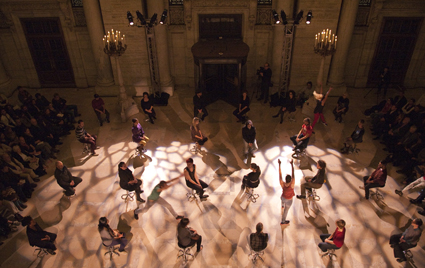
Lee Serle, P.O.V
photo Bart Michaels for Rolex
Lee Serle, P.O.V
FOR DANCE MASSIVE 2013, ARTS HOUSE, MALTHOUSE THEATRE AND DANCEHOUSE HAVE SELECTED 19 WORKS TO BE PERFORMED OVER TWO WEEKS IN MARCH IN THE ONLY FESTIVAL EXCLUSIVELY DEDICATED TO AUSTRALIAN DANCE.
The program, though kinaesthetically and thematically diverse, nevertheless reflects a number of common interests especially around notions of society, culture and the body. What kind of entity is the individual self? What is its relation to the social whole? How do selves coalesce?
The notion of repetition is another common Dance Massive theme, a mechanism which promises to be explored physically, linguistically, temporally and perceptually. Taken together, these works represent an intense manifestation, a critical mass, of dance culture in an Australian setting.
Why program so many dance works in such a short space of time? Dance Massive proposes an intensity, a shared focus between a roving, active population of spectators and performers not often achieved in Australia, at least, not in dance. According to Angela Conquet (Artistic Director, Dancehouse) a festival such as this can give an accurate, layered picture of the Australian dance landscape. This is not to say that everyone is represented here. Undoubtedly, some companies and artists are in between works. The very selection process, with finite resources and the exercise of choice, also rules out the participation of some. Landscapes are never all-inclusive. They have their own physiognomy, their own borders, topography and temporal flavour. So there is also a contingency to this festival. It is the expression of a critical mass, not an encyclopaedia. It is also an expression of place, of what can be generated in such a setting.
Dance Massive has a twin focus. On the one hand, it’s an opportunity for an audience to serially immerse itself in a multiplicity of works. On the other, it will enable a delegation of 20-odd international visitors to see full-length Australian works in their own cultural milieu. This differs from the narrower arts market concept which showcases and commodifies abridged pieces back-to-back for an international clientele. The exposure to a significant international audience means that Dance Massive offers an opportunity to show developed works which could tour both nationally and internationally. For this reason, Conquet says that this is not a forum for works-in-progress. According to Angharad Wynne-Jones (Creative Producer, Arts House), Dance Massive represents artists at quite different stages of their careers. Like the European platform, Dance Massive has the support of state cultural agencies—the Australia Council and Arts Victoria—but its artistic program is the child of the three venues, their artistic directors and selection committees. Angela Conquet is very appreciative of the dance literacy and involvement of Phillip Keir (Keir Foundation), one of the selectors and a key supporter of the Dancehouse program.
inside the program
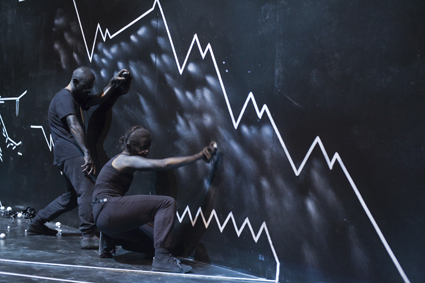
Antony Hamilton, Melanie Lane, Black Project 1
photo Ponch Hawkes
Antony Hamilton, Melanie Lane, Black Project 1
A number of the programmed works embody social and political concerns. Ashley Dyer’s Life Support, for example, follows Something Fell on my Head, both of which give their audience the opportunity to directly experience their subject matter, whether through feelings of anxiety, finitude or vulnerability. Antony Hamilton (Black Project 1 & 2, see RT111 and RT108) and Tim Darbyshire (More or Less Concrete, see RT109), in their own ways, also mediate contemporary political and social issues. Atlanta Eke’s meditation on female mutability, Monster Body (RT110), is posed on a feminist present, while Jo Lloyd’s Future Perfect muses on constellations of identity in the cosmos of social life. Stephanie Lake’s Dual reflects the individual’s ability to cleave to the other thereby producing a new, synthetic entity. Whereas Lloyd poses the group in relation to the individual, Lake is interested in the notion of partnership, as embodied in duet form. In Black Project 1& 2, Antony Hamilton explores another kind of interplay within and without the human, between life and non-life, an unstable cosmos.
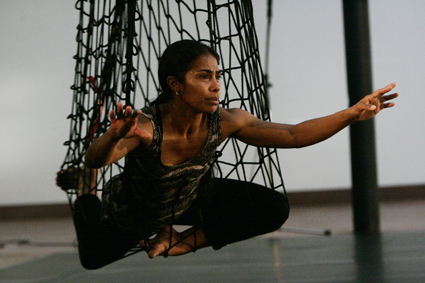
Dalisa Pigram, Gudirr Gudirr, Marrugeku
photo Rod Hartvigsen
Dalisa Pigram, Gudirr Gudirr, Marrugeku
The social and cultural sphere has several modes of incarnation. Dalisa Pigram’s solo work, Gudirr Gudirr, simultaneously spans the collective concerns of Northwestern Aboriginal people through the singularity and cultural breadth of her own body. Soo Yeun You’s Gu:t collaboratively enters aboriginal spirituality through the lens of her own shamanistic background, felt at the level of the kinaesthetic everyday. Not that every body isn’t in some sense a product of culture, time and motion.
While Russell Dumas’ fine work is indebted to the postmodern choreographic legacy of Twyla Tharp and Trisha Brown, his dance for the time being—Southern Exposure has a local inflexion. As a manifestation of what is possible in the space and time of Australian dancing, Dumas’ work is formulated over the abyss of the present. Dumas “reimagines the unstable body” in relation to the (im)possibility of a future dance practice. Nothing is fixed. Likewise, Ben Speth’s WeTubeLIVE (RT112) feeds on an unstable, undetermined network of possibility. Its mode of community is enactive, a mass playing out of virtual choreographies ripped from the internet and staged for live capture in the dappled kaleidoscope of the National Gallery’s Great Hall. While Speth, Dumas and Pigram are each in their own way oriented towards the future, Tracie Mitchell’s dance film retrospective shows film’s enduring ability to reach into the present.
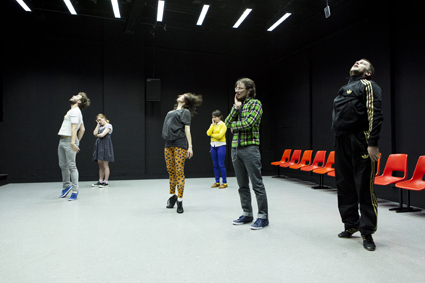
Conversation Piece, Lucy Guerin Inc
photo Brett Boardman
Conversation Piece, Lucy Guerin Inc
If Larissa McGowan (Skeleton; see interview, p26) is concerned with the bare bones of the anatomical trace, The Recording continues Sandy Parker’s prior interest in the dynamic physiology of a work. Whereas the earlier Document (interview RT103; review RT105) was oriented towards the marks on the page or screen, The Recording aims to open up the process whereby live dancing becomes a series of cinematic images. Difference provokes transformation. This is also a factor in Lucy Guerin’s work, Conversation Piece (interview RT110; review RT111) which plays on the changes set in motion through repetition. Paradoxically, repetition does not engender serial sameness but is the means by which difference is produced. Words and movement played again institute an event, the becoming different of something recognisably the same. Matthew Day also plays with difference through repetition in Intermission (interview RT109; review RT110), a durational, rhythmic work that aims to create its own perceptual milieu. Intermission is the third in Day’s series of pieces, each concerned with the mutating force of repetition. Tim Darbyshire’s More or Less Concrete (RT109) is also interested in the effects of the cyclical as is Natalie Abbott in her work, Physical Fractals (see RT109 online). The singular is reflected in our conception of the unique individual who is simultaneously a participant of the social whole. In 247 Days, Chunky Move artistic director Anouk Van Dijk continues her interest in the social and the political with a work focused on the individual. While her An Act of Now (interview RT111; review RT112) was strongly site specific in its deployment of the Sidney Myer Music Bowl, 247 Days takes as its spatial premise Malthouse’s cavernous, black box Merlyn Theatre.
Personally, I find it difficult to tell what a piece will be like from reading about it. Such is the elusive potential of live performance that it cannot be fully represented in words. Words lean towards the event, they strive towards it, but they cannot fully embrace what is yet to come. Dance Massive offers a sustained opportunity for a series of live relations between the work and the audience, a portal of potential. That said, Conquet regards the durational aspect of dance as something that needs time in between viewings; to allow the sensorial dust to settle, or better still, to reverberate. Taking time on the part of the spectator allows for the “preservation of sensations” the better to amplify their impact. However you do it, you have 12 days to pace yourself or, as Wynne-Jones suggests, to “go for the ride.”
Dance Massive, Australian Contemporary Dance, Dancehouse, Malthouse, Arts House, March 12-14; National Dance Forum, Footscray Community Arts Centre, Melbourne, March 15-17
RealTime issue #113 Feb-March 2013 pg. 6
© Philipa Rothfield; for permission to reproduce apply to realtime@realtimearts.net
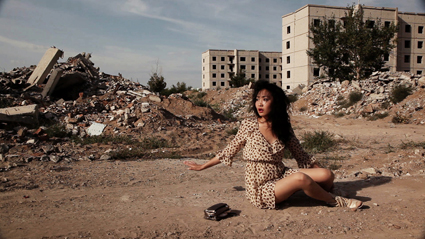
Almagul Menlibayeva, Kurchatov 22 (still) 2012
courtesy the artist and Priska C Juschka Fine Art, New York
Almagul Menlibayeva, Kurchatov 22 (still) 2012
IN A QUIET CORNER OF THE IMMENSE DISPLAY THAT IS THE SEVENTH ASIA-PACIFIC TRIENNIAL (APT7) PLAYS THE VIDEO COMPONENT OF PRATCHAYA PHINTHONG’S MULTI-MEDIA PROJECT, GIVE MORE THAN YOU TAKE (2010–ONGOING). JOLLY AND TECHNICALLY ROUGH, THE VIDEO RECORDS THAI SEASONAL WORKERS BERRY PICKING IN SWEDEN—AN UNEXPECTED MIGRANT TRADE THAT PLAYS ENTERTAININGLY WITH OUR PRECONCEPTIONS OF LANDSCAPE.
We see Thai hats in the Swedish forest and hear Thai voices larking about in a car driving through Scandinavian fog. Handheld and lo-fi, the films chronicle the experiences of Thai migrants who display all the casualness of Australians backpacking in Bali.
Although a relatively minor component of APT7, Phinthong’s video points to some of the central themes of the overall show, visualising just one of the many migrations to result from today’s shifting global economies and the new perspectives forged in the process. While the migrant workers are not tourists, their films are fresh with the feel of adventure. They re-tell Sweden from the perspective of Thai farmers, turning our expectations of place inside out.
Every three years Brisbane plays host to this major contemporary art exhibition—the only large-scale show in the world to focus on the art of Australia, Asia and the Pacific—and for these five colourful months the city feels more like a gateway to Asia than its clichéd image as the capital of Australia’s ‘deep north’. But that is but one purpose of the APT: to remind us that geography is subjective.
The most ambitious APT yet, this exhibition re-imagines the region once more, with the new and recent work of 75 artists and artist groups from a region that stretches from the far southeast of New Zealand to the edges of Europe in Istanbul. There are two special exhibition foci, the now-regular Kids’ APT, 27 countries represented, and a special look at the archive to make sense of the last two decades of cultural and political change (APT7 marks the 20th anniversary of the show).
My brief has been to focus on screen works (a necessary filter considering the exhibition’s size), however, part of the pleasure of the APT is being overwhelmed by its span and variety. The APT presents a world of uneven landscapes and ever-morphing cultural identities, and much of its dynamism comes from dialogues between different media. This is almost half the world on display, and in all forms of cultural play.
In his short video, Lunda Bazaar (2010), Basir Mahmood evokes the menacing mechanics of global trade, slowing footage of a second-hand clothing market in Lahore, Pakistan, to an ominous pace. Local men try on jackets from Europe so slowly, and to such a growling soundtrack, that we are compelled to question what chain of relations has brought the goods to this place. What darkness lies behind the exchange? Through repeating cycles of men slipping their arms into Western suits we sense the legacies of European colonisation in the region—not only the colonisation of the everyday market, but also of its subjects’ dreams.
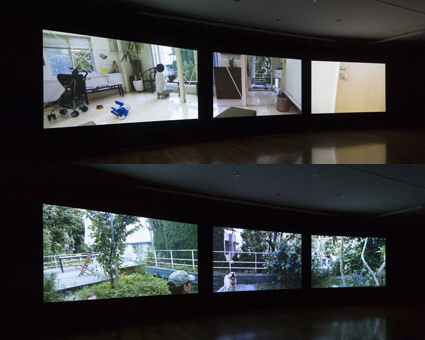
Yuan Goang-Ming, Disappearing Landscape – Passing II (stills) 2011, collection: Queensland Art Gallery
courtesy the artists and TKG+, Taipei and Beijing
Yuan Goang-Ming, Disappearing Landscape – Passing II (stills) 2011, collection: Queensland Art Gallery
Many of the screen works in APT7 suggest the telescoping of space and histories, the sliding of time and heritage that makes up our experience of contemporary life. Yuan Goang-Ming’s Disappearing Landscape—Passing II (2011) is a journey across memory and moment, breathtaking for its technical and poetic artistry. A three-channel projection (presented in the deliciously enveloping shadows of a large, dedicated and sofa-furnished space), this lushly cinematic work takes us floating through the artist’s Taipei apartment, the camphor tree outside his window and a reconstructed scene of his late father’s study. Sucking backwards and shooting forwards, the film warps both time and space to poignant and frightening effect.
heading west
As the world has changed, so has the APT, and this year’s exhibition includes a special focus on the art of West Asia—the latest new economy to become fashionable in the art market. Variously known as the art of Central Asia, West Asia and the Middle East (even within the APT literature, curiously), it is perhaps unsurprising that an underlying concern in this section is of the ways the region has been labelled and exploited by outsiders.
Oraib Toukan’s The Equity is in the Circle (2007–09), for example, is a mockumentary-like marketing campaign in which the Middle East is carved up, branded and sold off. “Own This View, And Everything In It…” announces a billboard; experts discuss the philanthropic contributions investors might make to their purchased communities, retelling post-colonial nationalism in the language of corporate governance. The videos could be PR for an oil company, strategising its investment in the region.
Another major work, Almagul Menlibayeva’s video installation Kurchatov 22 (2012), revisits a town in northeast Kazakhstan that was the main site for Soviet nuclear testing during the Cold War. Combining documentary and performance, the film pieces together a landscape scarred by brutal experiments and a community still shaped by their fallout. One of the scientists involved in the tests recounts how he once signed a document swearing his life-long confidentiality: “But the country I signed my name to,” he explains, “no longer exists.”
what country? what identity?
This issue of how a region or culture is defined resonates throughout the overall show. Historical battles are re-enacted with ironic changes. Peripheries of former political empires are put centrestage. The image and mention of the passport keeps popping up, referencing the abstraction of one’s political identity.
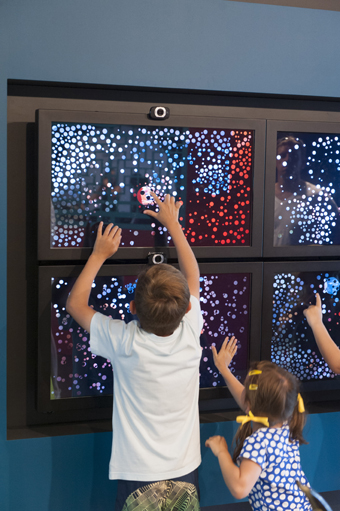
Daniel Boyd, History is made at night 2012, Kids APT7
photo QAGOMA Photography
Daniel Boyd, History is made at night 2012, Kids APT7
In his collection of paintings and four-channel video installation, Darker Shade of Dark (2012), Australian Indigenous artist Daniel Boyd questions the extent to which he can ever really know his own culture, or have access to his family heritage, amidst the obscuring tides of history. By applying a veil of transparent dots, almost like pinhole apertures, Boyd abstracts a range of existing artworks and creates a new view via distortion.
While the paintings suggest something of their subject matter—a view of Pentecost Island in Vanuatu where Boyd’s great-great-grandfather was from; a Mapplethorpe portrait of Grace Jones covered in body paint by Keith Haring—the installation eludes decoding. Dancing across the walls, this floor-to-ceiling surround screen projection is a cosmic gallery of multi-coloured spots of light, bursting and arcing like fireworks.
The effect is suave and slyly sardonic, a critique not only of Boyd’s own perception, perhaps, but of the razzle-dazzle of Aboriginal dot paintings in the art market. How far are we ever able to see beneath the surface display? And how much do we enjoy the illusion?
In addition to video works, APT7 includes two film programs: Chinese animation since the 1930s and feature films from the Asia-Pacific region over the last 20 years. The first is diverse in itself, covering Mainland Chinese, Taiwanese and Hong Kong animation, with a special showcase of 1930s classics.
The second, however, includes works so varied as to provoke questions around its rationale as a program. Titled Change: Paths Through 20 Years of Film, the program includes everything from Lee Tamahori’s Once Were Warriors to Wong Kar-Wai’s Happy Together, from Iranian drama to Chinese documentary. A mini-APT of cinema, the program reflects the diversity and immensity of the region, with change as the one pulsing constant.
mapping the unmappable
You could call the exhibition unruly, but then this is precisely what the APT celebrates: our attempt to map the un-mappable, and the disorderly effects of history on our conceptions of region and culture. Who defines the Asia-Pacific? What is the Middle, Near or Far East? And how does Australia fit in? Perhaps future APTs will include Hawaii or Saudi Arabia, or shrink to exclude Turkey. Our definition of the Asia Pacific will always change with the socio-political concerns of the day. Geography is what we make of it: blind men describing an elephant.
APT7, The Seventh Asia Pacific Triennial, Queensland Art Gallery (QAG) and Gallery of Modern Art (GoMA), Brisbane, Dec 8, 2013-April 14; www.qagoma.qld.gov.au
RealTime issue #113 Feb-March 2013 pg. 8-9
© Christen Cornell; for permission to reproduce apply to realtime@realtimearts.net
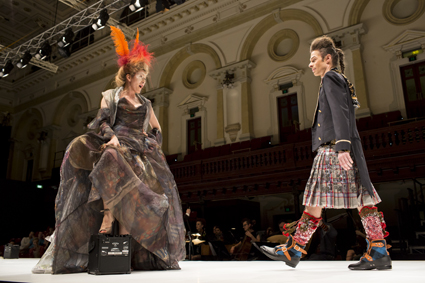
Aleksandra Zamojska, Armin Gramer, Semele Walk
photo Jamie Williams
Aleksandra Zamojska, Armin Gramer, Semele Walk
DESPITE MANY PRONOUNCEMENTS OF ITS IMMINENT DEMISE OVER THE LAST HALF-CENTURY AND MORE, OPERA APPEARS TO BE ALIVE AND KICKING.
New works are appearing regularly in the international repertoire, premiere productions are broadcast globally to cinemas and the internet provides a treasure chest of historical and recent productions. Two works, an opera-inspired ‘show’ and a Verdi classic in the Sydney Festival revealed both the appeal of and the challenges to a form that is enjoying revival and transformation.
semele walk
Semele Walk, a Sydney Festival centrepiece about a vain mortal who gets screwed for screwing a god, seduced audiences into surrendering themselves to astronomically priced high art, described by a friend as “80 minutes of froth…”
But Semele Walk was for more than opera goers—who were doubtless wary of spending big on a radically reduced version of Handel’s near three-hour 1744 opera Semele. It was the promise of the costuming by Vivienne Westwood, enduring queen of punk/haute couture crossover that attracted a multitude of fashionistas, fans and the simply curious. Clutches of wildly be-gowned Westwood worshippers swanned about the foyer, posing for elderly iPhone snappers, and were duly rewarded with the sight of a multitude of striking outfits displayed by strutting professional models and the lead instrumentalists in the small orchestra.
Two superb European singers and the orchestra did justice to Handel and director Ludger Engels made his catwalk scenario more than mere conceit. On a long, wide platform running the length of Sydney Town Hall, the models appeared other than human, hair swept up in nests, platform-booted, their flesh and materials seemingly hybridising, and faces otherworldly—half-veiled, masked by makeup and, of course, deadpan. They could have been a host of promenading lesser goddesses, gloriously in step with the music’s pulse and aetherial in mood as Handel’s soaring line.
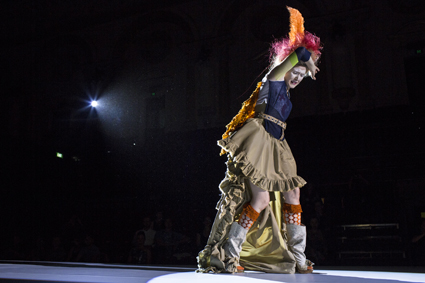
Aleksandra Zamojska, Semele Walk
photo Jamie Williams
Aleksandra Zamojska, Semele Walk
However, among them is a dissident—Semele, fashionably attired but neither spectacular nor as elegant, and nowhere near as tall. This mere mortal squeezes into the parade, is bumped and buffeted and then defeated, as she abjectly acknowledges, by her vanity. But pride wins out. Polish soprano Aleksandra Zamojska’s wildly red-headed Semele is brattish and unyielding. Having been seduced by Jupiter in human shape, she desires to make love to the god in his divine form and become immortal (this impossible idea has been planted by Jupiter’s jealous wife, Juno). Even when Jupiter tells Semele that she will be destroyed by the act she fatally proceeds. Zamojska conveys the joys and frustrations of her ambition with copious energy, dancerly verve and, above all, singing that is lucid and as crystalline as might warrant the transformation of Semele into a goddess.
Austrian counter tenor Armin Gramer as Jupiter is elegantly and seductively subdued, and the only character whose face is not masked—even Semele painted white. A series of intense encounters between the two, are by turns erotic, tender, argumentative and near violent, and better dressed. Once Jupiter gives Semele the Earth, inadvertently furthering her ambitions, her new multi-layered outfit of glorious transparent, opalescent material that captures light and amplifies movement, flies around her. Jupiter’s military dandy jacket, kilt and knee-high socks are bejewelled and threaded with silver.
Director Engels intensifies our sense of involvement with a surprise—fellow audience members burst into glorious, choral outpouring. The orchestra, placed halfway along the catwalk, to one side, is also a highly visible part of the performance, its Westwood-dressed members later taking to the stage like rock musicians. Plugged into portable mini-speakers they play out a strand of increasingly dissonant music that has been building between arias and duets as Semele’s passion threatens to destroy her.
In the end, Semele, determined to unite with her lover, walks into a huge, vertical baton of golden light (the real Jupiter revealed), disappearing in the blinding glare. Jupiter emerges pulling a small trolley along the length of the catwalk in the form of a golden bar—presumably ‘essence’ of Semele, since the chorus then joyfully celebrates the news that the offspring of Jupiter’s union with Semele will be a god, Bacchus.
Semele Walk proved to be an exhilarating experience, if not at all far from the many productions these days that fuse contemporary design, graphic art, fashion, architecture and media art with operas from the past. Of course, this economised version cannot do justice to the complete work, nor was it always intelligible. Unmiked singers meant that when they turned away from us words and notes evaporated. The too spare précis in the program and handout and the absence of surtitles meant that audience members tolerated degrees of mystification. Handel played second fiddle to Engels and Westwood, but Semele Walk was special. My friend concluded, “It’s froth—but what froth!”
a masked ball
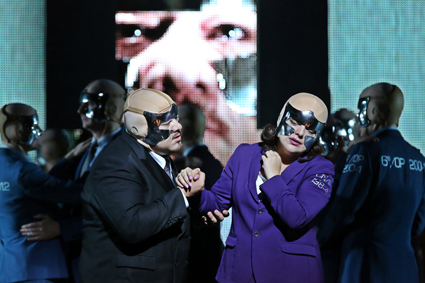
A Masked Ball, Opera Australia
photo Prudence Upton
A Masked Ball, Opera Australia
Musically, Opera Australia’s production of Verdi’s A Mask Ball (1859) is magnificent. Theatrically however it is at once adventurous and staid. Directed and designed by La Fura dels Baus’ Alex Olle, Alfons Flores and Lluc Castells, it takes the notion of the mask and pushes it to thematically rich if sometimes indavertantly comic extremes.
In a not too futuristic totalitarian society every one at first appears to be masked—politicians, bureaucrats and security guards—but not protesters, who are presumably regarded by the authorities as faceless. In the course of events, masks come off, revealing King Gustav’s lover to be the wife of his best friend, Renato. The vengeful Renato’s mask is removed after he has, as part of a conspiracy, assassinated Gustav during the ball of the title (here reduced to a rather tepid office party). Renato is forgiven by a dying, and unmasked king. Yellow gas seeps through the floorboards as gas-masked conspirators stage a deadly coup, the assembled elite dying as they sing of the horror they have witnessed. The directors have opted for a double dose of despair, just as the masking has been doubled—Renato was already a masked citizen before assuming a conspirator’s mask, the assembly is doubly masked at the ball. And why would a masked society stage a masked ball?
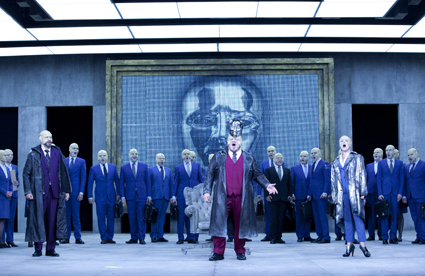
A Masked Ball, Opera Australia
photo Prudence Upton
A Masked Ball, Opera Australia
On the upside, the masking meant that the singers had to convey emotion principally through song and gesture for substantial parts of the opera. The scene between an unmasked, distressed Amelia and the masked, unforgiving Renato was particularly moving, as was Renato’s subsequent expression of his sense of loss. The mask motif achieved some measure of complexity and emotional power in these moments.
While masking provided the performers with a challenge, the set design did not. ‘Concrete’ columns and linking platforms flew up and down conveying a sense of sheer verticality—a building with executive suite, a vast bureaucratic space, the world of the street below, and beneath that a wasteland littered with junkies. However the deployment of performers could have come from any conventional staging of a traditional opera, quite at odds with the design’s futurism. Nevertheless this A Masked Ball was a bold, strikingly realised and thematically consistent creation, if over-determined in the end to the point of utter fatalism, but without ever underestimating the power and subtlety of Verdi’s music.
Sydney Festival: Semele Walk, A show by Ludger Engels, couture by Vivienne Westwood, music by George Frideric Handel, singers Aleksandra Zamojska, Armin Gramer, conductor Olof Boman,Solistenensemble Kaleidoskop, Sydney Philharmonia Choirs, models Chic Management; Sydney Town Hall, Jan 11-15; Opera Australia, Giuseppe Verdi, A Masked Ball, conductor Andrea Molino, director Alex Olle, designer Alfons Flores, costumes Lluc Castells, performers Diego Torre, Tayrn Fiebig, Jose Carbo, Tamar Iveri; Sydney Opera House, Jan 16-Feb 12
RealTime issue #113 Feb-March 2013 pg. 14
© Keith Gallasch; for permission to reproduce apply to realtime@realtimearts.net
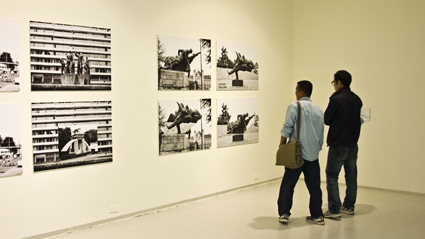
The Museum of Ante-Memorials, Robert Filliou
photo Hong-chi Huang, courtesy Taipei Biennal
The Museum of Ante-Memorials, Robert Filliou
THE 2012 TAIPEI BIENNIAL, TITLED MODERN MONSTERS / DEATH AND LIFE OF FICTION, RECONSIDERS MODERNISM THROUGH THE METAPHOR OF THE MYTHICAL CHINESE MONSTER TAOWU, A CREATURE ABLE TO SEE BOTH PAST AND FUTURE.
Sparking this theme is Taiwan-born Harvard Professor of Chinese Literature David Der-wei Wang’s The Monster that is History: Violence, History and Fictional Writing in 20th Century China (University of California Press, 2004). He states in the online catalogue:
“… never have we seen such a moment as we have in modern times, when official history has been so dictated by the ideological and institutional machines as to verge on make-believe, and representational art so arrested by a desire to reflect the past and future as to appropriate the functions of traditional history with respect to facts.” (Taipei Biennial webpage, 2012).
In examining the role of the museum and the appropriation of traditional history, curator Anselm Franke’s Taipei Biennial expands the field of art. Visiting it feels like visiting a museum of history and culture rather than an art exhibition.
priming the viewers
At the entrance of the magnificent Taipei Fine Arts Museum, viewers at the Biennial opening first encounter Hannah Hurtzig’s The Waiting Hall, Scenes of Modernity, where artists and theorists discuss aspects of modernity with members of the public in a series of booths, the conversations recorded for subsequent listening. Hurtzig asks, “What is modernity? an epoch, a condition, a mental state, an idea, a method or a technique?” (Catalogue). This forum primes viewers for engagement with history and the analysis of modernism, and establishes this engagement as a relational process.
artists as revisionist historians
The Biennial artists become revisionist historians: Joachim Koester considers the role of the Calcutta opium trade in 19th century British colonial expansion. To recall socialist internationalism, the Otolith Group shows archival photos of Indian women delegates on official visits to the USSR, Japan and China in the 1950s. Photographer Chang Chao-Tang’s work over several decades establishes an individual history of modern Taiwan. Maryam Jafri’s Independence Day 1936-1967 (2000), a photographic record of independence ceremonies in former African and Asian colonies that became new nations, addresses the concept of the nation state.
Central to this Biennial is the consideration of the nature of documentary film. John Akomfrah portrays the life and times of his teacher, noted cultural theorist Stuart Hall. Eric Baudelaire examines the lives of May and Fusako Shigenobu, the latter a former Japanese Red Brigade member, and Masao Adachi, an activist filmmaker. Kao Chung-Li’s biographical documentaries consider the history of Taiwan through the life of his father, a KMT member who fled China for Taiwan with the exodus following the Communist Revolution. Angela Melitopoulos and Maurizio Lazzarato’s videos analyse the work of influential psychiatrist and philosopher Félix Guattari.
the documentary as visual art
These documentaries are rich visual artworks dramatising particular cultures and events. Akomfrah’s three-screen work shows the British social conditions of Hall’s youth. Referencing the Japanese idea of landscape, Baudelaire blends Adachi’s material with his own as he reconstructs his subjects’ stories. Melitopoulos and Lazzaroto mix critical interviews on Guattari’s work with archival footage from his experimental clinic La Borde to challenge traditional psychiatry as a controlling device of the modern state.
Political commentary runs throughout the Biennial. In Roee Rosen’s video Out (2010), two women from the Israeli BDSM scene discuss and then conduct a bondage and discipline session in which the spirit of (then) Israeli Foreign Minister Avigdor Lieberman, regarded as a reactionary, is exorcised from the submissive masochist who quotes Lieberman during the beating, an overdubbed male voice replacing hers as the beating progresses.” Out metaphorises power structures and dependency, satirically critiques Israeli politics and suggests that bad ideas must be firmly exorcised from all of us. The two women are the actors playing themselves in this film, dissolving the boundary between documentary and fiction.
As Franke points out, “fiction—or the imaginary—nests at the centre of reality. It is through fiction-as-figuration that cognition and recognition becomes possible” (Catalogue).
museology as art
As well as individual artists’ works, the Biennial comprises several mini-museums curated by artists, overtly positioning museology as art and encompassing some novel approaches to historical research. The Museum of the Monster that is History includes James T Hong’s video compilation of apology speeches by government leaders, Kevin Rudd’s amongst them. Bavand Behpoor and Reza Abedini consider martyrdom through a display of anguishing personal accounts of the Iran-Iraq War. Hong, Tony Wu and Kelvin Park show equipment used in chemical weapons factories in Cold War Taiwan. And Eyal Weizman, Paulo Tavares and Steffen Kramer’s video The Mineral Geology of Genocide (2012) documents the forensic analysis of Guatemalan mass graves. This mini-museum utterly dispels any belief in the self-righteous or utopian claims of modern governments. It also repositions museums as critical devices in contemporary art.
Architects and urbanists Ann-Sofi Rönnskog and John Palmesino (aka Territorial Agency) co-curate the Museum of Infrastructural Unconsciousness, which explores how physical infrastructure and techniques of measuring and ordering influence society. It includes Nabil Ahmed’s samples of local drinking water, with hitherto undetectable traces of arsenic, which caused significant health problems in Taiwan, foregrounding the importance of measurement and metaphorising the slow impact of small, unseen forces on society. Rönnskog and Palmesino’s own contribution juxtaposes satellite imagery of the topological evolution of the island of Formosa with Taiwanese government archival records of significant events to demonstrate the interdependence of human activity and the environment and show how history and culture evolve from innumerable individual actions and political forces.
Eric Baudelaire’s overwhelming Museum of Ante Memorials comprises a copy of a 1945 memorandum to the US Secretary of War in which Manhattan Project scientists try (unsuccessfully) to persuade the US Government against using the atomic bomb on a city; a 1945 scientific observation film of the plane that dropped the Nagasaki bomb flying over the city of Kokura, which was the originally intended target that day; and Fluxus artist Robert Filliou’s 1970 work Commemor, in which he doctored photos to fictionalise the swapping of war memorials between European cities. These works are bookended by Peter Watkins’ The War Game (1965) and Deimantas Narkevičius’ The Dud Effect (2008). Watkins’ film, commissioned by the BBC but withdrawn because of its potentially alarming impact, sets out in documentary style a fictionalised account of nuclear war in Britain. Narkevičius’ film, depicting the launch procedure for Soviet nuclear missiles in the 1970s, is shown to counterpoint Watkins’ film.
None of the elements of Baudelaire’s mini-museum was made for the Biennial, and some were never intended as artworks. Most are now themselves significant historical artefacts. But assembling and recontextualising them in this Biennial creates an extraordinary artwork that, by offering alternative histories, questions the decisions taken.
museum futures: distributed
The pivotal work in the Biennial is Marysia Lewandowska and Neil Cummings’s Museum Futures: Distributed (2008), a sci-fi film set in 2058 that imagines the future history of the Swedish museum Moderna Museet, which commissioned the film in 2008 to celebrate its 50th anniversary. The film’s perceptive predictions include artificial intelligence, advanced communication and information management, and significant political change The startling (possibly tongue-in-cheek) prediction is that Moderna Museet becomes an ‘immanent’ institution that actively mediates cultural production, communication and understanding. The concept of relational art—art as social process—is thus extended to its logical conclusion, with the museum acting as the central organising principle in that process. The film is also institutional critique pushed to its logical conclusion—the idea of the museum is completely re-imagined. The film even predicts that Modern Museet will seek an amendment to the UN Declaration on Human Rights to “…extend certain rights to intelligent organic/synthetic composites.”
The adroit inclusion of Museum Futures: Distributed adds a whole dimension to the Biennial by projecting modernism forward 50 years—here, the monster Taowu sees the future as well as the past. If the predicted developments eventuate, they would constitute a highly contestable utopian, or dystopian, modernity. And in addressing how museum practice structures debate, underpins ideology and shapes society, the Taipei Biennial critiques itself.
Artists are turning historical investigation into powerful art and offering alternative, albeit idiosyncratic forms of history that can illuminate and even challenge conventional history. This Biennial’s concerted assembly of these critiques consolidates the role of the museum as a primary forum for such critique. The definition of art, now merged with philosophy and the social sciences more self-consciously than ever, is significantly expanded. Correspondingly, philosophy and the social sciences express themselves through art.
The Taipei Biennial, curator Anselm Franke, Taipei Fine Arts Museum and the Paper Mill, Taiwan, Sept 29, 2012-Jan 13, 2013; http://www.taipeibiennial2012.org/
RealTime issue #113 Feb-March 2013 pg. 10
© Chris Reid; for permission to reproduce apply to realtime@realtimearts.net
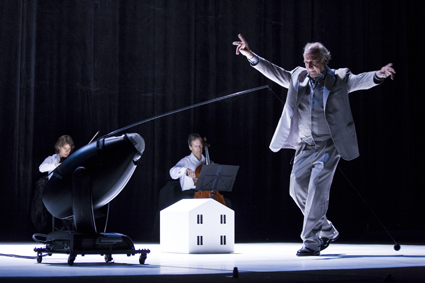
André Wilms, Eraritjaritjaka—Museum of Phrases, Heiner Goebbels
photo Jamie Williams
André Wilms, Eraritjaritjaka—Museum of Phrases, Heiner Goebbels
INTERNATIONAL ARTS FESTIVALS SET HIGH EXPECTATIONS—AUDIENCES WANT THE BEST, WORKS WE WOULD NEVER NORMALLY SEE AND WHICH WILL CHANGE US. IN AUSTRALIA THESE FESTIVALS HAVE BECOME INCREASINGLY AMORPHOUS, VAST AND VARIABLE IN QUALITY.
The 2013 Sydney Festival produced a few works in the 16 I saw of the kind that embed themselves in the psyche, but I was more impressed by the ever increasing diversity of practices that now constitute performance and have gradually found their way into international festivals. But save for a predictable festival choice, The Peony Pavillion, where was Asia in this the Asian Century?
Heiner Goebbels’ Eraritjaritjaka was thought provoking and, equivalently, perceptually disorienting, while Semele Walk (see p14) proved to be fabulous entertainment effectively built on a wittily apt conceit. Branch Nebula’s Concrete and Bones Sessions, played out in a suburban skate park at twilight, magically deployed public space and popular skills to superb effect. Sabab Theatre’s In the Eruptive Mode, Voices from the Hijacked Spring revealed great potential, testing and extending our empathy with its subjective accounts of lives in a troubled Arab world.
heiner goebbels, eraritjaritjaka
Eraritjaritjaka is an elaborate music theatre meditation built on collected aphoristic utterances from writer Elias Canetti (delivered by a senior actor, the wonderful André Wilms, featured in the Kaurismaki film Le Havre), 20th/21st century string quartets (performed by the brave instrumentalists of Mondriaan Quartett who have to frequently re-form around the stage), and a house. The house is successively: a tiny model, its chimney smoking, a huge upstage cut-out which serves as a screen for projecting the actor’s taxi ride home mid-performance (to an East Sydney apartment where he chops onions to Ravel’s pizzicato) and, to our bewilderment, a huge onstage interior behind the cut-out, in which the actor, quartet and cameraman are glimpsed, the smell of cooking leaking into the auditorium. We’re astonished.
The quartet thunders, resonant with our surprise. When did the actual become virtual, and vice versa? To what degree can we trust our senses and, not least, our memory? How can we have any sense of self in a society dominated by surveillance (the camerawork constantly reinforces this), by those in power (musings on the orchestral conductor “relying on the immobility of the audience”), by speed (“look for someone to make you go slow”) and anxieties about the emergence of machine creatures. The man rather cruelly attempts to train a stumpy, two-wheeled robot with an antenna as if it’s a pet (“Do animals have less fear because they lack words?”). The robot however has a darker function, surveillance: it casts a harsh spotlight on the man, and on us (“secrecy is power”). Beyond these concerns about a society in which “each man prays to his own portrait,” the man/Canetti/Goebbels wonders about music: he “wants a new music with new dangers,” but “words swim with music; I mistrust the flowing.” However, not only is he persistently anxious about control, but also about the capacity to express emotion: “I have no sounds that could serve to soothe me, no violoncello like him [indicating the cellist]…no lament that anyone would recognize as a lament because it sounds subdued.” “I have no sounds of mine to soothe.” Eraritjaritjaka is an utterly enveloping reverie, beautiful and bewildering, and performed with verve, agility and passion by André Wilms; indeed his/Canetti’s/Goebbel’s words, entwined with music and words do soothe. (You can read the text of Eraritjaritjaka at www.heinergoebbels.com.)
in the eruptive mode
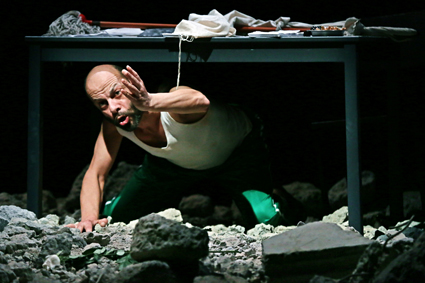
Raymond Hosni, In the Eruptive Mode, Sabab Theatre
photo Prudence Upton
Raymond Hosni, In the Eruptive Mode, Sabab Theatre
A work with much apparent promise, In the Eruptive Mode, written and directed by Sulayman Al Bassam, is a series of monologues reflecting on traumatic scenarios from the Middle East and beyond performed in English by visiting actors Raymond Hosni and Hala Omran, from Sabab Theatre (Kuwait/UK), and local Kym Vercoe. For the most part the monologues are deftly written and poetic, unfolding so that their implications effectively dawn on us. If at times accents make it difficult to decipher precisely what Hosni and Omran are saying, overall intentions can be grasped if not fully appreciated. Consequently I can’t altogether vouch for my account of the monologues.
A woman (Vercoe) in a flak jacket, face down on a table on a bed of rubble beneath harsh fluorescent light, muses over a lost pen, regards her hand as “a beautiful claw,” her eyes as fetching, but also as witnesses, her tongue “loose’ and “mawkish,” and wonders where her Kosovo cameraman is. She’s a journalist, perhaps wounded, certainly traumatised, attempting to pull herself together in the face of death—of the cameraman, of unnamed babies. Although near immobilised, Vercoe delivers a painfully incisive performance of a mind awaking from a delirium of too much pain, too much information.
A man slips out of lingerie and carefully attires himself in heavy traditional male clothing, covering himself almost entirely while speaking calmly of using “three to five vaginas a week” and noting the increased incidences of rape in the city. At the end he is an image of utter self-control and hatred of women and, implicitly, Western sexual freedoms. This is a chilling monologue, simple, but rooted in a powerful image of negative transformation. The third and much more complex monologue concerns a female doctor (Omran) whose male colleague “gets involved” politically with his patients, has to flee and is killed by a sniper at the border. Dying, he asks that his poems be sent to her. She reads them. Now she, like him, becomes “involved.” The writing is dense, the character detached, believing she is above ‘involvement,’ but the outcome is moving in a finely tuned performance. In total contrast, a man in a village or perhaps on a farm waves a white flag, praying that rebel forces will leave his family alone. Not only has he had to pragmatically swap sides but has already sacrificed his “demented,” dissident daughter, whom he cannot forgive. He is doomed; a simple man in a complex trap, convincingly portrayed by Hosni.
The least successful piece has an over-the-top, suited saleswoman (Vercoe) hard sell us a security plan for wealthy ‘investors.’ Low on effective irony this monologue is at a far remove from the others, where individuals live out their pain and dilemmas, including the final piece (where accent and sound system failure diminished intelligibility) in which a 28-year old woman surrounded by gunfire combs her hair, sings, polishes her gun and reflects on her love for her father. In an Eruptive Mood might be modest in scale and somewhat under developed, but its vision of psychological distress and trauma in a region in crisis is writ memorably large.
concrete and bone sessions
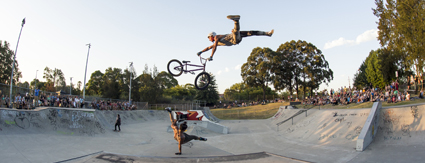
Concrete and Bone Sessions, Branch Nebula
photo Jamie Williams
Concrete and Bone Sessions, Branch Nebula
A suburban skate park, massive freight trains rumbling by, the sun breaking through gold-rimmed, rain-threatening clouds, wind through the trees—a stunning setting for Branch Nebula’s Concrete and Bone Sessions. The concrete is, of course, the skate park, the bones those of bold skaters, BMX-ers and dancers. This is site-specificity of the most immediate kind, a visceral connection to a place of play, not its social role or its history, in a display of what is often regarded as fun but here as art without losing the integrity of its popular foundations. The outcome is a visual spectacle, impeccably choreographed so that star turns are embedded in and shoot out of the mesmeric poetry of the grand sweeping collective rides and runs that transform the concrete into a magic, enabling vessel. Amplifying the action is a dynamic sound score, heavily percussive, dramatic, romantic and extended by performers wearing belt speakers, weaving sounds across the resonant concrete bowl. As for lighting, there was none, the magic of twilight and the weather was more than enough, a reminder of the everydayness of a suburban skate park and a celebration of its potential.
The power of Concrete and Bone Sessions comes from its lyricism, carefully paced, ever evolving, building towards escalating teamwork, spectacle and risk-taking but without turning into a series of stand-alone acts. The interplay between those on their feet and those on wheels escalates, as does the working of all dimensions of the park—edges to pivot on, walls to slide down, fences on which to elegantly parkour. Not least, thanks to the duration and pacing of the work, discrete personalities and styles emerge—degrees of reserve and flamboyance, but always within the work’s framework and pulse. There were many moments of magic, not least a freight train driver signalling his approval, the train’s horn blast and the rumble and screech of wheels merging into the show’s sound mix as BMX-ers flew high. Concrete and Bones Sessions was a festival highlight, a very special work, exhilaratingly focused on the beauty of collective movement and daredevilry. (See realtime tv video interview with Branch Nebula about the preparations.)
the secret river
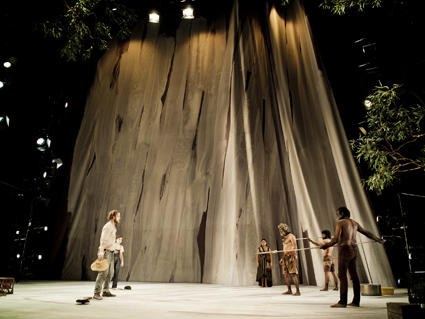
The Secret River, Sydney Theatre Company
photo Cassandra Hannagan/ABC Arts online
The Secret River, Sydney Theatre Company
STC’s The Secret River was not a favourite (I’m apparently alone in this, such has been the critical acclaim for the production) although I admired the performances, thought Stephen Curtis’ vast design superb (a massive wall of bark flowing from high, down into a wide stage cloth) and admired the largely faithful, economical reduction of Kate Grenville’s novel to a manageable two hours or so of stage time. The production also opened out stage time to allow a degree of focus on the Indigenous figures, making them strong if still secondary presences.
The strength of Grenville’s novel lies in the subjectivity it affords its principal character, the former convict William Thornhill. It’s a rich responsiveness to his condition and especially to the land he claims along the Hawkesbury. But it’s not something he can voice, because much of it is felt and intuited. In the dominant tradition of third person novel writing, the novelist’s voice goes unmarked but details for us nuanced thoughts, sensual feelings and emotional tensions as if coming from their subject. What goes on in Thornhill’s head, and to a degree other characters, is what makes this conventional novel a rewarding experience. We can intimately witness how Thornhill grows to love an alien land, senses the rights and wrongs of taking it for himself, understanding in some way that it belongs to someone else, and resists the urge to over-react to the Aboriginal presence—until things get out of hand. Much of this goes missing in the stage adaptation. Nathaniel Dean’s gruff but sensitive performance conveys some of the tensions, but not much more than the script allows. To compensate, adaptor Andrew Bovell has invented a narrator (Ursula Yovich), a young Aboriginal woman in 19th century dress who tells us a little of what Thornhill is thinking and feeling, but barely enough. At other times, the narration appears unnecessary.
Why have an Aboriginal narrator (hardly blind casting in a work of this kind) telling us what a white man thinks and feels in a story focused on his ambition, his pain and his success? Complicating the narrator’s role is her appearance as a character, curing Thornhill’s ill wife in a quasi-ritualistic moment of great emotion. In the novel a white woman provides the cure without ceremony. Perhaps research or a cast member recollection from family history provided this scene, or it’s simply a Bovell invention. Whatever it’s origins, it felt calculatedly melodramatic.
Could The Secret River have done without a narrator—a role that might be read as tokenistic by an Aboriginal audience? By Act II I was hungry for a monologue even—anything to give us something more of Thornhill than revealed through his blunt dialogue. Much will be written about The Secret River. Already several reviewers have declared its candidacy for ‘Australian classic.’ But I felt a palpable distance between myself and Thornhill, despite a strong performance. Of course, the novel form allows for considerable evocation of interiority, but many a play has done as well or better.
Indigenous writer Kim Scott’s award-winning novel That Dead Man Dance (2010), also set in the early 19th century, is another powerful evocation of subjectivity and first contact, this time from an Aboriginal point of view—unnervingly realigning our culturally informed sense of movement and space. A dramatized version could provide a welcome counterbalance to The Secret River. Doubtless The Secret River will become a national success, but whether or not it can contribute seriously to the “textual healing” some have claimed for it is another matter.
more sydney festival
In brief, I enjoyed the rich vein of inventiveness and humour that flowed through Belvoir’s Peter Pan and STC/Windmill’s School Dance; found that the melancholy reverie about deceased parents that is Conch Theatre’s MASI told us too little about them; thought Raimund Hogue’s Sacre—The Rite of Spring, had dated badly since offering such a strong conceptual challenge to dance in the early 2000s; wondered whether or not the adroitly performed The Moment I Saw You I Knew I Could Love You, by curious, added up to a cogent artistic statement; admired the dextrous puppetry of It’s Dark Outside, if uncertain of the efficacy of the work’s structure; revelled in the acoustic works in Ensemble Offspring’s Ligeti Morphed; and admired Camille’s delivery of Shakespeare’s verse in The Royal Shakespeare Company’s The Rape of Lucrece—but was appalled by the banality of the songs and the performer’s overacting. Erth’s Murder had an abundance of talent and promise but, after a strong start where it connected with its inspiration, the Nick Cave album Murder Ballads, it drifted away into its own complicated narrative albeit with flashes of inspiration and a strong central performance. And I heard very good things about Othello C’est Qui from Germany in the About an Hour series at Carriageworks, but festival timetable congestion prevented me from seeing it.
Sydney Festival 2013: Eraritjaritjaka—Museum of Phrases, words by Elias Canetti, performers André Wilms, Mondriaan Quartett, composed & directed by Heiner Goebbels, stage design and light: Klaus Grünberg, live video Bruno Deville, Theatre Royal, Jan 5-27; Sabab Theatre, In the Eruptive Mood, writer, director Sulayman Al Bassam, performers Raymond Hosni, Hala Omram, Kym Vercoe, design Sam Collins, lighting Marcus Doshi, music Lewis Gibson, Seymour Centre, Jan 8-11; Branch Nebula, Concrete and Bone Sessions, creators Lee Wilson, Mirabelle Wouters, performers/collaborators Jared Graham (Leerok), Antek Marciniec, Kat Williams, Marnie Palomares, Danny Campbell, Kathryn Pule, Michael Steingraber, Roland Chiouk, Cloe Fournier, Daniel Sparrow, sound/composer Bob Scott, dramaturg John Baylis, musicians Inga Liljestrom, Bree Van Reyk, Timothy Constable, Hugh Coffey, Jack Shanahan Reserve, Dulwich Hill, Jan 9-19; Sydney Theatre Company, Secret River, adapted from the novel by Kate Grenville by Andrew Bovell, director Neil Armfield, artistic associate Stephen Page, performers Nathaniel Dean, Bailey Doomadgee, Lachlan Elliott, Kamil Ellis, Roy Gordon, Iain Grandage, Ethel-Anne Gundy, Anita Hegh, Daniel Henshall, Trevor Jamieson, Judith McGrath, Callum McManis, Colin Moody, Rhimi Johnson Page, Rory Potter, Jeremy Sims, James Slee, Bruce Spence, Matthew Sunderland, Miranda Tapsell, Tom Usher, Ursula Yovich, set designer Stephen Curtis, costumes Tess Schofield, lighting Mark Howett, composer, musician Iain Grandage, sound designer, dramaturg Matthew Whittet, Sydney Theatre, Jan 12-Feb 9
RealTime issue #113 Feb-March 2013 pg.
© Keith Gallasch; for permission to reproduce apply to realtime@realtimearts.net
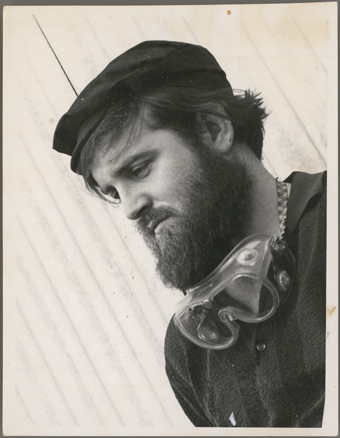
Albie Thoms, THE FILM: Documentation, 1966
image courtesy of National Film & Sound Archive
Albie Thoms, THE FILM: Documentation, 1966
ALBIE THOMS WAS A LEADING LIGHT. MUCH HAS ALREADY BEEN WRITTEN ON THIS REMARKABLE MAN’S LIFE AS EXPERIMENTAL FILMMAKER, ORGANISER AND REBEL; AS ANARCHIST AND ARCHIVIST. TO THESE RECOLLECTIONS WE WANT TO ADD OUR OWN THOUGHTS ON ALBIE, WHO WE REMEMBER, IN PARTICULAR, AS AN EVENT-MAKER EXTRAORDINAIRE.
This is where our interest started with Albie—in his early life as a theatrical impresario. As a student at Sydney University in 1965, he devised, produced, and directed an ambitious multimedia event, The Theatre of Cruelty, which requisitioned Artaud’s wild theories to apply them to texts by other canonical surrealists—Tzara, Schwitters, Huelsenbeck, Marinetti, Dali, Soupault and Jarry, from whose work he would shortly derive the name for his experimental collective, Ubu. We were excited by Albie’s application of Artaudian logic to other key moderns like Stein and Kokoschka, to contemporaries and works representing the future—the plays of Peter Brook, poems by Beat idols Ferlinghetti and Ginsberg, a short story by Australian/NZ sci-fi writer Cherry Grimm, and the experimental music of La Monte Young. What especially thrilled us about this program of live theatre and other, spontaneous performances (a little note at the bottom of the program reads, “Martin Sharp has organised happenings”) was the mix of live bodily performance and multimedia projections.
We admired Albie’s boldness in filming a version of Artaud’s typically unhinged ultra-short play, The Spurt of Blood. And we were especially fascinated with the work Poem 25: the famous Schwitters poem, consisting of a rapid sequence of numbers and numerals, which Albie’s partner in crime and soon-to-be-Ubu-comrade David Perry photographed, animated, edited and projected onto the body of an actor, whose job it was to recite the numbers as best he could remember. We loved this early expanded cinema performance so much that we sought permission from Albie and David to re-stage it in 2006, at our second OtherFilm Festival (assisted by small gauge film maven Louise Curham, with Brisbane radio personality Jamie Hume as ‘the body’) and then again in 2010 at our International Expanded Cinema Extravaganza at the National Film and Sound Archive in Canberra. Literally re-enacting this work is one of the most direct ways Albie Thoms’ influence is evident in our practice, but we need to acknowledge the deeper resonances and reverberations too.
Learning about the live audiovisual environments created by Ubu (Albie Thoms, David Perry, Aggy Read, David Clark) was especially catalytic for us. The idea of generating an all-encompassing atmosphere humming with multitudinous energies—spaces of transformation alive with light, sound and movement—stuck in our collective consciousness. Shortly after coming together, we launched into staging events where we revived the spirit of these 1960s atmospherics, in concert with our own post-rave, experimental music optics. Projections in all dimensions, the spectator’s body invoked as a continuous perceptive surface: the central inspiration we took from Ubu’s lightshows was of film potential, not as a narrative vehicle, but as popular sensoria. Cinema as event and encounter, not industrial story-machine. Film as part of a synthetic magma ruled by—as Albie was so fond of quoting—the Artaudian notion that “theatre is a delirium and should be communicative.”
With practice and politics comes praxis: Albie’s work with the Theatre of Cruelty and then Ubu reminded us that, historically, avant-gardes do not distinguish between the practical work of making and other kinds of work (such as event-organising, resistance, agitation, conservative-baiting). Rather, these practices complement and condition each other; they make most sense—or so we think—in terms of a dialectical unity. The cinema may be ‘contracted,’ but this is only an effect of the various machineries—optical, ideological, narrative—put in place by capitalism. To stick a wrench in that machine, we need only to turn it away from its intended purpose: take the screen away, turn the projections back on the performers or audience, multiply, subtract, reimagine, expand. Moreover, Ubu’s smart bootstrapping and effective promotion proved that ‘experimental entertainment’ wasn’t a contradiction in terms: OtherFilm developed an event-based practice partly as a result of this inspiration. For us, the commitment to a resourceful, generative experimental practice is one of the key legacies we trace back to Albie Thoms.
Over Albie’s life-time, experimental film went from being an exciting aspect of ‘underground’ culture to briefly being recognised and funded (via the newly-formed Experimental Film and Television Fund, which Albie headed), to the brink of near-extinction, only to be revived as an artists’ medium with a distinct presence in the gallery and art museum. When we spoke with him about it in 2011, Albie initially found it perplexing that in an era of so much digital choice, there was a distinct landscape of artists choosing to work with antiquated 35mm and 16mm film: even in his day, coming up with the ‘scratch’ for film stock and processing was always a challenge (hence the fundraising films like Blunderball, as well as 1967’s Handmade Film Manifesto and Ubu’s support of participatory filmmaking). Nonetheless, Albie quickly came to sense in this contemporary film practice a rebellion his soul could admire—especially the part about not being sensible.
He fondly recalled the days of shoestring bucket-processing and enthused over the aleatoric effects that “filmers” (his term for filmmakers) could court with their fickle, demanding, wonderful medium. Albie was pleased at the long-overdue recognition of film as a plastic aesthetic force, a creative medium that he saw continuing to unfold in surprising ways in the medium’s—and his own—twilight years.
Albie Thoms was a true luminary; he will light the way for us for many years to come.
Danni Zuvela and Joel Stern, with Sally Golding, are the directors of OtherFilm, which dedicated its fourth OtherFilm Festival (2012) to Albie Thoms.
Sydney Underground Movies 1965-1970: Ubu Films DVD available through Art Films: www.artfilms.com.au. See RT107 for review.
RealTime issue #113 Feb-March 2013 pg. 15
© Joel Stern & Danni Zuvela; for permission to reproduce apply to realtime@realtimearts.net

Lee Serle, P.O.V
photo Bart Michaels for Rolex
Lee Serle, P.O.V
FOR DANCE MASSIVE 2013, ARTS HOUSE, MALTHOUSE THEATRE AND DANCEHOUSE HAVE SELECTED 19 WORKS TO BE PERFORMED OVER TWO WEEKS IN MARCH IN THE ONLY FESTIVAL EXCLUSIVELY DEDICATED TO AUSTRALIAN DANCE.
The program, though kinaesthetically and thematically diverse, nevertheless reflects a number of common interests especially around notions of society, culture and the body. What kind of entity is the individual self? What is its relation to the social whole? How do selves coalesce?
The notion of repetition is another common Dance Massive theme, a mechanism which promises to be explored physically, linguistically, temporally and perceptually. Taken together, these works represent an intense manifestation, a critical mass, of dance culture in an Australian setting.
Why program so many dance works in such a short space of time? Dance Massive proposes an intensity, a shared focus between a roving, active population of spectators and performers not often achieved in Australia, at least, not in dance. According to Angela Conquet (Artistic Director, Dancehouse) a festival such as this can give an accurate, layered picture of the Australian dance landscape. This is not to say that everyone is represented here. Undoubtedly, some companies and artists are in between works. The very selection process, with finite resources and the exercise of choice, also rules out the participation of some. Landscapes are never all-inclusive. They have their own physiognomy, their own borders, topography and temporal flavour. So there is also a contingency to this festival. It is the expression of a critical mass, not an encyclopaedia. It is also an expression of place, of what can be generated in such a setting.
Dance Massive has a twin focus. On the one hand, it’s an opportunity for an audience to serially immerse itself in a multiplicity of works. On the other, it will enable a delegation of 20-odd international visitors to see full-length Australian works in their own cultural milieu. This differs from the narrower arts market concept which showcases and commodifies abridged pieces back-to-back for an international clientele. The exposure to a significant international audience means that Dance Massive offers an opportunity to show developed works which could tour both nationally and internationally. For this reason, Conquet says that this is not a forum for works-in-progress. According to Angharad Wynne-Jones (Creative Producer, Arts House), Dance Massive represents artists at quite different stages of their careers. Like the European platform, Dance Massive has the support of state cultural agencies—the Australia Council and Arts Victoria—but its artistic program is the child of the three venues, their artistic directors and selection committees. Angela Conquet is very appreciative of the dance literacy and involvement of Phillip Keir (Keir Foundation), one of the selectors and a key supporter of the Dancehouse program.
inside the program

Antony Hamilton, Melanie Lane, Black Project 1
photo Ponch Hawkes
Antony Hamilton, Melanie Lane, Black Project 1
A number of the programmed works embody social and political concerns. Ashley Dyer’s Life Support, for example, follows Something Fell on my Head, both of which give their audience the opportunity to directly experience their subject matter, whether through feelings of anxiety, finitude or vulnerability. Antony Hamilton (Black Project 1 & 2, see RT111 and RT108) and Tim Darbyshire (More or Less Concrete, see RT109), in their own ways, also mediate contemporary political and social issues. Atlanta Eke’s meditation on female mutability, Monster Body (RT110), is posed on a feminist present, while Jo Lloyd’s Future Perfect muses on constellations of identity in the cosmos of social life. Stephanie Lake’s Dual reflects the individual’s ability to cleave to the other thereby producing a new, synthetic entity. Whereas Lloyd poses the group in relation to the individual, Lake is interested in the notion of partnership, as embodied in duet form. In Black Project 1& 2, Antony Hamilton explores another kind of interplay within and without the human, between life and non-life, an unstable cosmos.

Dalisa Pigram, Gudirr Gudirr, Marrugeku
photo Rod Hartvigsen
Dalisa Pigram, Gudirr Gudirr, Marrugeku
The social and cultural sphere has several modes of incarnation. Dalisa Pigram’s solo work, Gudirr Gudirr, simultaneously spans the collective concerns of Northwestern Aboriginal people through the singularity and cultural breadth of her own body. Soo Yeun You’s Gu:t collaboratively enters aboriginal spirituality through the lens of her own shamanistic background, felt at the level of the kinaesthetic everyday. Not that every body isn’t in some sense a product of culture, time and motion.
While Russell Dumas’ fine work is indebted to the postmodern choreographic legacy of Twyla Tharp and Trisha Brown, his dance for the time being—Southern Exposure has a local inflexion. As a manifestation of what is possible in the space and time of Australian dancing, Dumas’ work is formulated over the abyss of the present. Dumas “reimagines the unstable body” in relation to the (im)possibility of a future dance practice. Nothing is fixed. Likewise, Ben Speth’s WeTubeLIVE (RT112) feeds on an unstable, undetermined network of possibility. Its mode of community is enactive, a mass playing out of virtual choreographies ripped from the internet and staged for live capture in the dappled kaleidoscope of the National Gallery’s Great Hall. While Speth, Dumas and Pigram are each in their own way oriented towards the future, Tracie Mitchell’s dance film retrospective shows film’s enduring ability to reach into the present.

Conversation Piece, Lucy Guerin Inc
photo Brett Boardman
Conversation Piece, Lucy Guerin Inc
If Larissa McGowan (Skeleton; see interview, p26) is concerned with the bare bones of the anatomical trace, The Recording continues Sandy Parker’s prior interest in the dynamic physiology of a work. Whereas the earlier Document (interview RT103; review RT105) was oriented towards the marks on the page or screen, The Recording aims to open up the process whereby live dancing becomes a series of cinematic images. Difference provokes transformation. This is also a factor in Lucy Guerin’s work, Conversation Piece (interview RT110; review RT111) which plays on the changes set in motion through repetition. Paradoxically, repetition does not engender serial sameness but is the means by which difference is produced. Words and movement played again institute an event, the becoming different of something recognisably the same. Matthew Day also plays with difference through repetition in Intermission (interview RT109; review RT110), a durational, rhythmic work that aims to create its own perceptual milieu. Intermission is the third in Day’s series of pieces, each concerned with the mutating force of repetition. Tim Darbyshire’s More or Less Concrete (RT109) is also interested in the effects of the cyclical as is Natalie Abbott in her work, Physical Fractals (see RT109 online). The singular is reflected in our conception of the unique individual who is simultaneously a participant of the social whole. In 247 Days, Chunky Move artistic director Anouk Van Dijk continues her interest in the social and the political with a work focused on the individual. While her An Act of Now (interview RT111; review RT112) was strongly site specific in its deployment of the Sidney Myer Music Bowl, 247 Days takes as its spatial premise Malthouse’s cavernous, black box Merlyn Theatre.
Personally, I find it difficult to tell what a piece will be like from reading about it. Such is the elusive potential of live performance that it cannot be fully represented in words. Words lean towards the event, they strive towards it, but they cannot fully embrace what is yet to come. Dance Massive offers a sustained opportunity for a series of live relations between the work and the audience, a portal of potential. That said, Conquet regards the durational aspect of dance as something that needs time in between viewings; to allow the sensorial dust to settle, or better still, to reverberate. Taking time on the part of the spectator allows for the “preservation of sensations” the better to amplify their impact. However you do it, you have 12 days to pace yourself or, as Wynne-Jones suggests, to “go for the ride.”
Read reviews of works in Dance Massive 2013 drawn from RealTime’s archive.
talk about going to pieces!
keith gallasch: lucy guerin, conversation piece, belvoir
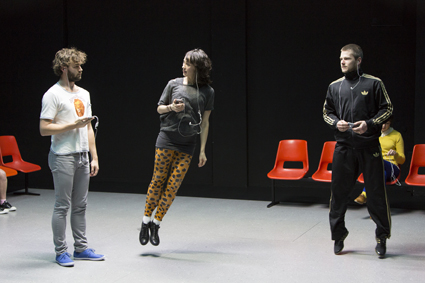
Rennie McDougall, Harriet Ritchie, Alisdair Macindoe, Conversation Piece, Lucy Guerin Inc
photo Brett Boardman
Rennie McDougall, Harriet Ritchie, Alisdair Macindoe, Conversation Piece, Lucy Guerin Inc
“A powerful dance/theatre hybrid… Conversation Piece makes the mind work, the audience delighting in its play with their intelligence as it draws into consciousness their inherent knowledge of how talk works and they witness the palpable physicality that is ambiguously entwined with it.”
RT111
Se also Keith Gallasch’s interview with Lucy Guerin about Conversation Piece and Weather in RT110; and also Guerin’s extensive profile in RealTimeDance
melded minds & bodies
john bailey: antony hamilton & melanie lane, clouds over berlin

Antony Hamilton, Melanie Lane, Black Project 1
photo Ponch Hawkes
Antony Hamilton, Melanie Lane, Black Project 1
“Hamilton & Lane appear as gleaming black wraiths making their way across a post-urban wasteland. It’s a vision that gestures to the choreographer’s earlier interests—aerosol art, digital tech, breakdance—while stripping away any literal referents. The dance itself may be Hamilton’s most developed and sustained exploration of his own practice.”
RT108
See also Keith Gallasch’s review as part of Spring Dance in RT111
tweaking reality
philipa rothfield: this monster body and one show only
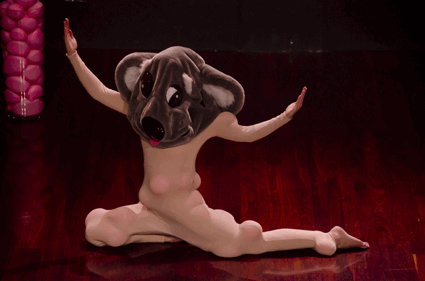
Monster Body, Atlanta Eke, Next Wave Festival 2012
photo Sam Ackroyd
Monster Body, Atlanta Eke, Next Wave Festival 2012
“Atlanta Eke was born decades after the advent of second wave feminism. She doesn’t need to make space to be heard. She can invent. This Monster Body is an attempt to create something and in so doing to destroy something else, to rattle the bars of the cage so as to break with convention.”
RT110
See also Jane Howard’s review as part of Next Wave 2012 in RT109
the body: beginning and end
keith gallasch: matthew day, intermission; adt, be your self
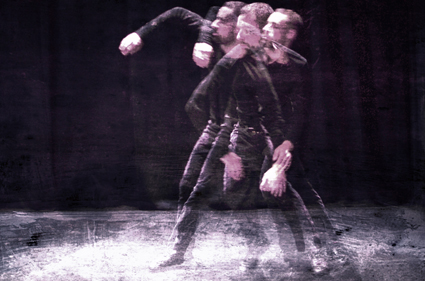
Matthew Day, Intermission
image James Brown
Matthew Day, Intermission
“Intermission feels personal and purgatorial, although Day’s interests as expressed in interviews and his program notes indicate no such inclination towards self-exploration. Even so, the work is a dark pleasure, its grim beauty born of its curious suggestiveness and a relentless wave structure.”
RT110
See also Keith Gallasch’s interview Matthew Day about preparations for Intermission in RT109
between god and human
philipa rothfield: jo lloyd’s future perfect
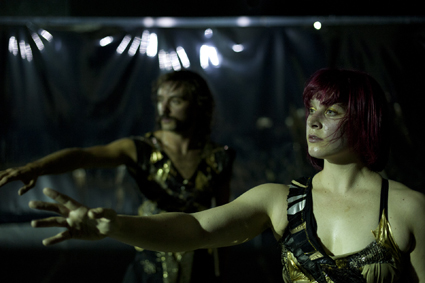
Luke George, Madeleine Krenek, Future Perfect
photo Rohan Young
Luke George, Madeleine Krenek, Future Perfect
“The strength and power of Future Perfect is found at a distance, in the slow transformations of the group, in the ways in which, together, the group becomes bigger, more than human. That distance in turn enables perception to be freer, able to stray into the neighbourhood of the imaginary..”
RT106
at the crossroads of the senses
varia karipoff: tim darbyshire, more or less concrete
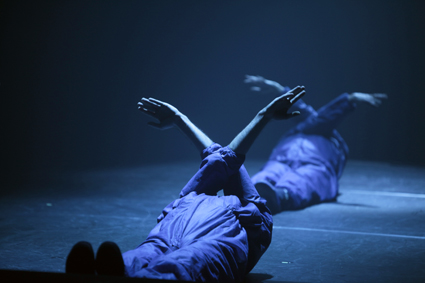
More or Less Concrete, Tim Darbyshire
photo Ponch Hawkes
More or Less Concrete, Tim Darbyshire
“In More or Less Concrete, the audience witnesses a kind of abstraction of the body and its movements. The slow, dreamy pace makes this as much a study in sculptural forms as dance. Through sensory-challenging sound and lighting, it is also a retelling of these snatches of memory through performance.”
RT09
next wave day tripping
jane howard: 2012 next wave’s day passes inc natalie abbot, physical fractals
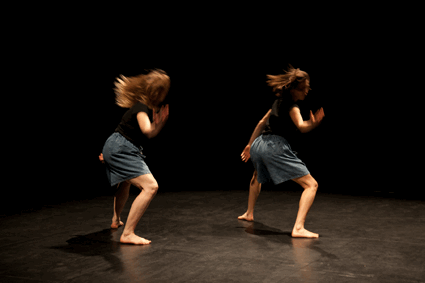
PHYSICAL FRACTALS, Natalie Abbott, Next Wave Festival 2012
photo Pia Johnson
PHYSICAL FRACTALS, Natalie Abbott, Next Wave Festival 2012
“The performance builds in a series of repetitions, torsos bent over and arms circling as feet scoot back across the floor, before the dancers return to stand on the rim of the circle. Patterns repeat, so when one of the dancers moves in a slightly different direction it is startling.”
RT109 online
oh how they danced!
virginia baxter: oh I wanna dance with somebody inc ben speth’s wetubelive
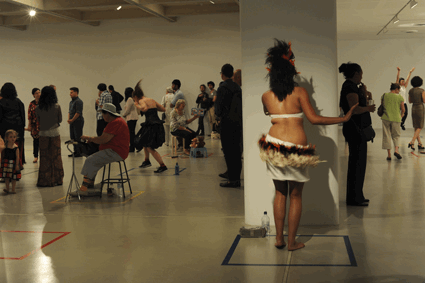
WeTube Live, Ben Speth, Oh I Wanna Dance With Somebody
photos Heidrun Löhr
WeTube Live, Ben Speth, Oh I Wanna Dance With Somebody
“There was a great sense of community engagement as sensuous hula shimmied alongside boot scooting and hysterical dummy-spit met cute kitty. ”
RT112
See also coverage of WeTubelive at Junction Arts festival in RT99
realtime dance archive
For more on artists featured in Dance Massive check out our Dance Archive which includes all articles about dance since 1994, categorised by choreographer, company, festivals and more.
RealTime issue #113 Feb-March 2013 pg. web
© RealTime ; for permission to reproduce apply to realtime@realtimearts.net
utp, _space residencies
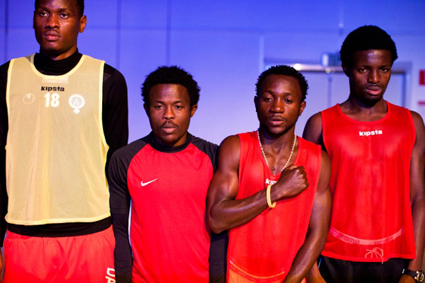
Michael Essien, I want to play as you, directed by Ahil Ratnamohan, commissioned by UTP and presented by UTP and CCLuchtbal. Feb 2-9, Antwerp
photo Koenbroos
Michael Essien, I want to play as you, directed by Ahil Ratnamohan, commissioned by UTP and presented by UTP and CCLuchtbal. Feb 2-9, Antwerp
Urban Theatre Projects in Bankstown are calling for applications for their _SPACE residency program. Successful artists will receive access to the large rehearsal space as well as administrative and dramaturgical support. The residencies are for two week blocks in April, August and November 2013. Applications are encouraged from Western-Sydney based artists as well as those interested in engaging with the local community.
Applications due Feb 22, http://urbantheatre.com.au/current-projects/_space-residency-program/
[Image note: Ahil Ratnamohan is a long time associate of Urban Theatre Projects developing his first full length work The Football Diaries in 2009 (see RT91) with the help of a UTP residency. His latest project, commissioned by UTP takes place in Antwerp premiering at the AESP Sport Opening Ceremony, and continues his interest in football as choreography and the experience of players seeking new lives in foreign countries. Antwerp Feb 2-9; http://urbantheatre.com.au/current-projects/michael-essien-i-want-to-play-as-you/]
r e ross trust playwrights’ script development awards
The State Library of Victoria oversees the R E Ross Trust Playwrights’ Script Development Awards which are for the development and workshopping of new plays. The award is open to Victorian writers who can apply for between $3,000 and $10,000. “Winners also have the opportunity for rehearsed readings at Flashpoint at the State Library of Victoria or fortyfivedownstairs, and one recipient may be invited to either showcase their play at PlayWriting Australia’s National Play Festival 2014 or receive a two-week PlayWriting Australia script development workshop” (press release). See in the loop: quick picks for info on the 2013 National Play Festival in Perth.
Applications due March 22; slv.vic.gov.au/ross
studios and exhibtions, gaffa gallery
Gaffa Gallery in Sydney’s CBD currently have studio spaces available. These studios offer access to the communal workshop which features a range of useful tools. Resident artists may also have the opportunity to display work in the emerging practitioners retail section of the Gaffa Shop. Gaffa is also seeking expressions of interest from artists wishing to exhibit with them between August and December 2013.
Studios http://gaffa.com.au/how-to-apply; exhibitions http://www.gaffa.com.au/Gallery-Hire
police lane gallery, ballarat
Ballarat’s Arts and Culture Public Art Advisory Committee has announced a new public art venture for the city. The Police Lane Gallery will comprise the outside wall of the Ballarat Art Gallery which will house five 2x1metre vinyl banners. Exhibitions will run in six weeks blocks across 2013.
Expressions of Interest due Feb 28; email juliecollins@ballarat.vic.gov.au
international summer school, iugte
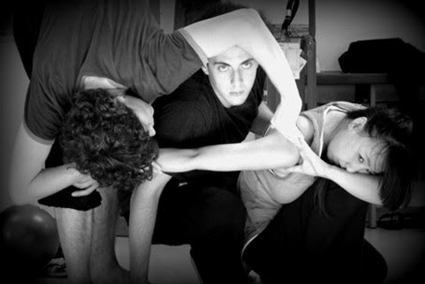
Physical Theatre Lab
photo Inga Ryazanoff, IUGTE
Physical Theatre Lab
The International University Global Theatre Experience (IUGTE) offers a range of labs and workshops across the year with an emphasis on “exploring the bridge between world theatre traditions and contemporary performing arts” (website). They have just announced their summer school which will be an International Physical Theatre Lab. Drawing on the methods of Russian theatre director Sergei Ostrenko it will use techniques introduced by early 20th century masters such as Stanislavsky, Chekhov and Meyerhold as well as Tai-Chi and contemporary forms. The workshop is suitable for experienced dancers, actors of physical theatre, contemporary circus performers, choreographers and directors and takes place in the Retzhof Castle in Leitring bei Leibnitz, Austria.
International Physical Theatre Lab, IUGTE, Austria, July 1 – 6; http://www.iugte.com/projects/lab
still in the loop
(see full article)
Western Australia Contemporary Dance Initiative
Applications due Feb 8, 2013; http://www.australiacouncil.gov.au/grants/2013/western-australian-contemporary-dance-initiative
more…
2013 ICMC, Edith Cowan University
Deadline for papers & works Feb 11, 2013; ICMC Aug 12-16, 2013; http://icmc2013.com.au/
more…
Brisbane Festival, Independent Performance Works
Applications due March 8, 2013; http://www.brisbanefestival.com.au/
more…
Borough of Queenscliffe’s 150th Anniversary Art Awards
Entries close March 13, 2013; http://www.queenscliffe.vic.gov.au/boq_150th_anniversary.php
more…
Bayside Artists-In-Residence
Applications close March 29 2013;
http://www.bayside.vic.gov.au/arts_artist_in_residence_program.htm
more…
Australian Antarctic Arts fellowship
Applications due March 30, 2013; http://www.antarctica.gov.au/media/news/2013/arts-fellowship-applications-open
more…
Chippendale New World Art Prize
Applications close April 16, 2013;
http://chippendalecreative.com/art-prize/
more…
RealTime issue #112 Dec-Jan 2012 pg. web
© RealTime ; for permission to reproduce apply to realtime@realtimearts.net
February sees the play celebrated across the country with Yellamundie at Carriageworks in Sydney and the National Play Festival in Perth, as well as announcements of new awards to deserving playwrights. More lateral approaches are anticipated from emerging artists at PACT, The Public Studio in Melbourne, a real life human experiment in ANAT’s The Subjects, political provocation courtesy of Richard Bell at MUMA, seminal sonics from Deutschland and more…
And if you missed last week’s in the loop you’ll find current events listed at the end for easy access.
yellamundie, carriageworks
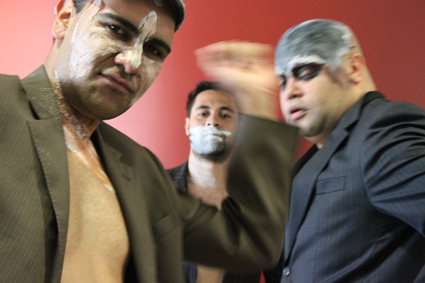
Sonny Dallas Law, Bjorn Stewart, Colin Kinchela, Bully Beef Stew, PACT Centre for Emerging Artists
photo Cat Jones
Sonny Dallas Law, Bjorn Stewart, Colin Kinchela, Bully Beef Stew, PACT Centre for Emerging Artists
Mooghalin Performing Arts’ Yellamundie: National Aboriginal and Torres Strait Islander Playwriting Festival is now in full swing at Carriageworks. After a launch during the Sydney Festival, six plays have been in development with public play readings taking place Feb 7-9. The plays include Cuz by Billy McPherson, First Contact by Jane Harrison (guest editor of RealTime’s RealBlak edition) and Crowbones & Carnivores by David Milroy (also featured in RealBlak). There’ll be readings of plays by emerging playwrights who have been taking part in Redfern Salon, presented in partnership with Playwriting Australia, Redfern Community Centre and Belvoir. You can read director Frederick Copperwaite’s article on the festival in RealBlak.
Yellamundie, play readings and salon Feb 7-9, Carriageworks; http://www.carriageworks.com.au/?page=Event&event=Yellamundie
national play festival, perth
Playwriting Australia is having a busy month also producing the annual National Play Festival in Perth this year at the State Theatre as well as contributing to Yellamundie. A range of new plays will be presented via rehearsed readings including adventurous new works by Declan Greene, Andrea James (see RealBlak and RT105) and Angus Cerini (See RT107 and RT102). There’s also an emphasis on writing for younger audiences with readings of works by Lachlan Philpott, Casey Nicholls and Kit Brookman as well as a showcase of emerging talent from Western Australia.
National Play Festival, State Theatre, Underground Studio, Perth Feb 21-24; http://www.pwa.org.au/nationalplayfestival2013/
awf playwriting awards announced
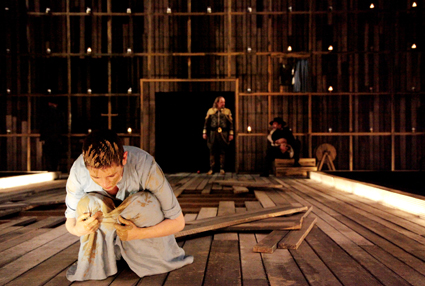
Yael Stone, A Golem Story, writer Lally Katz
photo Pia Johnson
Yael Stone, A Golem Story, writer Lally Katz
Still on playwright matters, Declan Greene (see above) and Lally Katz (see RT104 and RT95) have just been named as the inaugural recipients of the Australian Writers’ Foundation Playwright Award. The AWF is the charitable wing of the Australian Writers’ Guild; each writer will receive $15,000 to assist in their career development. (See in the loop: opportunities for the State Library of Victoria’s playwriting awards.)
Australian Writers Guild http://www.awg.com.au
harvest, pact
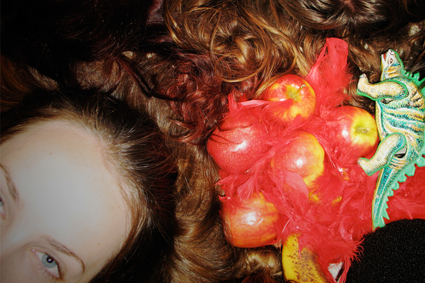
Harvest. PACT Centre for Emerging Artists
photo Julie Vulcan
Harvest. PACT Centre for Emerging Artists
PACT Centre for Emerging Artists’ training program is now in its 15th year and we’re about to discover the latest crop of talent in the annual ensemble production, Harvest. This year it’s directed solo by Acting Artistic Director Julie Vulcan while Cat Jones makes the most of her Creative Australia Fellowship. Harvest explores “the world we live in through food, consumption and waste. Examining habits and the rituals that sustain us…When is one person’s insane act another’s act of sanity?” (press release). The opening night will also include the launch of PACT’s 2013 program.
Harvest, PACT Centre for Emerging Artists, Feb 20 – March 9, official opening and program launch, Feb 22; http://www.pact.net.au/2012/10/ensemble-2013/
until then, then, the public studio
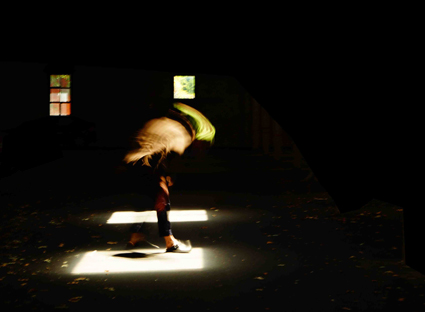
Until Then, Then, The Public Studio
courtesy the company
Until Then, Then, The Public Studio
In RT73 John Bailey was impressed by performer/director Ming-Zhu Hii’s take on Yoko Ono in her Next Wave performance Y. He wrote, “The personal, political, fiction and fact are interwoven in a way which doesn’t result in an undifferentiated miasma but instead produces the sense, if not the logic, of an artist frequently written off as a relic of counterculture aestheticism.” Her subsequent work Attract/Repel featured in the 2009 Melbourne Fringe. Ming-Zhu Hii returns after a three-year break to present a new work in her collaboration with Nicholas Coghlan which is titled The Public Studio. The production Until Then, Then is an audio visual installation inspired by Baroque vanitas in which the central character, King Fool, is “searching frantically for answers about his own apparent death and ultimately—the meaning of life” (press release).
The Public Studio, Until Then, Then, La Mama, March 6-10; http://thepublicstudio.net
See also Ming-Zhu Hii’s article for RT85 on cross-racial casting.
the subjects, anat

Sean Williams, Fee Plumley, Thom Buchanan, Jennifer Mills, The Subjects, ANAT
The latest project from the Australian Network for Art and Technology is a kind of reality tv-lab rat-residency hybrid. Four artists have agreed to subject themselves to sleep deprivation under the supervision of scientists while attempting to be creative during the process. The artists/subjects are self-confessed techno-evangelist Fee Plumley, painter and cross-disciplinary artist Thom Buchanan and authors Sean Williams and Jennifer Mills. The experiment will take place at the Appleton Institute under the watchful eyes of director Professor Drew Dawson and sleep and circadian physiology researchers Greg Roach, Charli Sargent and Xuan Zhou.
Follow the experiment’s progress at http://thesubjects.anat.org.au/; Feb 9-16
richard bell: lessons on etiquette and manners, muma
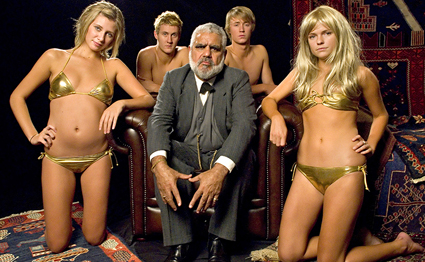
Richard Bell, Scratch an Aussie 2008 (production still, detail), courtesy of the artist and Milani Gallery, Brisbane
photo Mick Richards
Richard Bell, Scratch an Aussie 2008 (production still, detail), courtesy of the artist and Milani Gallery, Brisbane
Opening the 2013 season at Monash Museum of Modern Art is the first Melbourne survey of the work of painter, multimedia artist, activist and agent provocateur Richard Bell. Brisbane-based, Bell is a member of the Kamilaroi, Kooma, Jiman and Gurang Gurang communities and has been creating work that is political and humorous, particularly paintings, since the 1990s. For this exhibition he will present Peace heals, war kills (Big ass mutha fuckin mural) 2011-12, a collaboration with Emory Douglas, former Minister of Culture for the Black Panther Party in the United States, as well as recreating the 1972 Tent Embassy inside the gallery, which will also be the venue for a series of talks by radical Indigenous leaders.
Richard Bell: Lessons on Etiquette and Manners, curated by Max Delany and Francis E. Parker, Monash Museum of Modern Art, Feb 5- April 3; www.monash.edu.au/muma
tools, kawita vatanajyankur, beam contemporary
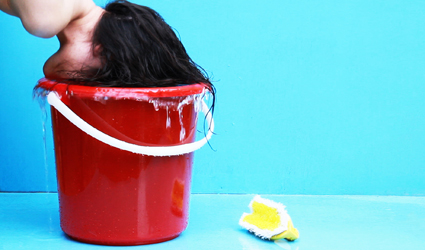
Kawita Vatanajyankur, Soaked, 2012
video still, courtesy of the artist
Kawita Vatanajyankur, Soaked, 2012
Thai-born Melbourne-based video artists Kawita Vatanajyankur’s exhibition Tools uses the female figure in 17th century still-life paintings as a starting point. However, in her video pieces she “brings the female body into a new stark environment where body and domestic object conflate and seem to physically react and violently communicate with each other.” We are intrigued…
Tools, Kawita Vatanajyankur, Beam Contemporary, March 1-16, http://www.beamcontemporary.com.au/
einstürzende neubauten & pole
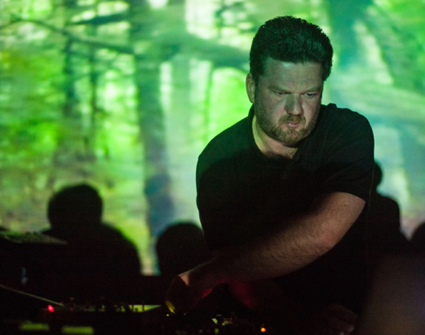
Pole, UnSound
photo Anna Spysz
Pole, UnSound
Not one but two greats of late 20th century German music are about to tour Australia. Industrial krautrock legends Einstürzende Neubauten will be appearing in Melbourne courtesy of the Drones curation of I’ll Be Your Mirror (a side project of All Tomorrow’s Parties) as well as playing extra gigs in Melbourne, Sydney and Brisbane. Also on the festival circuit courtesy of Goethe Institut is Pole (Stefan Betke), the purported inventor of glitch. He’ll be performing as part of UnSound at the Adelaide Festival as well as in Sydney and Brisbane.
Einstürzende Neubauten, Melbourne: I’ll be your Mirror, Feb 17 & Palace Theatre, Feb 19; Sydney: Enmore Theatre, Feb 22; Brisbane: The Tivoli, Feb 23; http://handsometours.com/current/einsturzende-neubauten; Pole, Adelaide Festival, March 16; Brisbane: IMA, March 21; Sydney: Sound/Light/Stone, March 22; http://www.goethe.de
still in the loop
In Between Time 13, Bristol, UK
Feb 14-17, 2013, exhibition Feb 2-April 14; http://ibt13.co.uk/
more…
The Transmuted Signal
Broadcast on air and online Feb 3 & 10, and March 3 & 10, 2013; www.kunstradio.at; www.frequencyoz.com
more…
Blak Nite Cinema
Presented by the City of Melbourne, ACMI (Australian Centre for the Moving Image), Federation Square; Feb 8-10; www.thatsmelbourne.com.au/Whatson/blaknite/Pages/BlakNite.aspx
more…
Colour Box Digital Media Exhibition
Footscray, Jan 16-Feb 27, 2013; http://colourboxstudio.com/
more…
Sonic Acts: The Dark Universe
Feb 21-24, 2013, exhibition open now; http://2013.sonicacts.com/
more…
Wim Vandekeybus/Ultima Vez, What The Body Does Not Remember
Adelaide Festival, March 7-9; www.adelaidefestival.com.au/2013/dance/what_the_body_does_not_remember
more…
RealTime issue #112 Dec-Jan 2012 pg. web
© RealTime ; for permission to reproduce apply to realtime@realtimearts.net
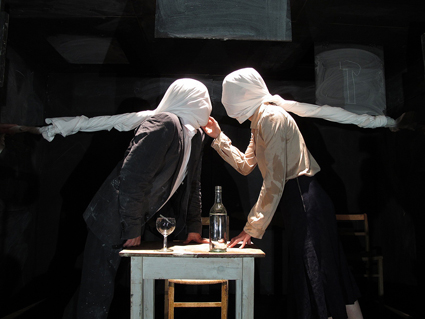
Reckless Sleepers
photo philpottdesign.com
Reckless Sleepers
NOT KNOWN FOR UNDERSTATEMENT, PERFORMANCE SPACE’S LATEST SEASON IS A DRAMATIC CALL TO ACTION—IT’S A MATTER OF LIFE AND DEATH.
While it’s a compact season, taking place Feb 23-March 9, it promises to help you live for the moment, with three major performance pieces, a Night-time short works event, Clubhouse activities and workshops all focussed on that sticky subject, mortality.
The headlining performance is from UK/Belgian company Reckless Sleepers presenting The Last Supper. In RT107 Megan Garret-Jones described the performance she witnessed at the Compass Festival in Leeds: “The Last Supper interrogated storytelling and history-making with what transpired almost as a word-association game of recalling the notable dead and literally eating their words, squares of paper disappearing into the performers’ mouths once their contents were recited. Performers and audience sat at dinner tables on the stage, intimately sharing the last meals of executed prisoners as distributed through a kind of raffle. We considered martyrs and criminals alike as defined by their last words and meals. We considered whether we were supposed to eat the cheeseburger and decided we were.” It’s an intimate performance for 39 guests. Each has a case number and it seems that for 13 of them, this could be their last meal. (Feb 27-March 9)
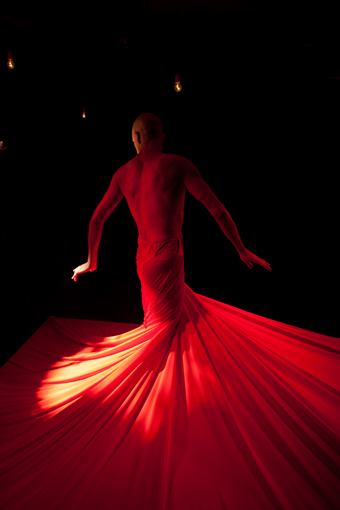
Brian Lucas, Performance Anxiety
photo Fiona Cullen
Brian Lucas, Performance Anxiety
Running simultaneously is Brian Lucas’ Performance Anxiety. Here we are invited into an intimate cabaret in which Brisbane-based choreographer/performer Lucas adopts roles of torch singer, war correspondent, orator and stand-up comedian. He shares tales of the large and small battles that an individual must undertake to be part of society. (Feb 27-March 2)
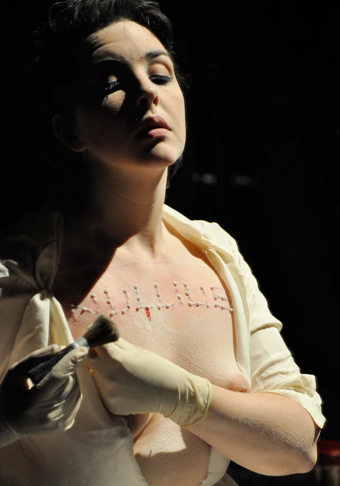
Sarah-Jane Norman, Corpus Nullius/Blood Country (2011), part of the Unsettling Suite
photo Penelope Benton
Sarah-Jane Norman, Corpus Nullius/Blood Country (2011), part of the Unsettling Suite
Much anticipated is Sarah-Jane Norman’s performance installation, Unsettling Suite which brings together four of Norman’s major works exploring her English and Indigenous heritage. In RT111’s RealBlak Norman wrote of her projects: “In preparation for Bone Library, I’ve spent nearly a year, it seems, with blood permanently encrusted under my fingernails, the result of months spent cleaning animal bones, pushing out plugs of bloody marrow; and I’ve gradually learnt the best spots on my own body, with its recalcitrant veins, to draw blood, having trained myself via the many DIY hotel-room phlebotomies that have had to be discreetly performed for Take this, for it is my body. Materially, physiologically and symbolically, blood is an undoubtedly fascinating substance.” This thought provoking epic is not to be missed. (Feb 23-March 10)
There is also a night of short works curated by ever-inventive writer, performer and curator Eddie Sharp titled Live and Let Die (March 2). Clubhouse will offer one-off events across the season such as Death(cha) Kucha by the Centre of Excellence for the History of Emotions presenting their research into the history of execution; and Desensitising Death: A Night of Film by Mu Meson archivists Miss Death and Jay Katz screening ads and clips which have inspired horror filmmakers. Celebrant and artist Vicki Spence will share her ongoing research into contemporary rituals around death in her presentation Mortality Talking.
But it’s not all about death and loss, there’s also Making Time (Feb 23, March 2, March 9), a workshop by Make Shift and Tessa Zettel which will literally explore preservation. Here you’ll learn jam-making, bottling and preserving methods ideal for foraged, native or backyard surplus foods. It might almost make life worth living.
Performance Space, Matters of Life and Death, Feb 27-March 10, Carriageworks; http://www.performancespace.com.au
RealTime issue #112 Dec-Jan 2012 pg. web
© RealTime ; for permission to reproduce apply to realtime@realtimearts.net
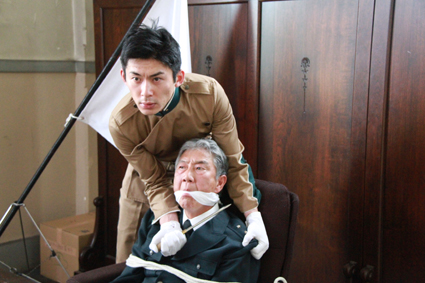
11.25 The Day He Chose His Own Fate, Koji Wakamatsu
“FOR ME, MAKING A FILM MEANS TO THROW A STONE AGAINST THE ESTABLISHMENT,” KOJI WAKAMATSU SAID IN ONE OF HIS LAST INTERVIEWS.
Wakamatsu kept on throwing stones to the end: in 2012 alone, he came out with three movies, which screened back to back at the Busan Film Festival where he was presented with the Asian Filmmaker of the Year award. Some two weeks later, he was dead, hit by a Tokyo cab while reportedly on his way home from a meeting about his latest project, an exposé of the nuclear industry in Japan.
A lifelong provocateur, Wakamatsu fought his battles from a strategic position away from the tides of cinematic fashion, somewhere between exploitation and the avant-garde. For many years his international cult reputation came from his notoriety as a maker of ‘pink’ films—low-budget items blending softcore sado-masochism and political subversion, such as Ecstasy of the Angels (1972) and Go Go Second Time Virgin (1969). In 2006 he returned to prominence with United Red Army, an epic, gruelling docudrama chronicling the self-destruction of an early 70s leftist group: a long-cherished project for Wakamatsu, and a summary of his complex relationship with the Japanese New Left.
The clash between ‘cool’ style and ‘hot’ subject-matter in Wakamatsu’s films creates an economical, unfussy beauty; the flat, desaturated digital look of his last films is as nonchalant and functional as was his use of high-contrast black-and-white film stock in the 1960s. Monomaniacal characters and flimsy storylines are typical of porn cinema, for obvious reasons—but Wakamatsu capitalises on the absurdity, with long periods of dead time broken up by offhand acts of cruelty, rape and murder. His brand of ‘poetic purity’ closely accords with Manny Farber's description of Sam Fuller's approach: “a merging of unlimited sadism, done candidly and in close-up, with stretches of pastoral nostalgia in which there are flickers of myth.” In other respects he's like a sleazy cousin of the French New Wave: the brilliantly minimal Serial Rapist (1978) has an affinity with Godard or even Bresson in its impassive performances, refusal of psychology and loopy gags (wandering by the river, the anti-hero comes across a woman painting a picture of a smokestack, screams “That isn't beautiful!” and shoots her dead).
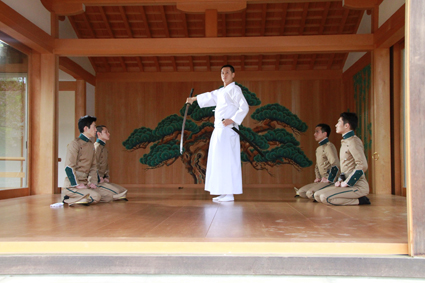
11.25 The Day He Chose His Own Fate, Koji Wakamatsu
Part of the fascination of Wakamatsu’s work springs from the ambiguity of his gaze: too intense to be taken for cool indifference, but typically (though not always) too detached to trigger either arousal or distress. In one of his most frequently repeated images, the camera looks down on a woman’s face contorted in undecidable pleasure or pain—suggesting a world of opaque surfaces, where violence is impelled by an ever thwarted desire to break through to hidden truth. Curiously, the same effect is produced by the monotonous dialogue exchanges that compose much of United Red Army, where student rebels argue relentlessly over a ‘correct’ political line. Through the endless repetition of self-justifying slogans (“Criticise yourself!”) speech too becomes a form of violence; equally, physical violence is understood as a cry that demands acknowledgement.
As with other very prolific directors—from Godard to Ruiz to Miike—Wakamatsu’s films often seem generated by the quasi-mechanical application of rules of thumb, which remain flexible enough to allow for any kind of casual inspiration. If none of the films screened at Busan quite rank with his best, taken as a group they give a sense of his range. 11.25 The Day Mishima Chose His Own Fate is an unorthodox biopic of the famous writer (played as a fragile dandy by Arata Iura) and a companion piece to United Red Army: the right-wing Mishima founded his own private militia in the 1960s to combat the radicals he saw as the chief threat to Japan. The link between his political philosophy and his troubled sexuality is treated obliquely, but the film makes plain that he, too, fiercely “criticised himself” for failing to live up to his own heroic conception of manhood.
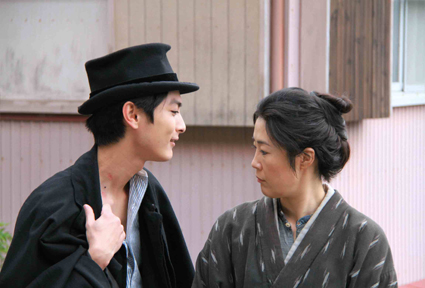
The Millennial Rapture, Koji Wakamatsu
Wakamatsu naturally gravitates toward obsessives, depicted with mingled mockery, horror and awe: it hardly matters if their beliefs are revolutionary, conservative, or merely deranged. “I wanted to burn like fire,” says one of the protagonists of The Millennial Rapture, a family saga set in a coastal village of Burakumin (untouchables). Told from the viewpoint of an aged, dying midwife (Terajima Shinobu)—in a surrealist touch, she addresses herself to a photograph of her late husband (Sano Shiro) who talks back as if from a video monitor—the film tells the story of a dynasty of hommes fatales, seducers doomed to bring ruin upon themselves and those around them. The uncanny quality of the narrative comes from its shifts of focus: as each good-looking young man comes to a bad end, another steps in to fill his place. It’s as if all male members of this family were interchangeable, vehicles for the impersonal destructive tendency transmitted from one generation to the next through ‘bad blood.’
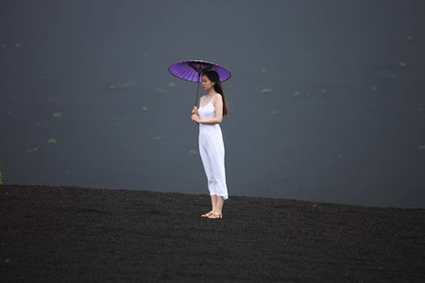
Petrel Hotel Blue, Koji Wakamatsu
Was this, for Wakamatsu, a metaphor for the curse of Japan? A vision of escape is briefly conjured in the dreamlike noir Petrel Hotel Blue, the last of the Busan films. Newly released from prison, an ex-con (Go Jibiki) finds solace in a hotel bar by the sea, where a mute woman (Hitomi Katayama) sits smoking like a living sculpture or a mirage. Gradually the crime plot is ‘deconstructed,’ as in the films of Alain Robbe-Grillet: stock genre elements are shuffled in a way that accentuates their banality, while the presence of magic is signalled by colours that leap off the screen (blue walls, a lilac parasol). But as the protagonist waits for his past to catch up with him, we know this strange idyll cannot endure. Whether the material he’s working with is documentary or fantasy (and perhaps he’d recognise no distinction) Wakamatsu’s pessimism is constant: ruled by forces larger than themselves, his characters can do little more than embrace their inevitable fate.
Busan Festival, Korea, Oct 3-12, 2012, http://www.biff.kr
Jake Wilson attended the Busan International Film Festival as a member of the FIPRESCI jury.
This article first appeared as part of RealTime's online e-dition Feb 6, 2013
RealTime issue #113 Feb-March 2013 pg. 19
© Jake Wilson; for permission to reproduce apply to realtime@realtimearts.net
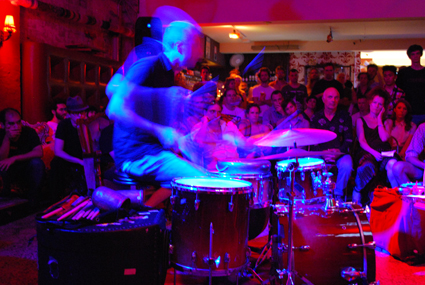
Simon Barker. The NOW now 2013
photo Jeremy Tatar
Simon Barker. The NOW now 2013
THERE WAS VERY QUIET MUSIC AND THERE WAS MUSIC THAT SAW THE AUDIENCE WITH THEIR FINGERS IN THEIR EARS; THERE WAS HECKLING AND THERE WERE WOOPS OF ENTHUSIASTIC APPLAUSE. SOME INSTRUMENTS WERE PLAYED BEAUTIFULLY, WHILE OTHERS WERE NOT PERFORMED ON IN ANY TRADITIONAL SENSE AT ALL.
At times kitchen utensils scratched and whirred against home-made instruments and tape measures reverberated against guitars; at others, pianos soared and drumsticks blurred. There were poems composed solely from guttural and other non-verbal noises and there was even a man dressed as a poo. And that is a snapshot of just two nights of this year’s festival of exploratory music.
Held over five nights in Marrickville’s beloved Red Rattler, NOW Now 2013 was programmed by Laura Altman, Sam Pettigrew, Rishin Singh, Andrew Brooks and Jeremy Tatar and marked the 11th year of what has become NSW’s premier festival for improvised music. In addition to the evening events, this year’s festival also ventured into the great outdoors with a concert at Gordon’s Bay and into the gallery with a visual arts show at SNO in Marrickville. The festival even embraced the foodie craze with an event hosted by Rosita Holmes and Rishin Singh pairing experimental music with experimental cuisine.
I attended two nights, Thursday and Friday, sadly missing a third because of ill-timed flu, and took in 12 acts which ran the gamut from shitcore to turntablism to drone, avant jazz to walls of guitar noise. Over those two evenings four startling and adventurous performances summarised the strengths of this year’s festival.
passenger of shit
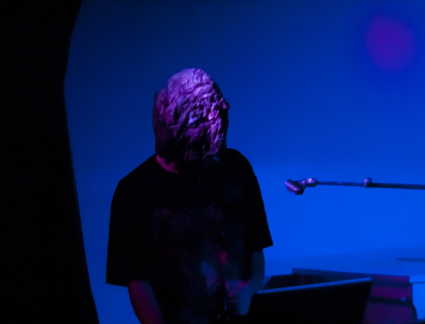
Passenger of Shit, The NOW now 2013
photo Jon Hunter
Passenger of Shit, The NOW now 2013
On Thursday night Passenger of Shit, known to his friends as Swift Treweeke, splattered onto the stage dressed in what could only be described as a mask of poo to deliver a laptop-driven set of uncompromising originality. Between samples decrying the state of women’s toilets and pleas for his mother to touch his anus, Treweeke screeched and screamed along to a pounding cacophony of throbbing bass lines, metallic riffs and drum runs reminiscent of a machine gun. Alternating between full throated guttural screams and howling alien shrieks, Treweeke’s set hit the audience like an axe, sending several punters rushing for the door, and many more reaching for their earplugs, or making do with fingers stuck in ears. He paused only to thread a beer under his mask. It was crazy horror-infused genre mash from hell, which even managed to inspire some dancing amid the carnage.
satsuki odamura & mayu kanamori
Treweeke’s was a hard act to follow, particularly given the number of fans he seemed to have among the audience, but the duo of Satsuki Odamura and Mayu Kanamori had very different, but no less mesmerising set of their own. Now an Australian resident, Odamura is a well-known exponent of the koto, and for this performance she played both koto and bass koto. Starting with softly plucked sounds and some whispered words from Kanamori, the performance moved into a duet incorporating live visual documentation and music as Kanamori picked up her camera to capture the beauty of both Odamura’s intricate and at times violent playing along with the form of the instrument itself, with the photos immediately projected behind the performance. It was a novel way of introducing the intricacies of koto and celebrating Odamura’s mastery. Gorgeous shots of moodily lit, quivering strings were interspersed with blurred images of fingers in rapid motion, offering intimacy with the performer we would not otherwise have had, as well as a thorough investigation of both the koto and the conventions of documenting performance. It even included a musical interpretation of cleaning up, with Odamura taking out a duster and a whisk to brush down her strings while Kanamori accompanied her with the sounds of her cleaning bellow blowing the dust from her camera lens.
phillippe petit
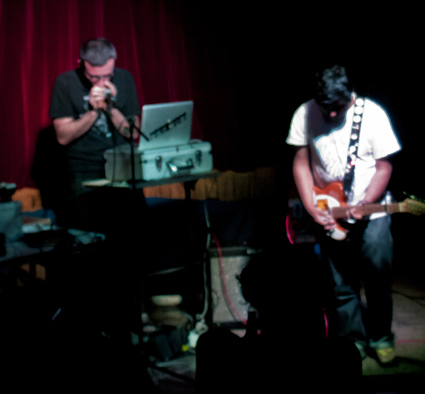
Phillippe Petit & Shoeb Ahmad, The NOW now 2013
photo Jon Hunter
Phillippe Petit & Shoeb Ahmad, The NOW now 2013
The lightning hands and unique approach of France’s Phillippe Petit provided another highlight. Petit performed on laptop and turntables presenting both a solo set and a duet with Canberra’s Shoeb Ahmad. Petit describes himself as a ’musical travel agent’ who aims to present a ‘psycho-film-noir ambience.’ At the NOW Now he decided to transport the audience to a land full of static and doom. Harsh digital noise, at times slowed down, at others forming a tumbling mass of glitch, provided a lurching, slurred backdrop before Petit cut to an almost chip-style section over which pulsed electric snaps and crackles.
Marking the first time the two had ever played together, the mood turned decidedly more spontaneous. Petit took to the decks, using his prepared vinyl, while Ahmad offered percussive guitar effects, along with longer drones before the pair crescendoed with Ahmad’s screaming guitar and Petit’s crazy fast vinyl looping and scratching. While Ahmad languidly worked his guitar, Petit resembled a manic cook in his kitchen. At times leaning in until his nose was almost against the vinyl, giving things a rub here and a dust off there, kneading, pulling and rolling his materials into shape to create a noisy, chaotic symphony from the most unlikely of sources.
simon barker & min young woo
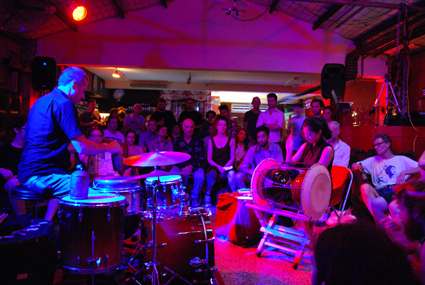
Simon Barker & Min Young Woo, The NOW now 2013
photo Jeremy Tatar
Simon Barker & Min Young Woo, The NOW now 2013
The final treat was provided on Friday evening by Sydney’s Simon Barker and South Korea’s Min Young Woo. The pair, also playing together for the first time, delivered a masterclass in drumming, a feast of amazing solos and inspired collaboration replete with whirring drumsticks and an unabashed joy in playing. At times crashingly loud, and others almost minimal, with a rare intensity Barker tapped out complex rhythms on all parts of his kit, which included a shaman gong and a larger gong called a jing, while Woo matched him on the changgu with intricate patterns and counter rhythms. Over 30 minutes the pair banged out a unique path, at times stopping to listen, at others rushing to join together, seeming to revel in each other’s playing, goading each other to play faster and yet always with feeling and commitment. According to Barker, it was a shared interest in Korean shamanic rhythmic language which saw the two artists cross paths. “The idea of the performance was to create a little platform for improvisation with a few key rhythmic motifs and melodic ideas. The melodic ideas were things that we let hover in our minds while we played, whilst the rhythmic motifs acted as prompts for a rhythmic conversation which was mostly based on a shared love of Korea’s east coast rhythmic languages,’’ Barker told me via email. It was a hot, hot room when the pair sat down to perform, but a lot warmer by the time they finished.
Other memorable moments included Amanda Stewart’s poetry which mixed spoken word with frenzied, non-verbal sonic onslaughts in stereo; Malaysian artist Goh Lee Kwang’s investigation of radio static; and a wonderfully intimate and understated late night performance by the Culture of Un (Chris Abrahams and Dave Brown) to launch their album Moonish.
Gloriously eclectic, this year’s NOW Now festival showed the event continues to offer musicians and audiences a way to re-discover the joy of the unusual and the unexpected.
The Now Now Festival, Jan 9-13, The Red Rattler and various venues; http://thenownow.net/the-now-now-festival-2013/
See also RealTime’s NOW now archive highlight featuring all our coverage of the festival from 2002 to the present
This article was originally published as part of RealTime’s online e-dition Feb 6, 2013
RealTime issue #113 Feb-March 2013 pg. 37
© Kate Carr; for permission to reproduce apply to realtime@realtimearts.net
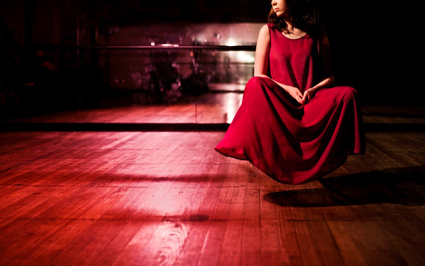
Thursday, Brink Productions & English Touring Theatre
image Slipperfish
Thursday, Brink Productions & English Touring Theatre
ON JULY 7, 2005, GILL HICKS, AN ADELAIDIAN LIVING IN LONDON, MADE A SERIES OF DECISIONS. SOME OF THESE WERE QUITE SMALL.
As the trains were late she decided to deviate from her normal routine and go to Kings Cross Station. When she got there, pushed to the back of crowd, she decided not to barge her way onto the first train but wait for the next. When that next train came she decided to get into the first carriage. Then, after a suicide bomber in the first carriage of the second train from Kings Cross detonated his device, Hicks made a very big decision: to survive.
Artistic director of Brink Productions, Chris Drummond, had seen an interview with Gill Hicks on Andrew Denton’s Enough Rope in 2007. She was the last survivor to be pulled from the carnage and lost both legs below the knee. Drummond had the beginnings of an idea for a new work, but he was holding off because he thought “It was too focussed on a place like London for a small Adelaide company to do with any authenticity.” Then, serendipitously, at the 2008 Performing Arts Market in Adelaide, he met Rachel Tackley the director of English Touring Theatre who was seeking an Australian company for a co-production. Drummond says, “There was just a real connection between Rachel and myself and between the producers, Kay Jamieson [Brink] and Jane Claire [ETT]. The four of us really had a shared sense of the theatre we wanted to make…We had this wonderful thing of an Adelaide company and a London company talking about an Adelaide woman in London.”
Thursday is a true co-production, split 50/50 between the two companies including cast and production creatives. The first development took place in London and the final rehearsals and premiere will be in Adelaide with the production programmed for the 2013 Adelaide Festival. The creative development in London brought together a devising team to explore possible theatrical imagery. Drummond says, “We are a text-based company but what we are trying to achieve is a highly theatrical work coming out of the text, so we usually start with a group of [devising] artists in the room. We didn’t know with this one whether we would follow the events that Gill had experienced or if we might go in a completely abstract direction.”
Bryony Lavery, known for her award winning plays Frozen and Stockholm, attended these devising sessions and then took 12 months to create the final script. Drummond is impressed by the way Lavery “carried through the sensibility from the first creative development. Because writers deal in character and story we sometimes lose some of the more interesting theatricality in the writing process. Bryony works with Frantic Assembly and lots of other physical theatre companies in the UK and has a real interest in and the capacity to keep the theatrical poetry quite open.” Rather than telling Hicks’ story in documentary form the play follows the stories of the eight characters who come into contact with the fictionalised central female character and focuses on what Hicks describes as both the worst and best of humanity coming together in a single moment.
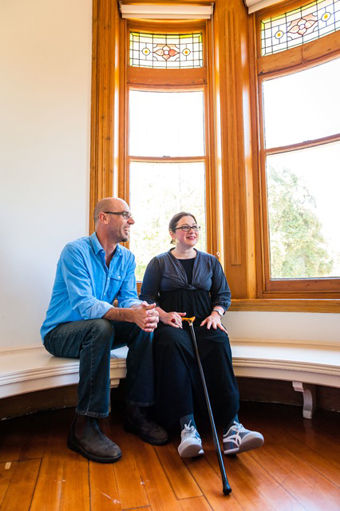
Chris Drummond, Gill HIcks, Thursday, Brink Productions and English Touring Theatre
photo Chris Herzfeld
Chris Drummond, Gill HIcks, Thursday, Brink Productions and English Touring Theatre
Drummond continues: “What has resulted on the floor is not a traditional play. It tells a really big story and it tells it in a really deep way through the characters, but you never have two characters talking in a living room or that kind of thing. It doesn’t work like that. It works much more as a rolling, choreographic, image-based work.”
Gill Hicks was in London when the team first met for the creative development and attended the first day of rehearsals, sharing her story with them. Since then Drummond has kept her informed of the progress. In a nice turn of fate, Gill Hicks has not been substantially involved in the latter phases of the project as she has just given birth to a baby girl (and, with apt synchronicity given the play’s subject, two of the original devising performers also became pregnant at the same time).
Three weeks into the final rehearsals, Drummond is “thrilled with how it’s feeling. Much of it actually incredibly playful and but then it goes into some pretty harrowing territory.”
After the Adelaide Festival premiere, Thursday will be presented in Canberra as part of the centenary celebrations. In 2014 the work will tour to England and Drummond has plans for Australia’s eastern states as well.
Adelaide Festival: Brink Productions & English Touring Theatre, Thursday, writer Bryony Lavery, director Chris Drummond, designer Dan Potra, composer/musician Quentin Grant, lighting designer Colin Grenfell, producers Kay Jamieson (Aus) and Jane Claire (UK), performers Paul Blackwell, Emma Handy, Martin Hutson, Lena Kaur, Tom Mothersdale, Kate Mulvany, Nathan O’Keefe, Deidre Rubenstein, Rochenda Sandall; Norwood Concert Hall, Feb 28-March 6; http://adelaidefestival.com.au; http://brinkproductions.com; http://www.ett.org.uk/
RealTime issue #112 Dec-Jan 2012 pg. web
© Gail Priest; for permission to reproduce apply to realtime@realtimearts.net
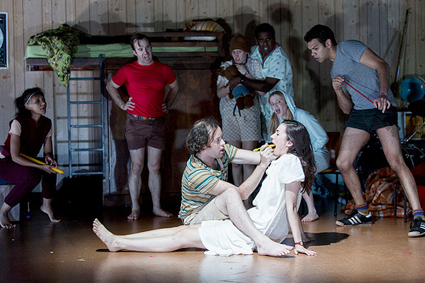
Front: Gareth Davies & Geraldine Hakewill; Back Paula Arundell, John Leary, Megan Holloway, Jimi Bani, Harriet Dyer & Meyne Wyatt, Peter Pan, Belvoir
photo Brett Boardman
Front: Gareth Davies & Geraldine Hakewill; Back Paula Arundell, John Leary, Megan Holloway, Jimi Bani, Harriet Dyer & Meyne Wyatt, Peter Pan, Belvoir
IN A NUMBER OF SYDNEY FESTIVAL PRODUCTIONS I FELT CONSISTENTLY FACED WITH THE ISSUE OF LOSS: OF CHILDHOOD, ADOLESCENCE, PARENTS AND LOSS OF MEMORIES AND RATIONALITY. PUPPETRY, STAGE EFFECTS, MUSIC, ANIMATION, RITUAL AND MOVEMENT MANIFESTED IN VARIOUS PERMUTATIONS IN THESE PRODUCTIONS MAKING FOR RICH AND DIVERSE THEATRICALITY. ONE THING THAT HAS NOT BEEN LOST IN CONTEMPORARY THEATRE IS A SENSE OF TRADITION AND CRAFT. THE PAST HAS NOT BEEN LOST. IN THESE WORKS, PEOPLE ARE OFTEN LOST IN ORDER TO FIND THEMSELVES.
peter pan
Belvoir takes children’s play as a creative template for this fun-filled, endlessly inventive Peter Pan in an adaptation by Tommy Murphy based on the 1904 pantomime rather than later, denser versions and their musings on childhood. It’s a brisk 90-minute production deftly directed by Ralph Myers and designed by Robert Cousins. As you’d expect of Belvoir there’s a strong sense of domesticity (will the cast for Neil Armfield’s Ring Cycle for Opera Australia be fitted out in t-shirts and thongs in a school hall setting?) creatively exploited to the max while still hovering somewhere between Edwardian England and now.
In an adroit move, the production never has to leave the children’s bedroom since their play has the capacity to transform everyday clothing, furniture, objects and rituals into an imaginative wonderland. A painted cardboard box worn like a helmet becomes the snapping jaws of a crocodile, the fairy Tinkerbell manifests as flickering table and bed lamps, and an uncooperative shadow is playfully childlike (the flying however is less inventively realised and gotten out of the way promptly). All that’s needed to create mermaids and seals are scuba-diving flippers; a cupboard stacked with other furniture becomes a ship or an island; an umbrella handle is Hook’s hook. The imagination has taken over by engaging with and manipulating the things of the world, rather than leaving them behind, say, for an animator’s spectacular fantasia.
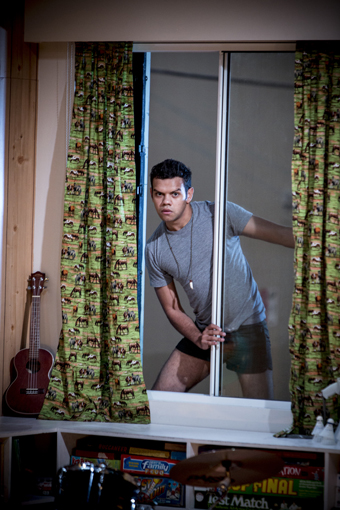
Meyne Wyatt, Peter Pan, Belvoir
photo Brett Boardman
Meyne Wyatt, Peter Pan, Belvoir
Meyne Wyatt as Peter Pan (a role traditionally allocated to adult actresses) vividly conveys the ultra-confidence of the young alpha-male but also the pain of the eternal youth and the wounding—desertion—it embodies. On the edge of adolescence and bitter, unable to forgive the mother who apparently abandoned him, Wyatt’s Pan is certainly not a child, nor will he ever become an adult, refusing to grow up and enter the world of relationships and parenting. The other boys, clearly children still, simply miss their mothers (no lost girls, it seems, in Edwardian England).
Peter and Wendy are the only characters who are solely themselves; in this bedroom-cum-Neverland, everything is transformable, making the ambiguities of traditional role doublings even more meaningful, representing the kinds of distortion, condensation and slippage that occur in dreams, as delineated by Freud in the same era as Barrie’s making of Peter Pan.
Charlie Garber doubles well as a very funny, nervous Hook and a weak-willed but sensitive Mr Darling so that there’s some emotional bleed between the characters.
In a dextrous ensemble that includes Gareth Davies, Megan Holloway and John Leary, Harriet Dyer is hilarious as both twins as well as playing four or five other characters. Jimi Bana reveals a fine comic sensibility after playing many serious roles on television, such as Eddie Mabo in Mabo. Paula Arundell gently captures Mrs Darling’s sense of anxiety about the outside world but also her wisdom. Geraldine Hakewell’s Wendy is genteel relative to Peter, whose first appearance in a window overlooking the streets of Redfern outside the Belvoir theatre suggests a street kid.
The ending, where Wendy, now a mother, allows her barely pre-adolescent daughter (an eager if spikey one who will not spring clean for Peter and the boys and appears unlikely to play mother), feels increasingly uncomfortable as the decades past. What precisely did Wendy’s adventure with Peter do for her? Intimate the possibility of romance while unleashing her imagination at the moment when it was likely to be crushed by the weight of domesticity and marriage? Or did it offer a lesson in how to deal with a man who will never grow up; perhaps all men, and that these boy-men have to be lived with and loved? For Barrie, Wendy’s victory is that she actually grows up, while Peter cannot. Peter Pan remains very much of its own period, offering a certain timelessness in the exultation of play as felt in this Belvoir production, admirably of the kind children might actually make.
school dance
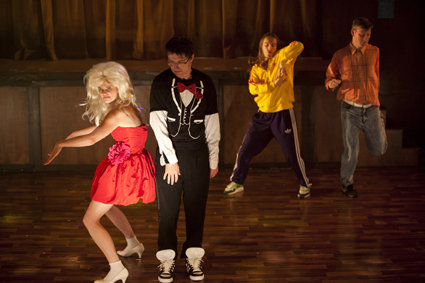
Amber McMahon, Matthew Whittet, Luke Smiles, Jonathon Oxlade, School Dance
photo Lisa Tomasetti
Amber McMahon, Matthew Whittet, Luke Smiles, Jonathon Oxlade, School Dance
The lost boys in Matthew Whittet’s School Dance for this Windmill/Sydney Theatre Company production are a trio of mid-adolescents, collectively out of kilter with a pressurised social world and each facing their own crisis. None of them is a Peter Pan, but they are, to varying degrees, wounded: one of them feeling invisible, one brutalised by his father, the other making the right moves, but never connecting. Together they fear the school bully, a muscular brute who emerges like a demon from the toilet as if from a hell hole in a mediaeval mystery play. They need a Wendy, especially when Matthew’s condition (Whittet uses the male actors’ names) becomes actually invisible and finds himself in a fantasy world of eternally invisible, fellow adolescents—ghostly, animated figures drifting through a forest projected on the school hall stage, and one very real girl who has surrendered to her belief in her own invisibility.
These boys don’t need a Wendy-mother, but someone who will rescue Matthew. She takes the form of a schoolyard enabler who subsequently transforms into a unicorn and draws Matthew’s mates into the quest—Luke (Luke Smiles) as an action character, Jonathan (Jonathan Oxlade) as a giant Telebubbie. In the process, Matthew rescues the lost girl and discovers romance: in the end the couple happily dance together with all of Matthew’s twitchy moves.
Whittet has deftly collaged a multitude of fairytale, game and quest motifs and tropes in order to create a hyper-charged, comic narrative about the drawbacks of adolescence and the need to face up to them alone and together. Set in an immaculately realised school hall (designer Jonathan Oxlade) with toilets either side representing ‘interior’ spaces of male and female fear and anxiety while the understage provides a rack of BMXs on which the boys momentarily escape the intimidating school dance. Amber McMahon, embodying ‘the female,’ convincingly switches roles from schoolgirls to unicorn to invisible girl (and other roles) with incredible pace adding to the sense of the potential for transformation. Other tight cueing comes in the form of beeped-out swearing, some wild dancing and Whittet having to double as the ‘invisible’ girl in the hall toilet before she actually disappears. The small ensemble of players delivers a virtuosic performance which engaged the almost totally adult audience with whom I saw School Dance—the pop culture that Whittet grew up with in the 80s is densely referenced and easily recognised. It would be interesting to see what an audience of 14-16 year-olds would make of it (many of the cultural icons persist, though a Nora Ephron reference might not connect). My only misgiving was a not-so-funny voiceover (MacMahon again, this time as an interfering narrator) which is given a laboured postmodern treatment.
While Peter Pan’s lost boys have been discarded by their mothers, the School Dance trio is largely lost to fumbling adolescent inadequacies (albeit socially punished ones), but it’s intriguing that, like Pan, they look to the feminine for rescue. But Whittet, a century on, allows for lost girls, and for the lost to be found. And it’s play that is key to rescue, although a scene in which the invisible Whittet and McMahon characters huddle under a large storybook mushroom reminds us that adolescent anxieties can be regressive. Perhaps regression is, at times, restorative if you’re looking to find yourself.
it’s dark outside
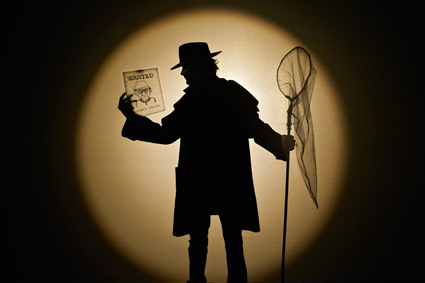
Tim Watts, It’s Dark Outside, Perth Theatre Company
photo Richard Jefferson
Tim Watts, It’s Dark Outside, Perth Theatre Company
In contrast to the losses and gains of childhood and adolescence in Peter Pan and School Dance, It’s Dark Outside ventures lightly into the grim world of memory loss occasioned by dementia in old age, suggesting that while rationality suffers, the imagination might play a sustaining role—again embodied in playfulness.
From the makers of the much praised The Adventures of Alvin Sputnik: Deep Sea Explorer, It’s Dark Outside is another work rich in invention with its mix of performer, puppets of varying scale (operated by Tim Watts and Chris Isaacs largely in Bunraku style), large animated projections, shadow play and some fine cotton wool puppetry conveying clouds of thought. A slow old man is on the loose (though we’re not told from what), pursued by a spooky shadow man with a large butterfly net through a forest of red-eyed trees and across cowboy movie plains. In the cold of night a tiny tent appears, dancing like a friendly puppy one moment, a fine high stepping horse the next, the old man riding it past buttes and cacti.
His plight is sensitively handled. The expression “a head full of cotton wool” suggests fuzzy headedness but here, floating out of the old man’s head, it represents thoughts and memories that are being lost, drifting away or caught in his pursuer’s net. Some memories are momentarily retained, the clouds taking shape as a lively, fond puppy until the old man fumbles, knocking off its head—like a memory that’s fragile and vulnerable.
Expertly blending stillness and small movements, including those of a flexible mask, Arielle Gray superbly realises the old man, giving him quiet dignity and determination even as his escape into fantasy threatens to dissolve. The makers of It’s Dark Outside offer a gently if intense account of the subjective experience of Sundown Syndrome—when dementia sufferers wander away from home at twilight. Although this account can only be a fantasy version of something likely to be much more anxious—a physical search for what’s been lost—it nonetheless encourages empathy in its audience and exalts the power of the imagination, an issue addressed in enlightened treatments of dementia using music and art.
As Astrid Frances reported in her review (RT110) the sustained approach to the cloud-thought imagery finally feels over-determined; the drama of pursuit gives way to a more contemplative, if lovingly realised, exploration of the workings of the imagination, depriving the work of drive and muting the initial sense of suspense. But there’s much to enjoy in It’s Dark Outside (director Melissa Cantwell), the skill of its puppeteering in particular and Gray’s subtle performance as the old man realise a substantial sense of interiority, making a simple fable emotionally complex.
masi
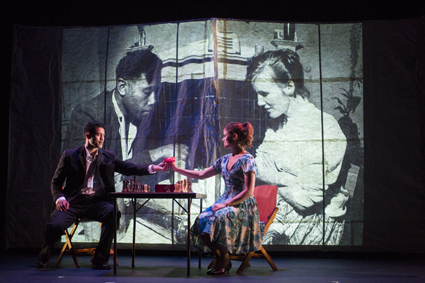
Masi, The Conch Theatre
photo Jamie Williams
Masi, The Conch Theatre
A work about loss from a New Zealand Pacific theatre company, The Conch Theatre’s MASI [NZ, UK, Fiji] is a melancholy reverie about deceased parents in which the mixed cultural heritage of the couple (a Fijian high chief and a Cambridge educated schoolmistress in 1950s New Zealand) is celebrated with projected archival images, beautiful traditional music and Masi weaving. The approach is however unremittingly sombre, right from the start with its piano and cello musings, and impressionistic—we learn very little about the parents. Consequently, for all the poetry of its projections, movement, deployment of materials and the power of the imagery of weaving (a superb example forming the 13-metre arch of the proscenium) Masi felt intensely private.
the moment I saw you I knew I could love you
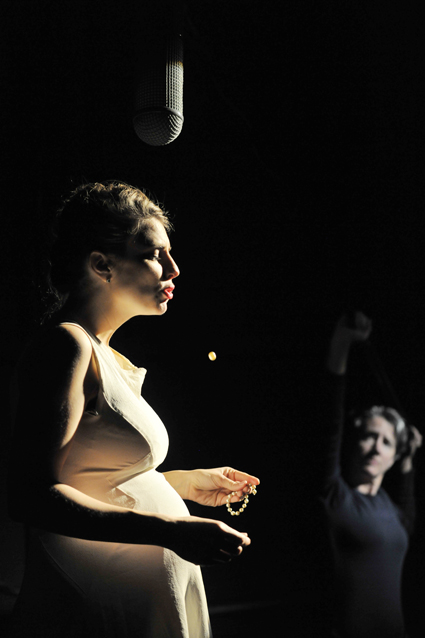
The moment I saw you I knew I could love you, Curious UK
photo Hugo Glendinning
The moment I saw you I knew I could love you, Curious UK
This time it’s the audience that’s lost. Seated in three inflatable lifeboats, we’re addressed by three performers of the UK’s Curious who sometimes sit with us, adrift in a “churning ocean…a metaphor for the turbulent range of human emotions” (program note). There’s very little churning; rather, we float through moods generated by lectures about the physiology of fear and our blood cells that turn lyrical (“love the shape of your organs”), advice on how to prepare yourself for trauma, a tale of man who brought himself a new pair of Adidas because he didn’t want to look foolish after suiciding, and a woman’s recollection of gagging at a wedding when having to make a speech she didn’t want to deliver. Woven through crises of odd and involuntary behaviour are films of an older man and a woman, dancing first by themselves on a beachfront walkway and then together. In the last passage of the performance they appear onstage and the audience too is invited to dance—like the couple in the film, each with an apple held brow to brow. While enjoying The Moment… from moment to moment, the sense of whimsical free association made for a rather abstract experience, a floating world of evocation but also of loose connections. I admired the performances, especially Claudia Barton’s intense monologues, but never felt that I was “in the belly of the whale” (program).
the rape of lucrece
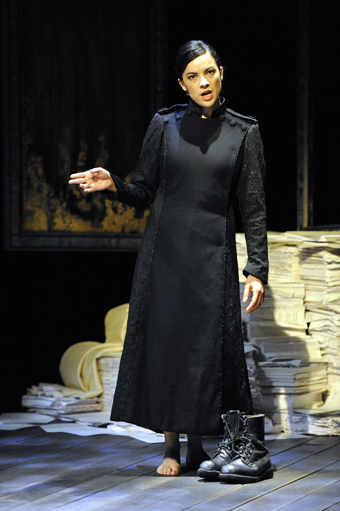
Camille O’Sullivan, Rape of Lucrece
photo Keith Pattison
Camille O’Sullivan, Rape of Lucrece
I admired Camille O’Sullivan’s delivery of Shakespeare’s verse in The Royal Shakespeare Company’s The Rape of Lucrece, but was appalled by the banality of the songs and the performer’s overacting in those moments when she had to step outside the invaluable constraints of the poetry. The dramaturgy of the design was also poor—great piles of manuscript with which the performer engaged only once (she tossed them around of course), the blunt symbolism of the deployment of a lone female shoe and a male boot, and a series of modernist paintings as background that merely changed hue and texture according to the lighting which otherwise functionally carved corridors of light across the floor. Initially looking like a chunkily suited modern nun, Sullivan later reveals, underneath, the gown in which she will be raped. The sound was likewise problematic. The verse sounded fine from the head-miked Camille, but as soon as she sang the volume was intolerably ramped up for bland anthemic songs. The editing of the poem for the stage was reasonably well done, but where was Lucrece’s verbal defence of herself in the face of Tarquin’s onslaught? As for the rape, instead of making the most of the poetry, Sullivan writhed on the floor, howling, melodramatically undercutting the power of her performance. The loss? Ours, Lucrece’s and Shakespeare’s.
sacre—the rite of spring
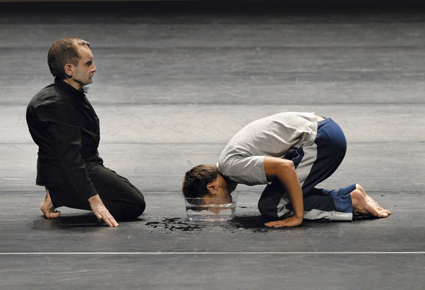
Raimund Hoghe, Lorenzo de Brabandere, The Rite of Spring
photo Rosa-Frank.com
Raimund Hoghe, Lorenzo de Brabandere, The Rite of Spring
In the largest Carriageworks theatre, Raimund Hoghe and Lorenzo De Brabandere move about the vast space at walking pace in neat geometric patterns, accelerating, slowing, intersecting, passing, coming face to face, separating. De Brabandere races across the floor, Hogue emphatically drags an ungainly leg. At the same time two musicians perform Stravinsky’s The Rite of Spring on grand pianos far upstage, evoking the furious richness of movement that was Nijinky’s choreography in 1913 for the Ballet Russes. But in this neat ritual there is no dancerliness; the focus instead is unrevealingly on two very different bodies. Sacre seems to have dated badly since offering a strong conceptual challenge to contemporary dance in the early 2000s, part of an anti-dance trend that emerged in the mid 1990s .
ligeti morphed
One of Ensemble Offspring’s greatest strengths is the way they encourage us to not lose touch with the great music of the second half of the 20th century. The best thing about their Ligeti Morphed was the relatively un-morphed acoustic works, Ligeti’s Piano Etude#2 “Cordes Vides” (scored for marimba, vibraphone and two violins by Bree Van Reyk) and Continuum (two marimba version) played by Van Reyk and Claire Edwardes. The lyrical etude rolls out in gentle if ever escalating tides that pause or retreat, with waves of strings and percussion crisscrossing. Continuum, as played by Reyk and Edwardes, is supple and athletic, exploiting the full tonal range of the instruments and at its fastest and highest, on both marimbas at once, magically evoking electronics. The electro-acoustic works, with Oren Ambarchi on electronic guitar and Martin Ng on turnables are enigmatic, partly because it’s not visually clear what sounds are coming from Ng, especially, and Ambarchi. I close my eyes. As in the etude, if much more dramatically, there are waves of sound in After Atmospheres (after Ligeti’s most famous work, Atmospheres, 1961), a collaborative creation between Ensemble Offspring, Ng and Ambarchi. In one of the most striking passages, high whining violins soar with near feedback electronics against trembling cymbals until vanquished by thunderous drumming. This engaging work includes a rip-roaring Le Grande Macabre style section, side by side with Atmospheres-type sustained ambience. As a totality however, appreciation will doubtless come with listening to After Atmospheres, and the other electro-acoustic works in the program, on the projected studio recording CD.
murder
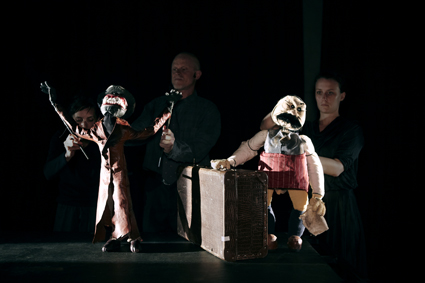
Murder, Erth
photo Susannah Wembley
Murder, Erth
Erth’s Murder had an abundance of talent and promise but, after connecting strongly with its inspiration, the Nick Cave and the Bad Seeds’ album Murder Ballads in a grimly comic realisation of “Stagger Lee,” it drifted away into its own complicated narrative (in which a song as powerful as “Red Right Hand” is reduced to background noise) albeit with flashes of inspiration and a strong central performance from Graeme Rhodes. This is another production about loss, this time a loss of rationality and an inexorable descent into murder.
Rhodes commences with a dull and surely disposable lecture on the history of murder from ancient times to the present, perhaps trying to get it into some kind of rational perspective, but before long he’s revealed to be a fantasist (images from his psyche filling a large backdrop) increasingly enmeshed in the psychosexual attractions of murder (including via computer games) and eventually forming a murderous partnership with a woman via an online chatroom. Rather than being a free agent exploring murder and its meanings, by the end he is manipulated by puppeteers as if in the grip of desires beyond his control. Signs of this are evident early, although difficult to track subsequently, when the narrator tells us that his mother was murdered when he was six and, therefore, the God who allowed this must be a murderer. A child puppet then appears to represents the narrator. This trajectory is not altogether clear but what is finally evident is that this man’s desire is not simply murder for the sake of it, but for revenge. The target’s visage, a spider-legged head, multiplies across the screen, amplifying our protagonist’s obsessiveness. However, the means of telling—life-size puppets and miniatures, a multitude of projections—make for a congested multimedia experience, especially when the script is already complicated. More overkill than murder. In its embrace of murder actual and virtual from from ancient tragedy to computer gaming and serial murderers and even euthanasia, Murder sustains a high level of bigger-than-life grossness with killings, cocksucking, torture (with a drill) and suffocation by cunnilingus. It rates as less an investigation of our murderous impulses than a celebration of their variety and appalling ingenuity—a funny and appalling reminder, as if we needed one, of the loss of rationality, empathy and civility that confronts us in the daily news. At best, with its fine puppeteering, like a horror film it makes evil laughable.
2013 Sydney Festival: Belvoir, Peter Pan, by JM Barrie, adaptation Tommy Murphy, director Ralph Myers, performers [see review], design Robert Cousins, costumes Alice Babidge, lighting Damien Cooper, composer Stefan Gregory, Belvoir St Theatre, from Jan 9; Sydney Theatre Co presents Windmill Theatre’s School Dance, writer Matthew Whittet, director Rosemary Myers, performers [see review] with Jack Wetere, designer Jonathan Oxlade, soundtrack Luke Smiles, lighting Richard Vabre, choreographer Gabrielle Nankivell, animation Chris Moore, STC wharf 1, from Jan 11; Perth Theatre Company, It’s Dark Outside, creators Tim Watts, Arielle Gray, Chris Isaacs, music Rachael Dease, Carriageworks, Jan 11-15; Curious UK, The moment I saw you I knew I could love you, Helen Paris, Leslie Hill, Claudia Barton, Carriageworks, Jan 11-13; The Conch Theatre (NZ, Fiji, UK), Masi, director Nina Nawalowalo, co-director Tom McCory, illusion designer Paul Kieve, composer Gareth Farr, Seymour Centre, Jan 20-25; Royal Shakespeare, The Rape of Lucrece, writer William Shakespeare, adaptation Eliza Freestone (director), Feargal Murray (composer), Camille O’Sullivan (performer, composer), design Lily Arnold, lighting Vince Herbert, Seymour Centre, Jan 22-25; Ensemble Offspring, Ligeti Morphed, violins Veronique Serret, Anna McMichael, percussion Claire Edwardes, Bree van Reyk, turntables Martin Ng, Electronic guitar Oren Ambarchi, Carriageworks, Jan 11-13; Sacre—The Rite of Spring, concept Raimund Hoghe, choreography & dance Raimund Hoghe , Lorenzo De Brabandere, pianos Guy Vandromme, Alain Franco, Carriageworks, Jan 5-8; Erth, murder, concept, direction Scott Wright, writer Raimondo Cortese, performers Graeme Rhodes, Rod Primrose, Michelle Robin Anderson, Gavin Clarke, Katina Olsen, design Steve Howarth and Erth Studio, sound, lighting design Phil Downing, choreography Kate Champion, puppetry director Rod Primrose, Seymour Centre, Sydney, Jan 5-19
RealTime issue #113 Feb-March 2013 pg. web
© Keith Gallasch; for permission to reproduce apply to realtime@realtimearts.net










































 Applauded at film festivals and widely seen on television, this documentary on one of the most dedicated and enduring performance artists of the last 30 years, Marina Abramovic, The Artist is Present is an engrossing, sometimes perplexing and moving film. It documents the preparations for and the exhibiting of a retrospective and a new performance by Abramovic at New York’s MoMA in 2010. Virginia Baxter writes, “In 106 minutes Akers and Dupré expose for the viewer something of the emotional, physical and intellectual demands inherent in mounting an exhibition and performance that deal in the power of the present. In the process they also offer insight into the life’s work of a remarkable artist” (see
Applauded at film festivals and widely seen on television, this documentary on one of the most dedicated and enduring performance artists of the last 30 years, Marina Abramovic, The Artist is Present is an engrossing, sometimes perplexing and moving film. It documents the preparations for and the exhibiting of a retrospective and a new performance by Abramovic at New York’s MoMA in 2010. Virginia Baxter writes, “In 106 minutes Akers and Dupré expose for the viewer something of the emotional, physical and intellectual demands inherent in mounting an exhibition and performance that deal in the power of the present. In the process they also offer insight into the life’s work of a remarkable artist” (see  Creative Minds is a six-part Madman/SBS series of interviews with artists Bill Henson, Kate Grenville, Robyn Archer, Elena Kats-Chernin, Stephen Page and Geoffrey Rush. In-depth interviews with Australian artists are a rarity, and these have the benefit of excellent supporting footage, for example photographer Henson working on his moodily expressive night-time landscapes. Director Robin Hughes’ quietly phrased and sometimes probing questions yield insights into the creative mind. RT
Creative Minds is a six-part Madman/SBS series of interviews with artists Bill Henson, Kate Grenville, Robyn Archer, Elena Kats-Chernin, Stephen Page and Geoffrey Rush. In-depth interviews with Australian artists are a rarity, and these have the benefit of excellent supporting footage, for example photographer Henson working on his moodily expressive night-time landscapes. Director Robin Hughes’ quietly phrased and sometimes probing questions yield insights into the creative mind. RT





































































